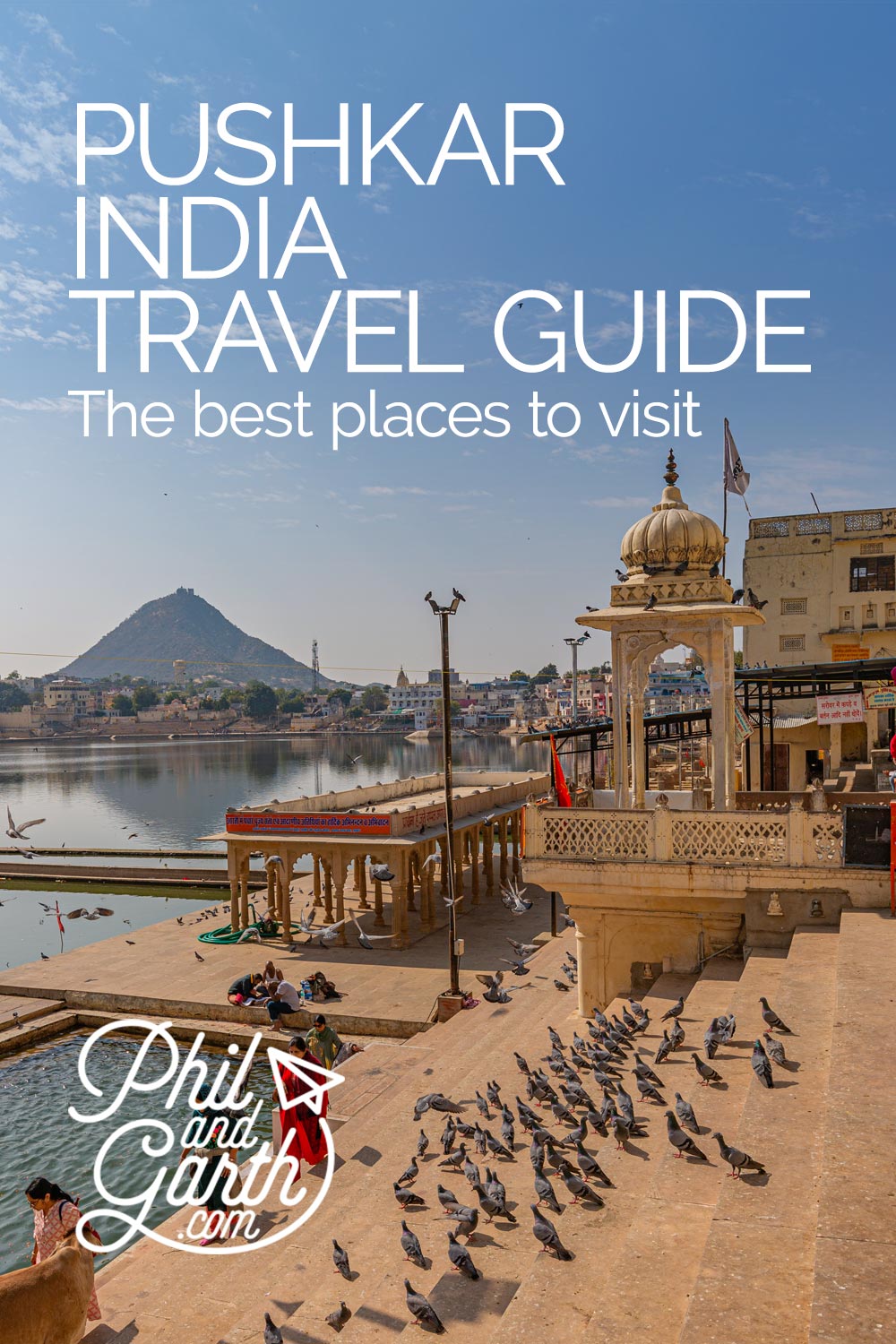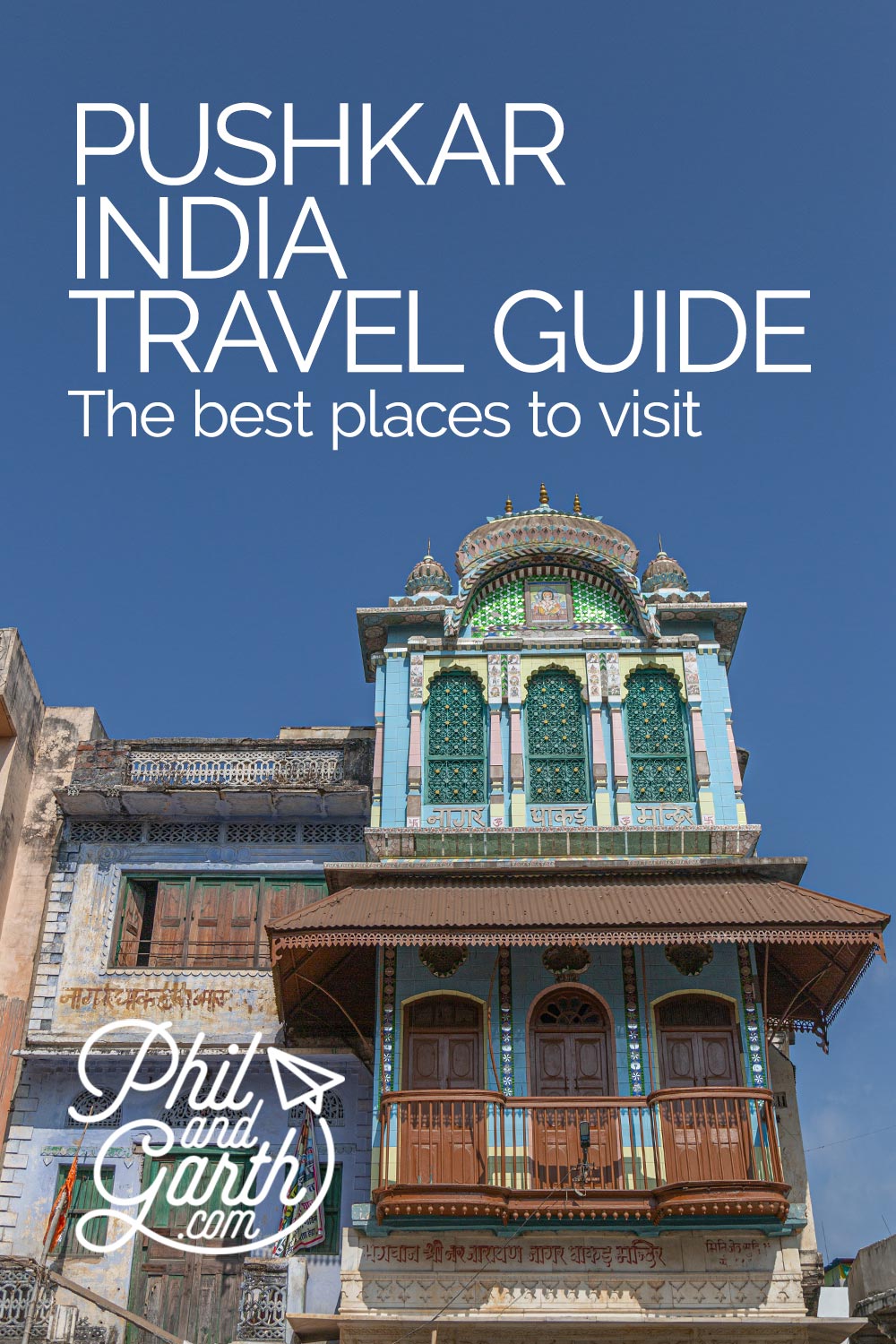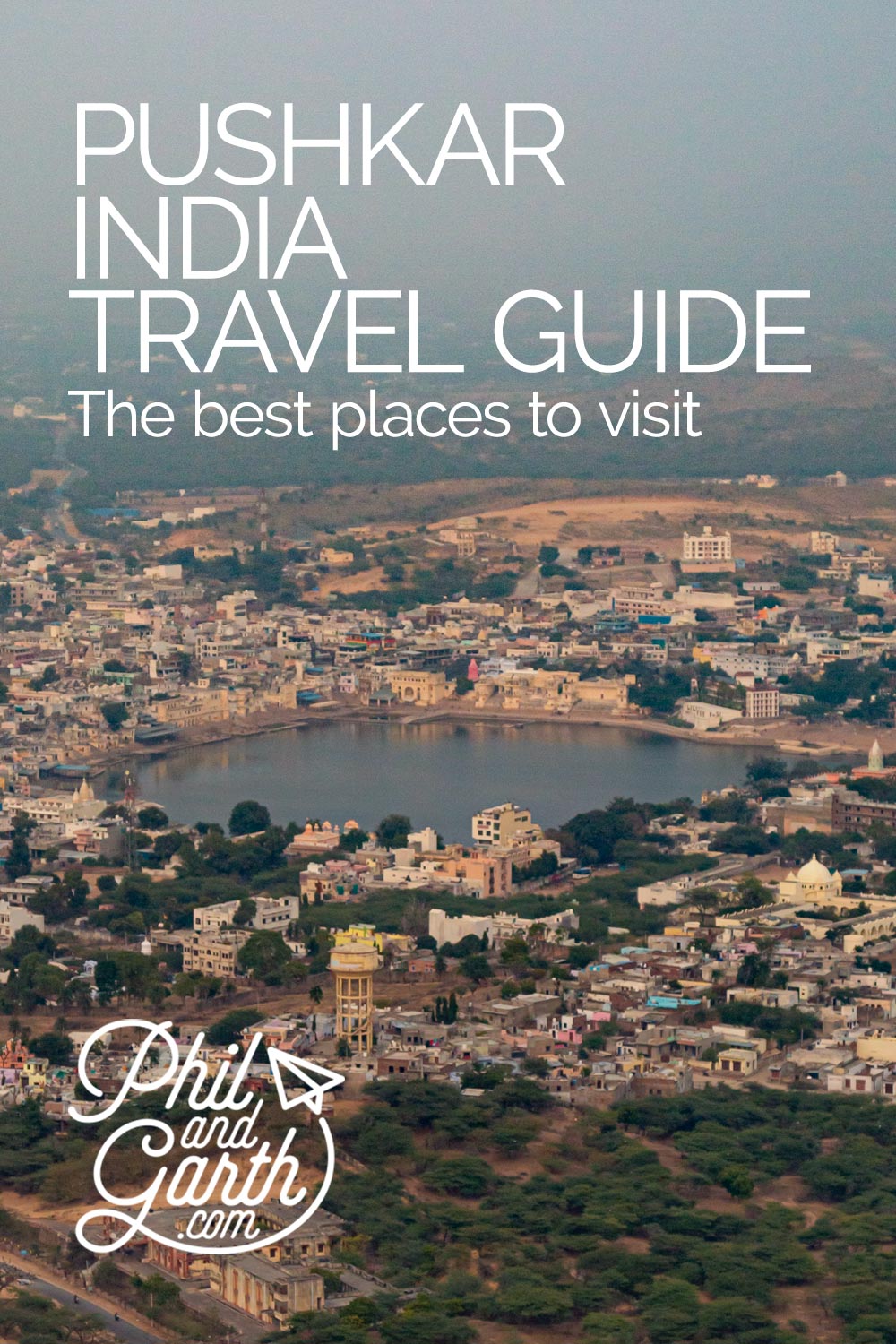Last updated: 24th February 2024
Our small group tour of India continued from Udaipur to Pushkar. We caught an AC chair class train from Udaipur to Amjer train station. Then took a 20 minute bus transfer over the mountain roads to Pushkar. In this travel guide to Pushkar we’ll show the best attractions and the best places to visit – basically all the best things to do in Pushkar if you’re staying for a couple of nights like we did.
Table of Contents
Pushkar – A Place of Pilgrimage
Pushkar is a small sleepy and spiritual town in the middle of the Ajmer desert in the state of Rajasthan. Famous for its sacred Pushkar Lake and the world’s biggest camel fair. We thought Pushkar had a chilled out vibe with its hippie foreigners and the air filled with the smell of incense (and weed at times) it reminded us of Goa. It’s a paradise for veggies as Pushkar is officially meat, egg and alcohol free. It’s more touristy than other Indian cities we visited, but we still found it relaxing and the shopping opportunities here are great. The town is not massive and is really easy to explore on foot.
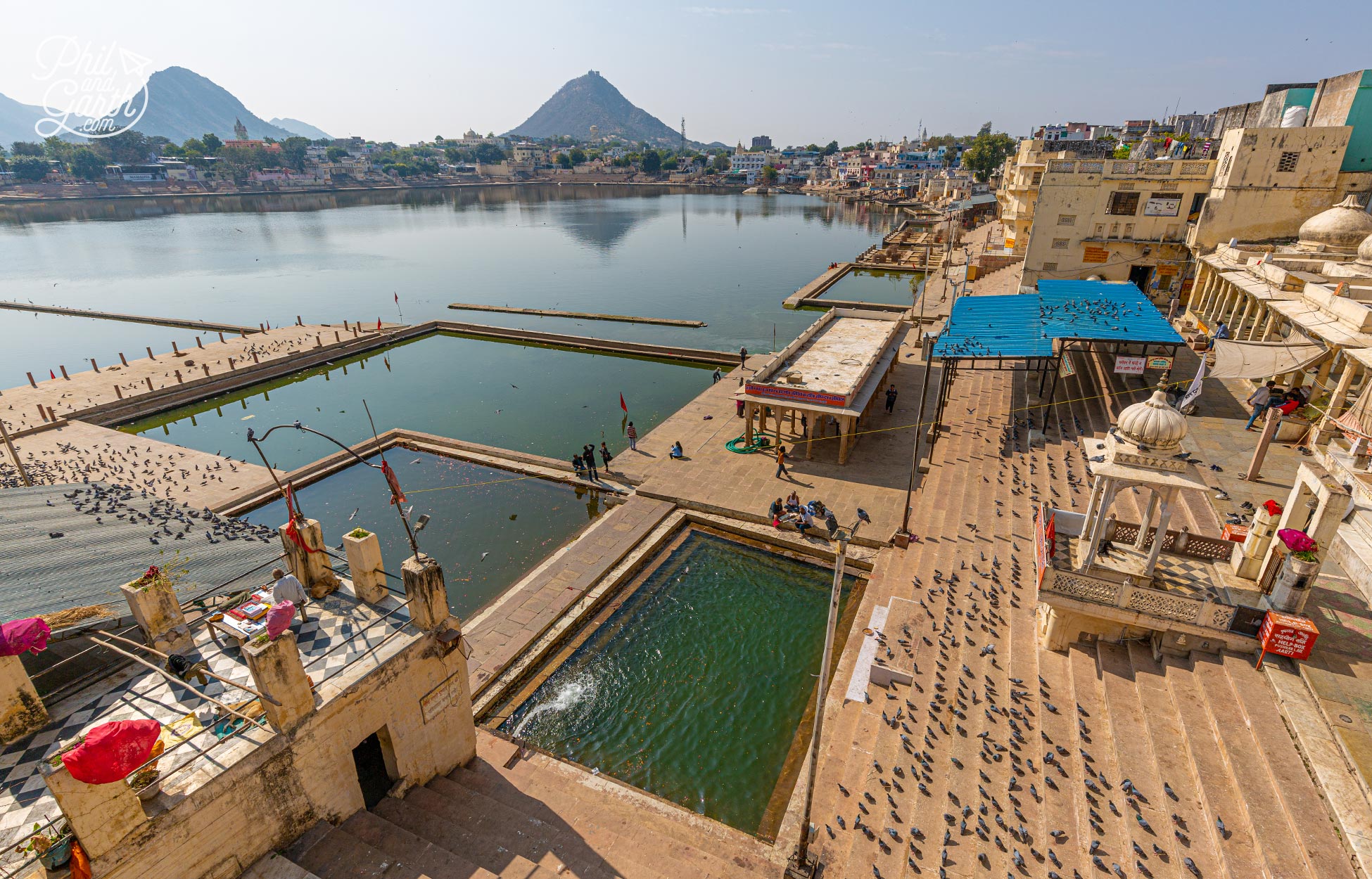
Hindus and Sikhs consider Pushkar Lake to be sacred
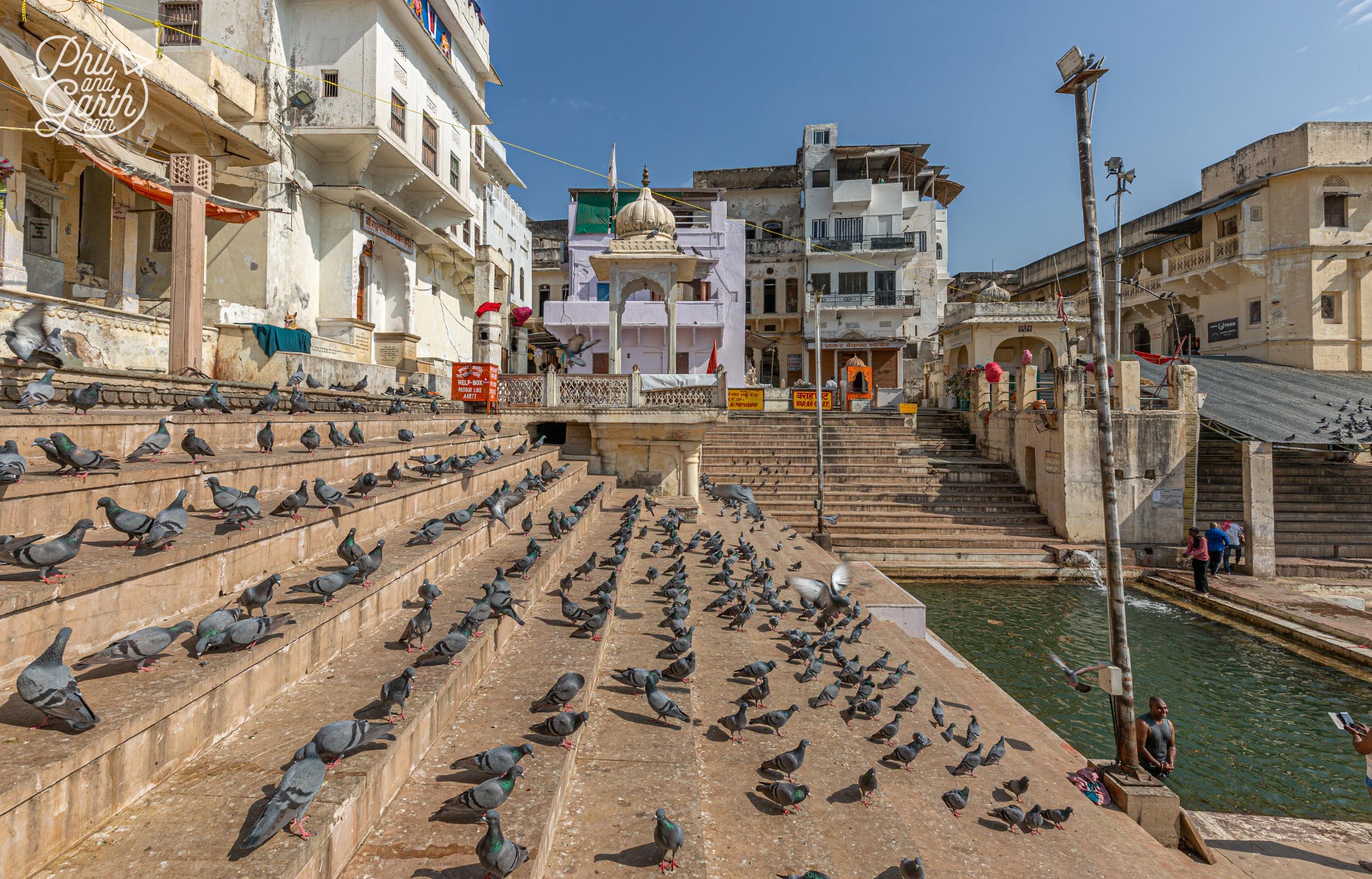
Just one of the many ghats (steps) in Pushkar
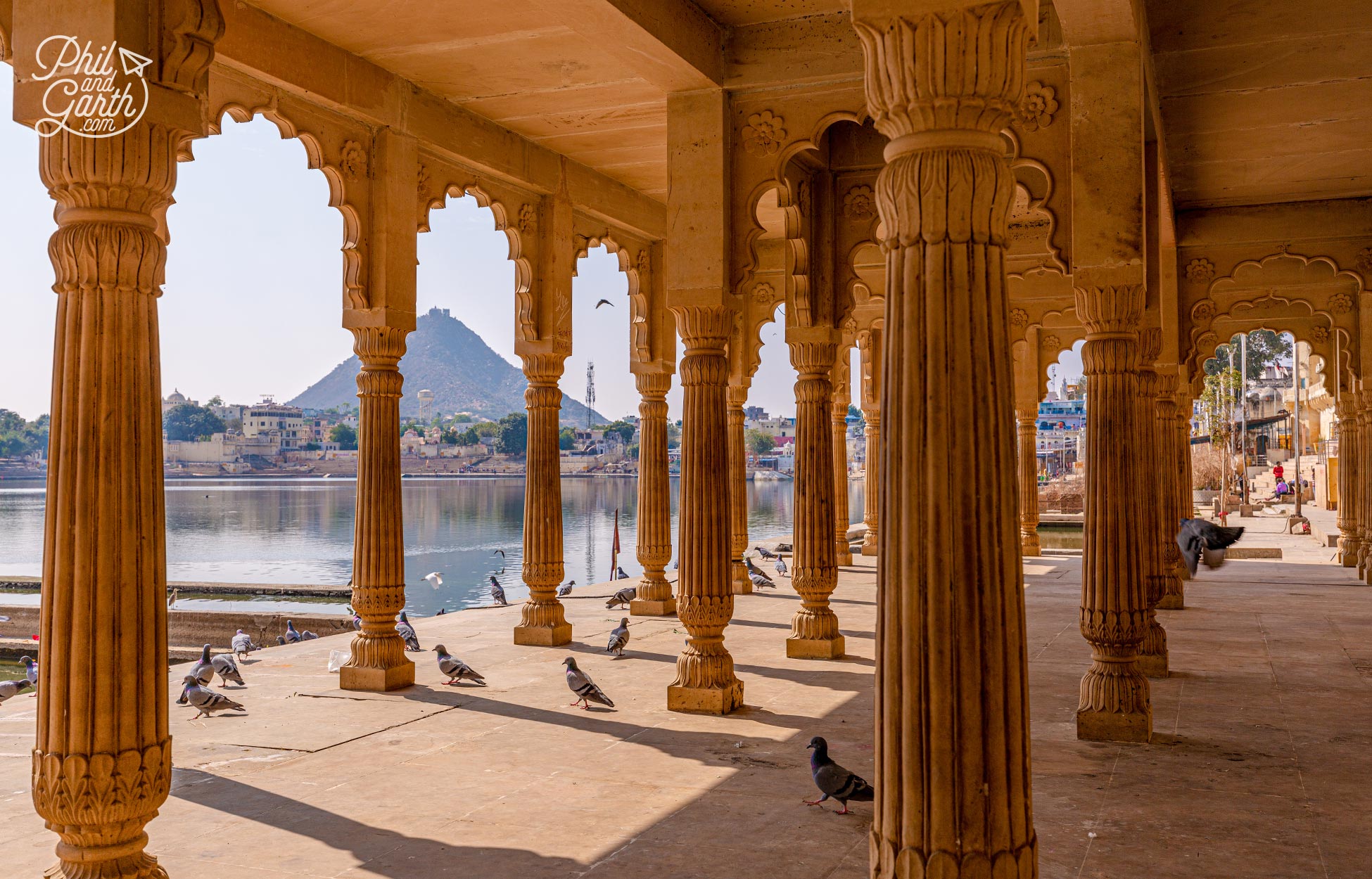
Photographers will love all the opportunities in Pushkar
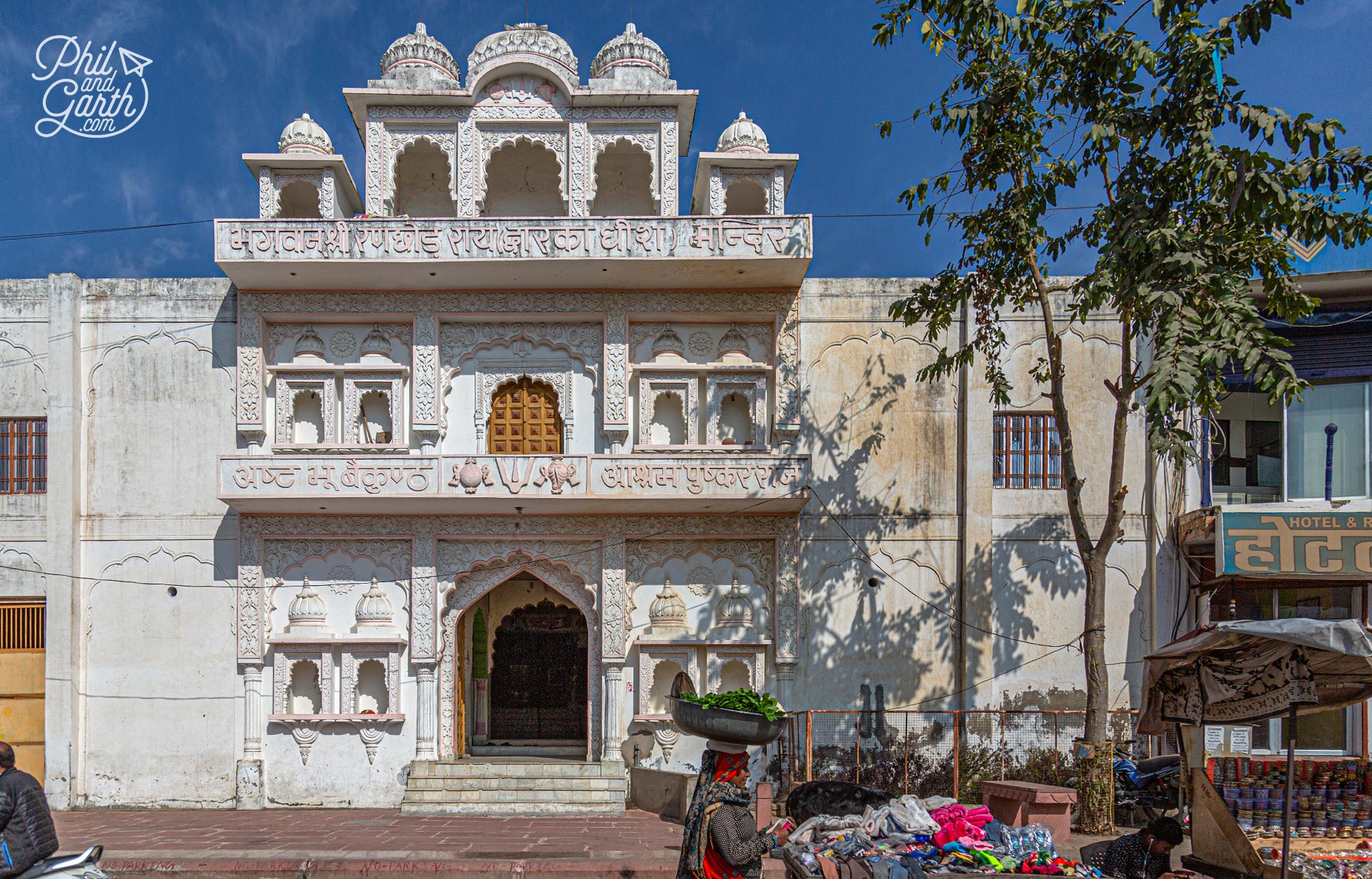
A lovely pastel coloured building
Sacred Pushkar Lake
Pushkar Lake is considered one of the holiest lakes in India by Hindus and Sikhs. The lake is surrounded by around 500 small temples, 52 ghats (steps) and havelis (old merchant houses). Legend says it was magically formed by the Hindu god Lord Brahma who dropped a lotus flower on the ground to kill a demon and a lake was formed out of the desert.
Every year during ‘Kartika’ – the Hindu full moon month in October and November, Hindu and Sikh pilgrims come from across India to bathe in the holy water to purify themselves, cure diseases and cleanse their souls. At night hundreds of oil lamps placed on leaves and floated in the lake. We were visiting Pushkar in January so we missed the religious fair.
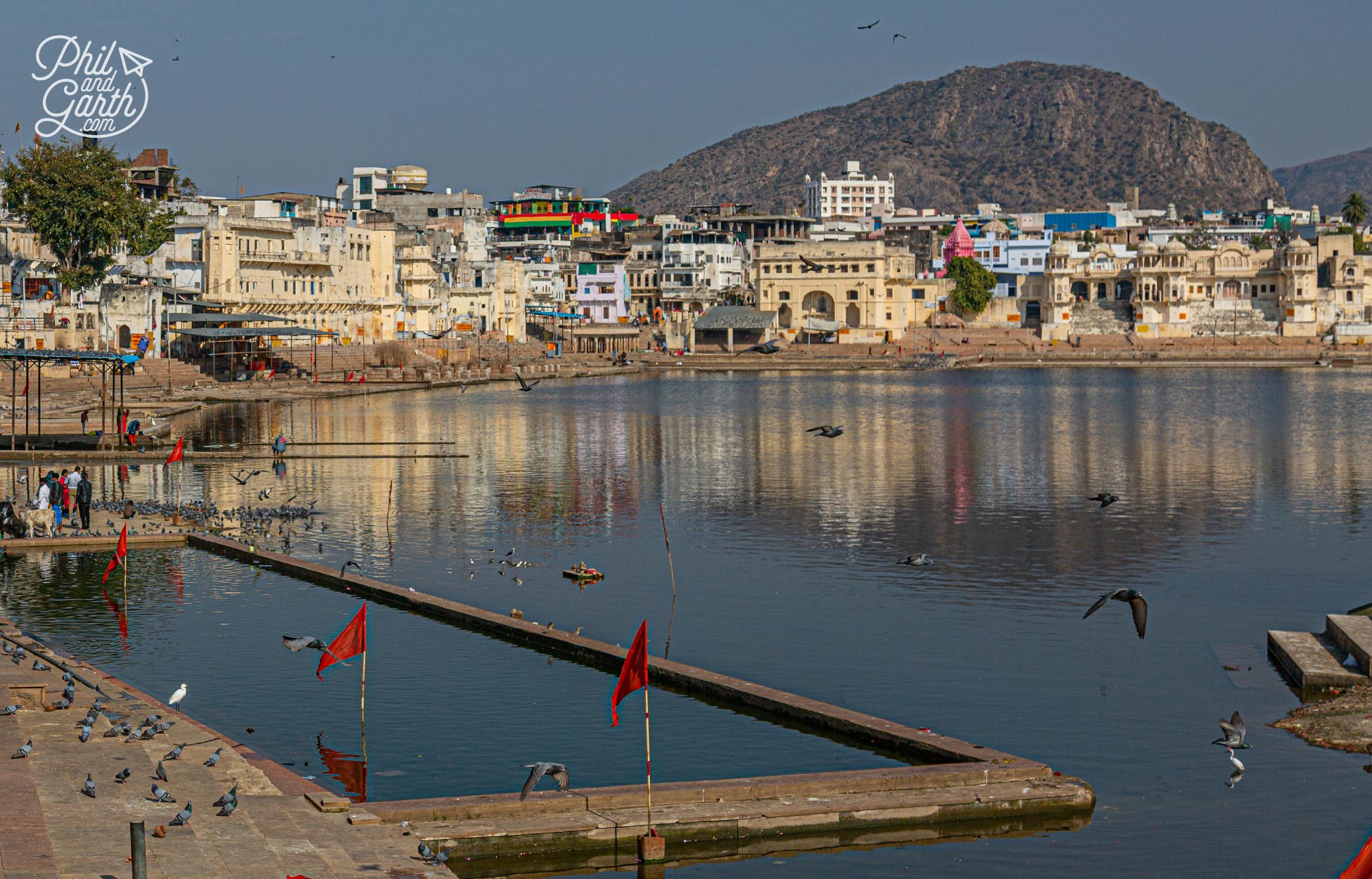
Pushkar Lake with the Aravali Mountains in the background
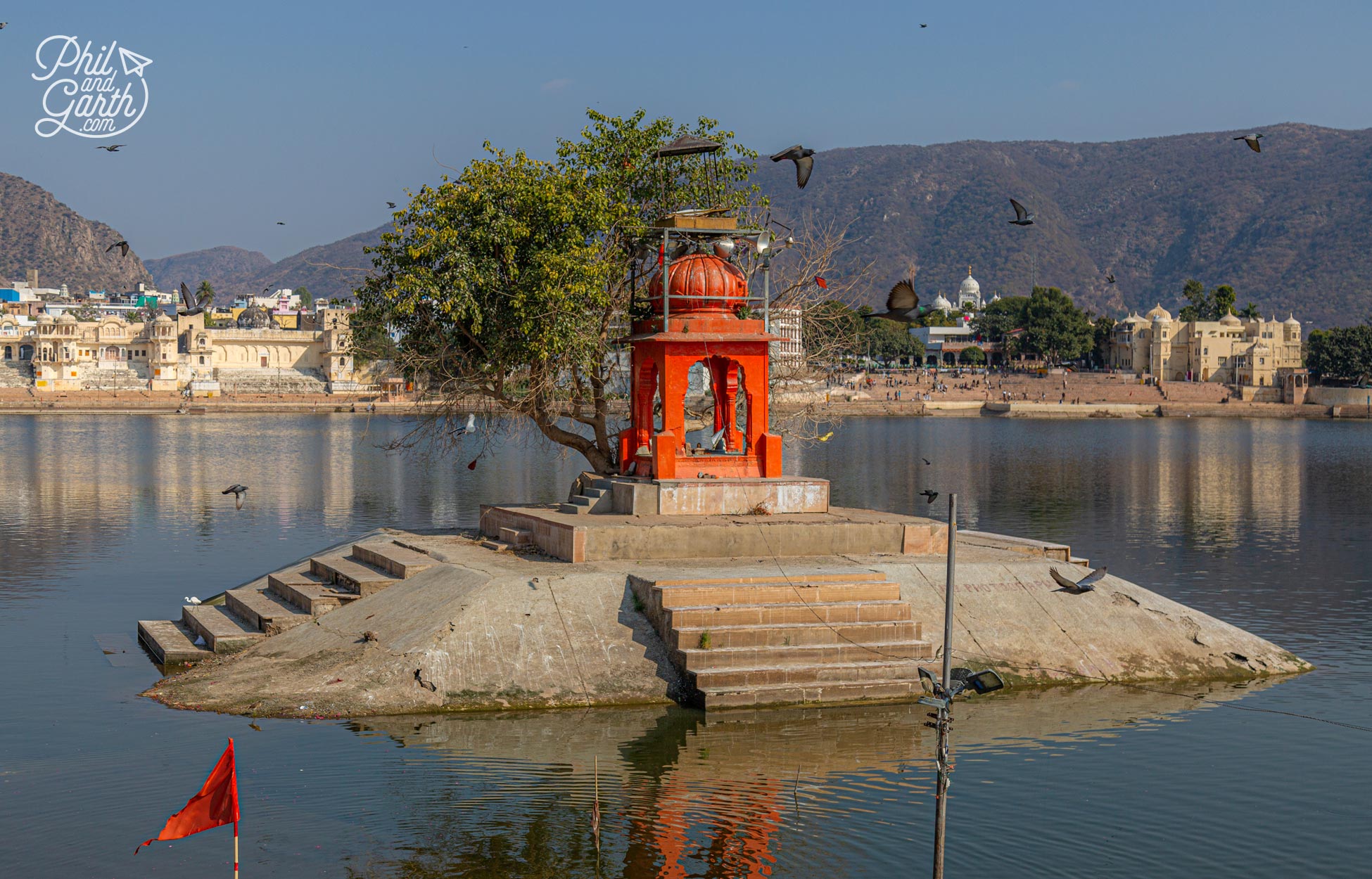
There’s a small island in the middle of lake with an altar carved in white marble
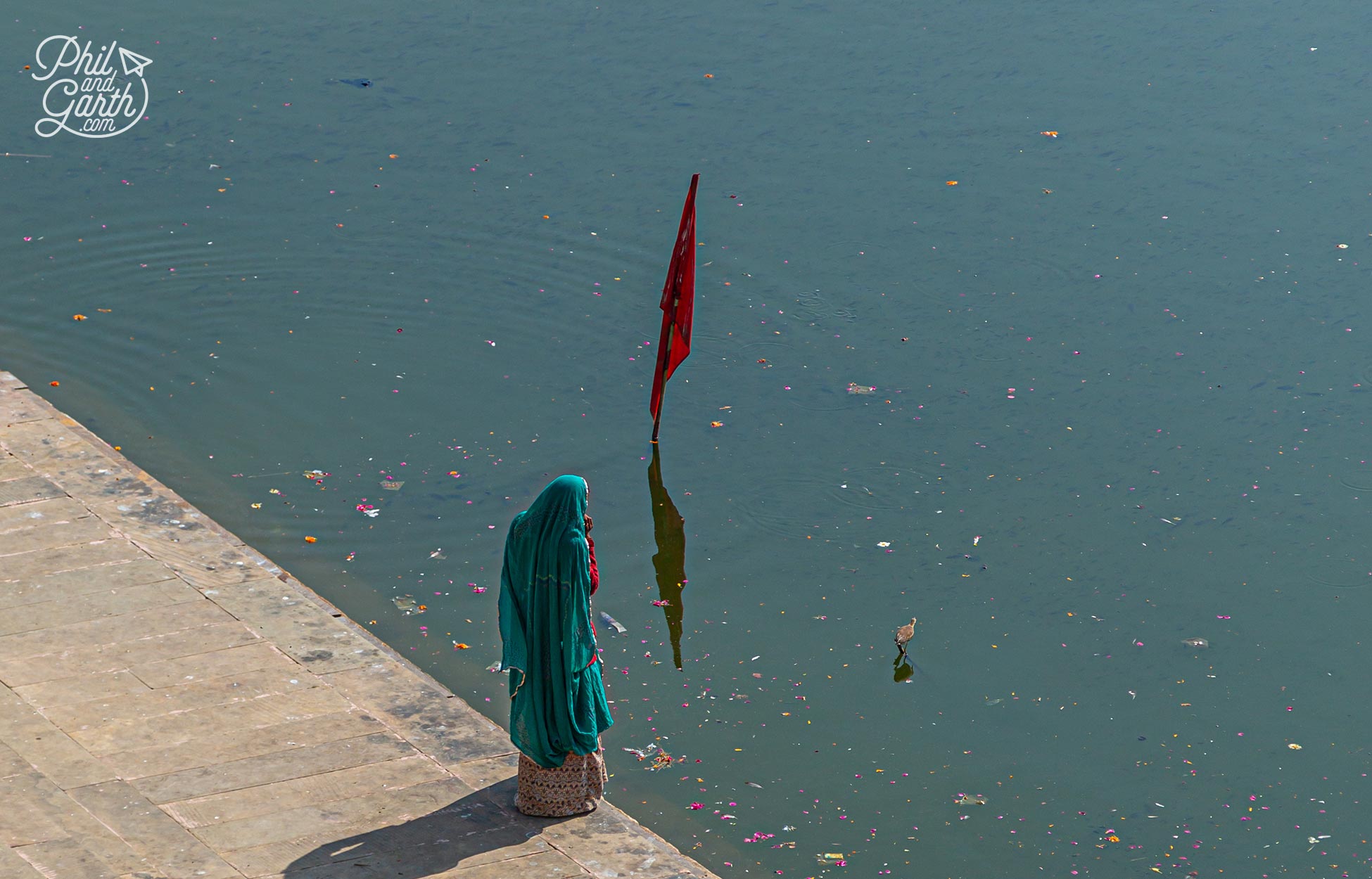
The lake is full of rose petals from the puja ceremonies that take place by the water
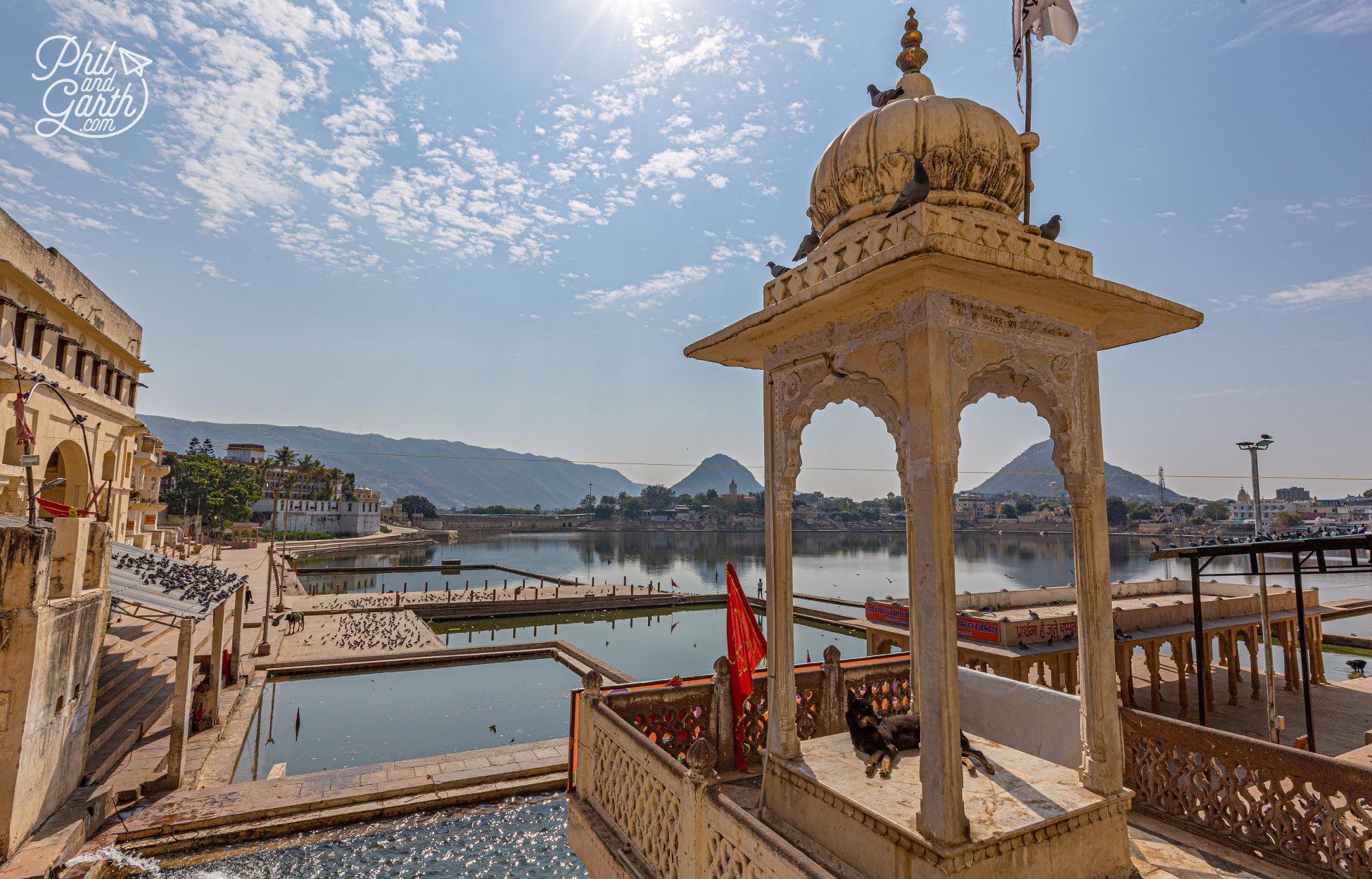
Hundreds of Hindu and Sikh pilgrims from across India come to purify themselves in the holy water
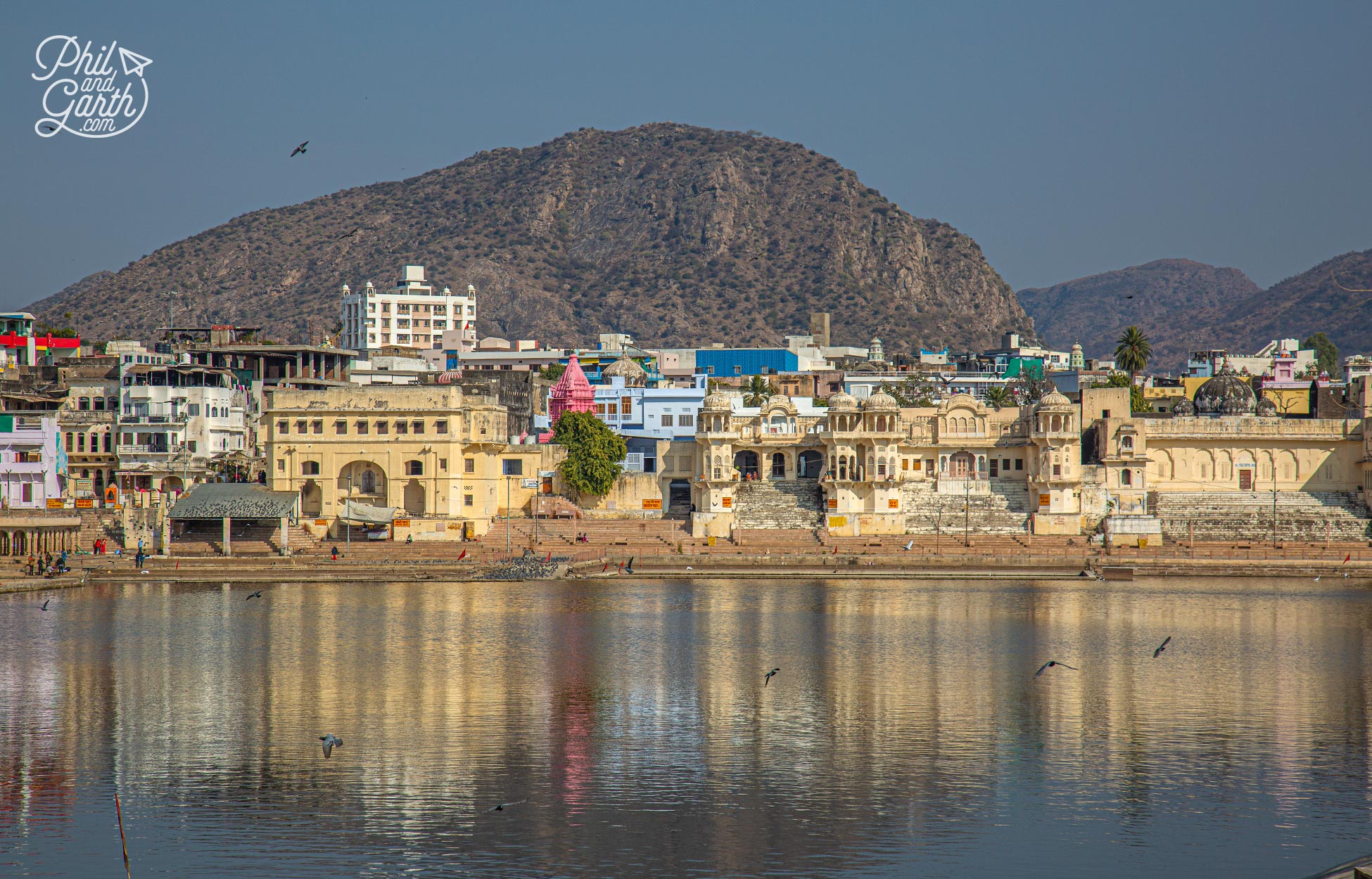
There are over 500 small temples surrounding Pushkar Lake. Some made of white marble or painted blue
Bathing Ghats
Surrounding Pushkar Lake are 52 bathing ghats (steps) where you must behave respectfully and take off your shoes when walking on them. Signs everywhere say “no photos” however our local guide, Pema said photography is allowed but do not take any photographs of people bathing on the ghats or in the water. Foreign tourists are not allowed to go into the water of the lake.
Gau Ghat is one of the best places to visit in Pushkar. It is the most famous ghat, also known as ‘Gandhi Ghat’ because it’s where Mahatma Gandhi’s ashes were scattered in 1948 after his assassination. It’s also one of the best places to watch the sunset over Pushkar. We started at Gau Ghat and then continued walking around the whole lake, up and down all the different ghats. We enjoyed soaking up the atmosphere – watching the bathing rituals and locals washing their clothes. However the water looks a bit grim up close – it’s dirty and stagnant full of green algae, however, it doesn’t smell.
A few people stopped us asking for a photo to be taken with them – a very common occurrence in India, we got used to striking a pose. During the day it was really warm (especially for us Brits), we thought it was funny because the locals thought it was freezing wearing lots of layers, jackets, jumpers and woolly hats. To be fair it was very cold in the evenings.
Every evening at 5.40pm is the religious Aarti ceremony performed at the Varah Ghat. It’s an experience worth seeing – chants and prayers are accompanied by fire, bells and drums.
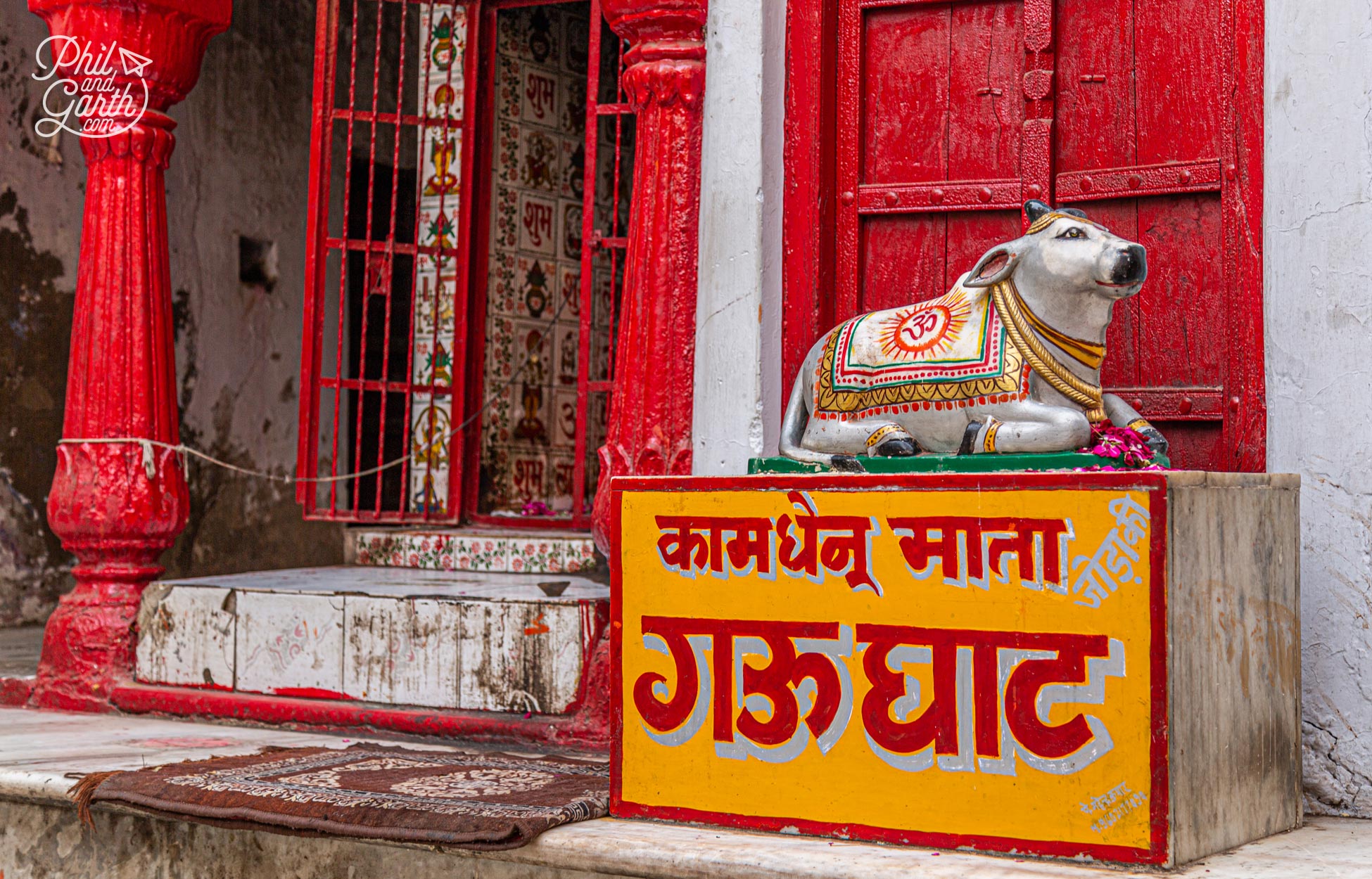
The ‘mother of all cows’ welcomes you to the Kamdhenu Mata Gau Ghat. Also known as the Gandhi Ghat
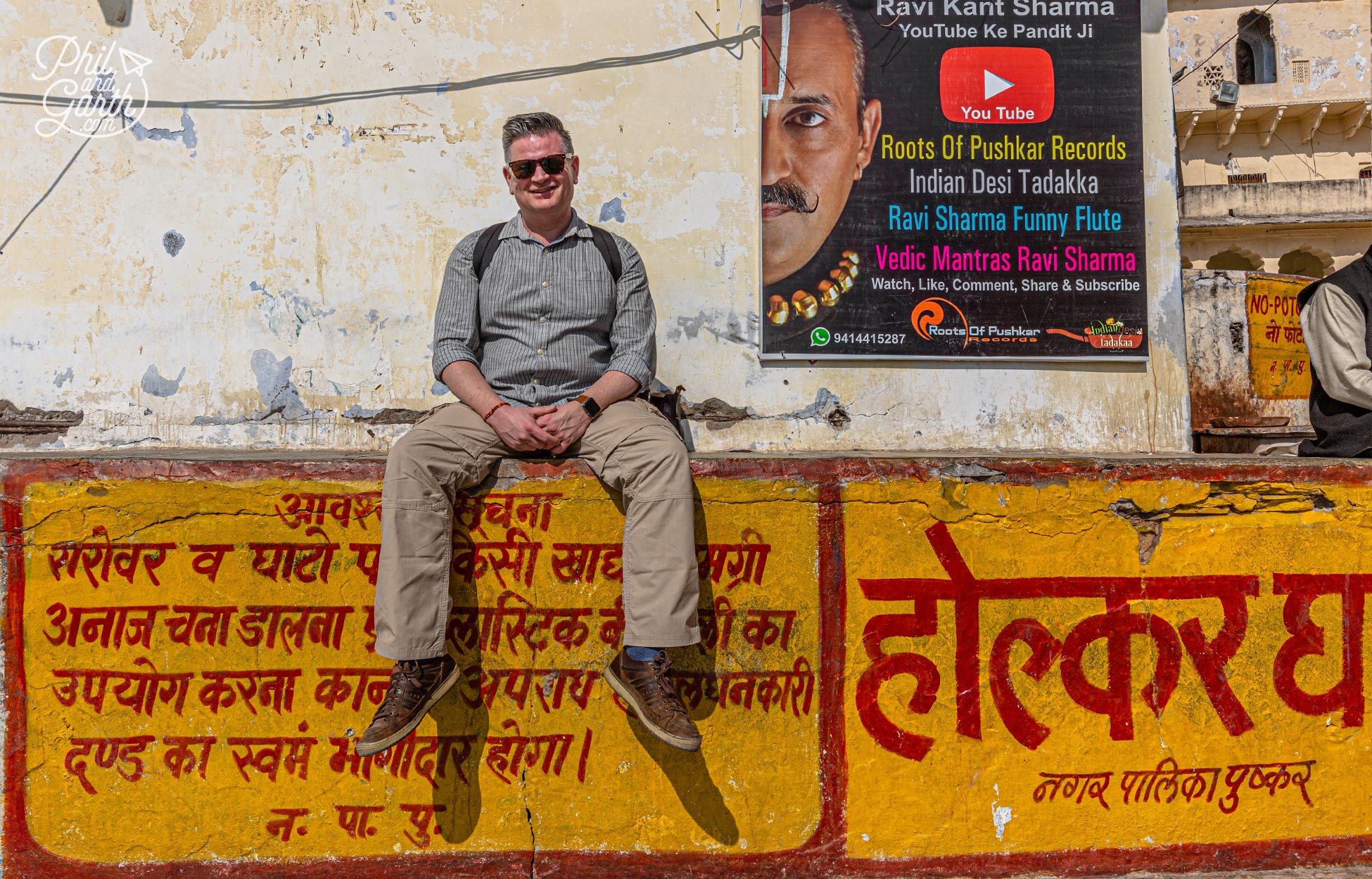
Phil at Holkar Ghat
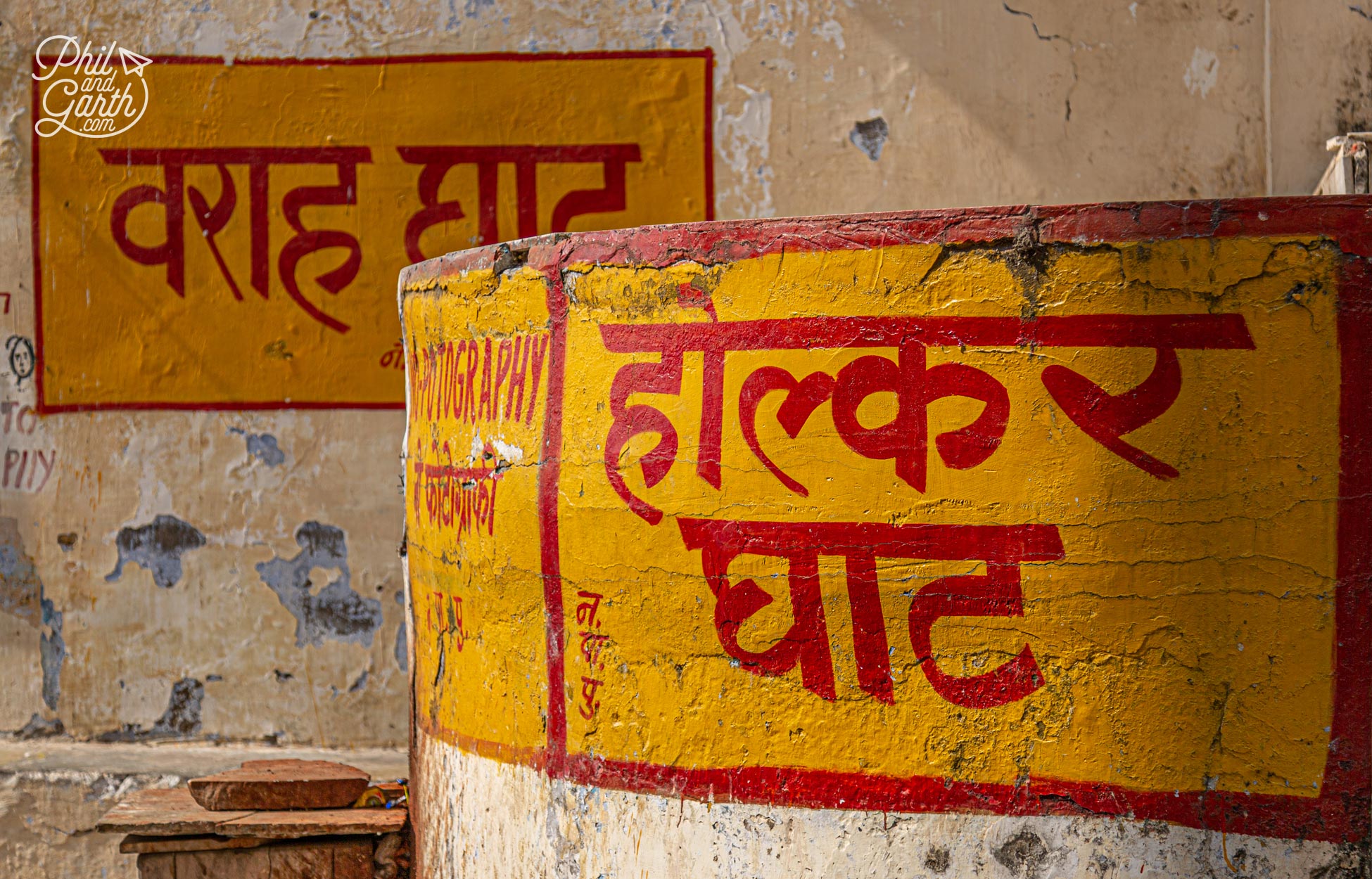
The ghat signs are hand painted in distinctive yellow and red colours
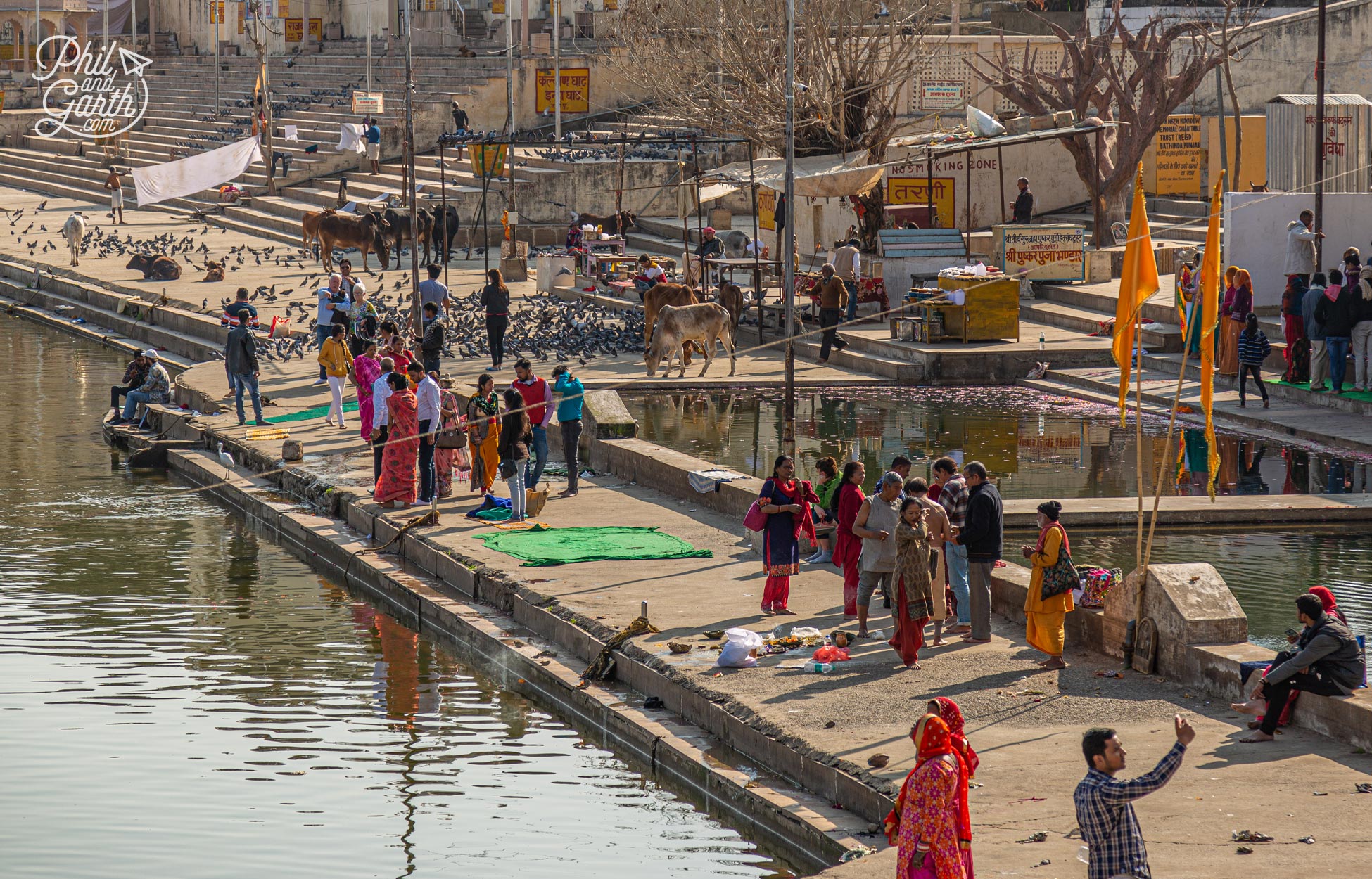
People leisurely strolling around the lake taking selfies
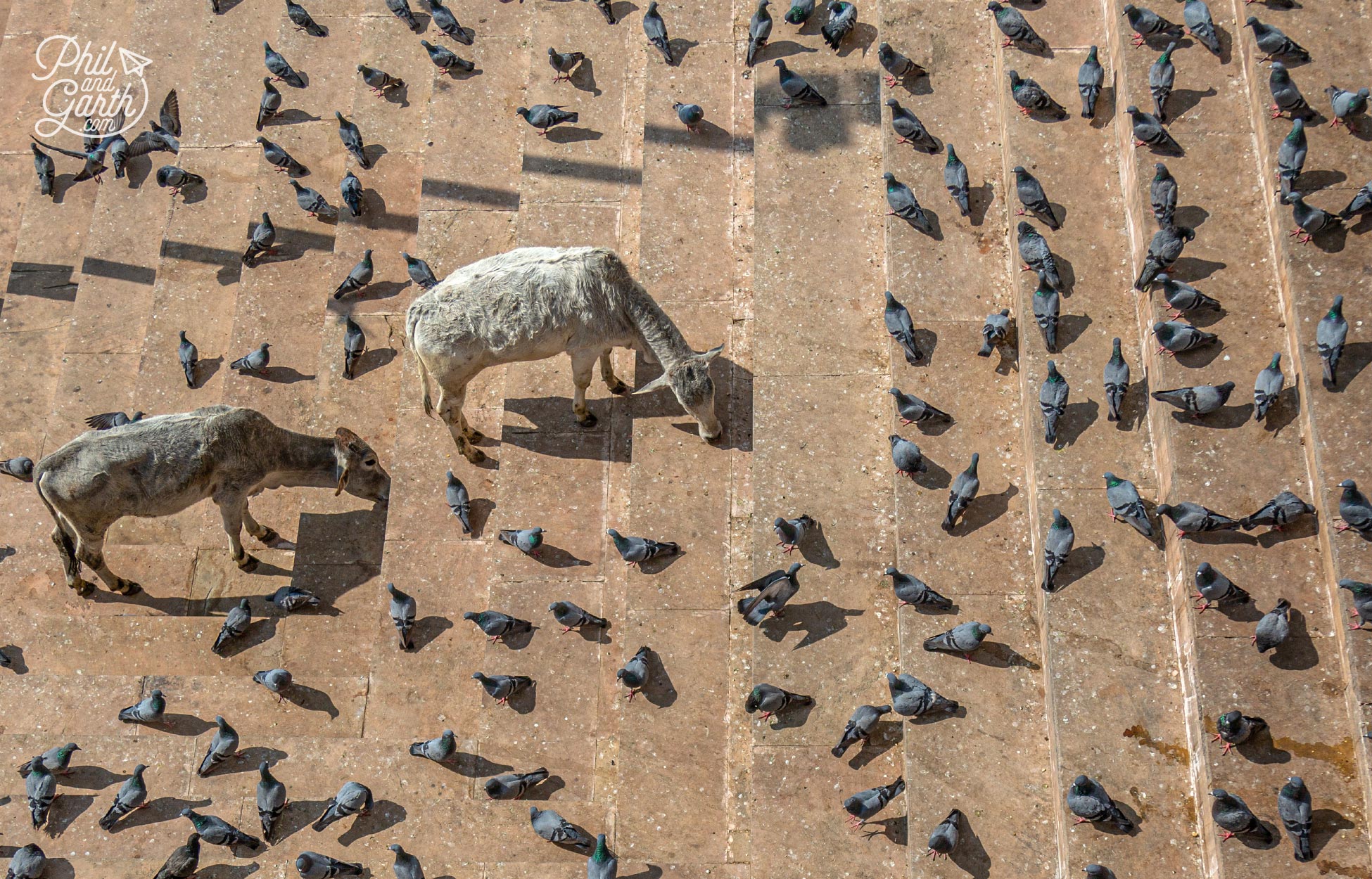
Pigeons and cows looking for food on the ghats
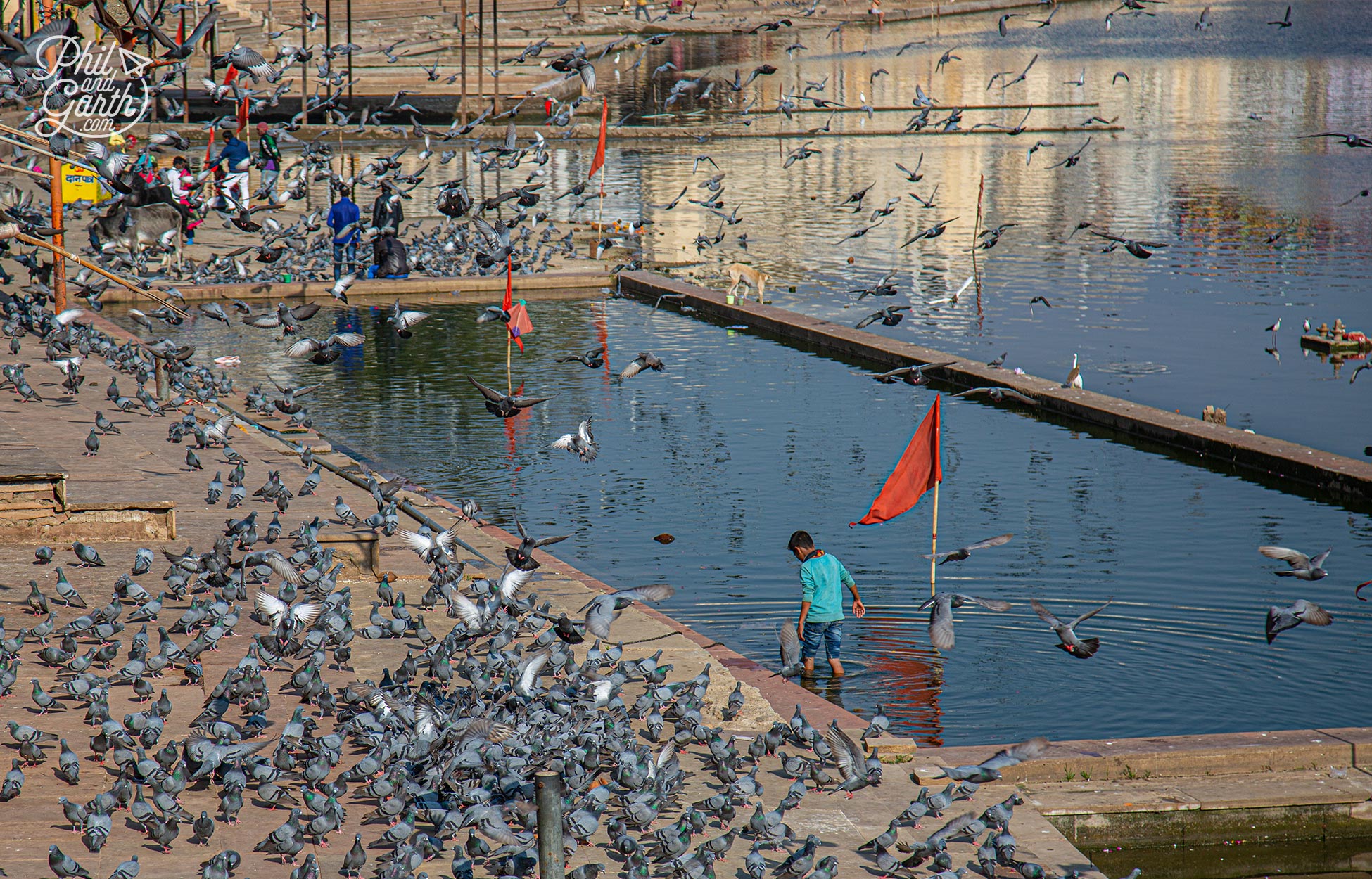
The hundreds of pigeons make for great photos
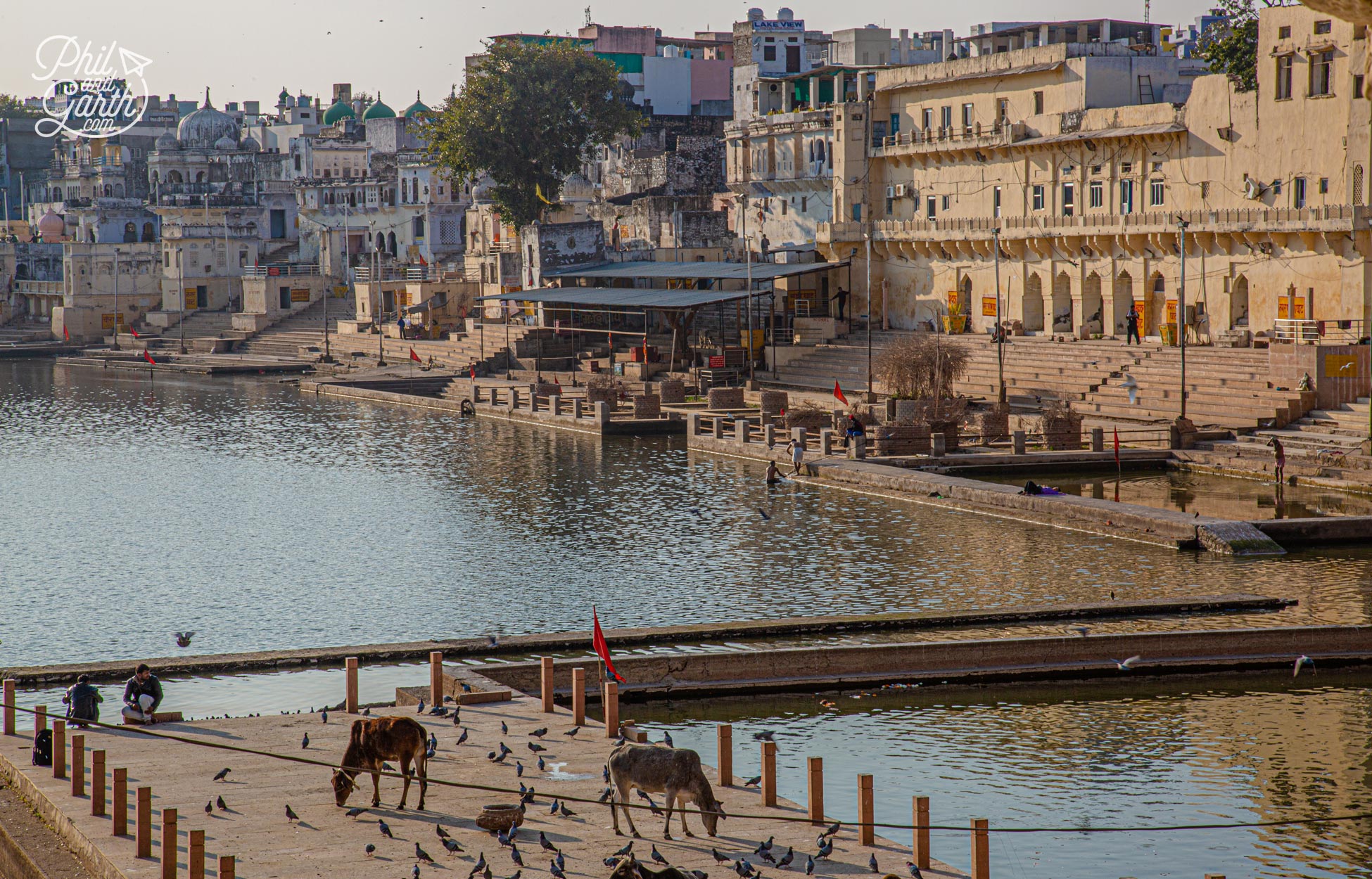
Holy cows also wander around the ghats
Puja Ceremony – A Hindu Blessing
Most people who visit Pushkar take part in a puja ceremony – a traditional Hindu ceremony that usually involves offering something to a god. In our case, we were making an offering to Pushkar Lake in return for good fortune. We were blessed by a Brahmin priest, we had imagined a stereotyped image of a priest dressed in robes, instead, ours was immaculately dressed with a sharp ironed shirt.
Our puja ceremony started with the priest preparing offerings and passing holy water from the lake into our hands. We then held a coconut and a tray of rose petals and spices as we chanted back mantras to him. Our priest then made a red mark on our foreheads (called a tika) from red paste and adds grains of rice which signifies we will never hunger. We then were asked to make a wish as we emptied the contents of our trays into the lake. Our priest said if our wish comes true then we should come back to the same ghat to give thanks. The blessing finished with our wrists tied with a yellow and red string to show our families we have been blessed.
The puja ceremony cost us 100 INR each (£1) and donations go to feeding poor people or a charity. We really enjoyed this atmospheric and cultural experience.
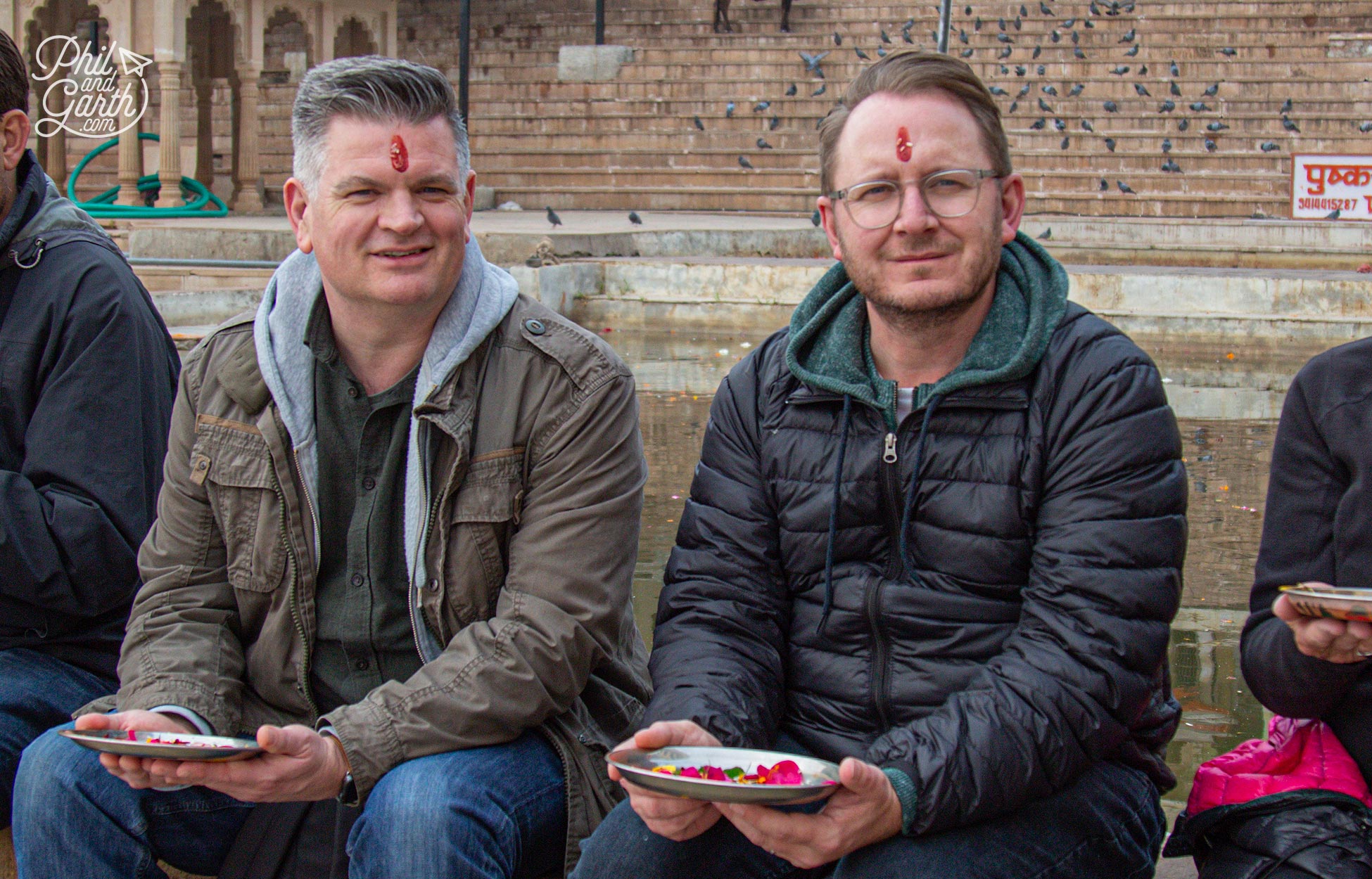
We were blessed by a priest at the main Gau Ghat. It cost us 100 INR each (£1)
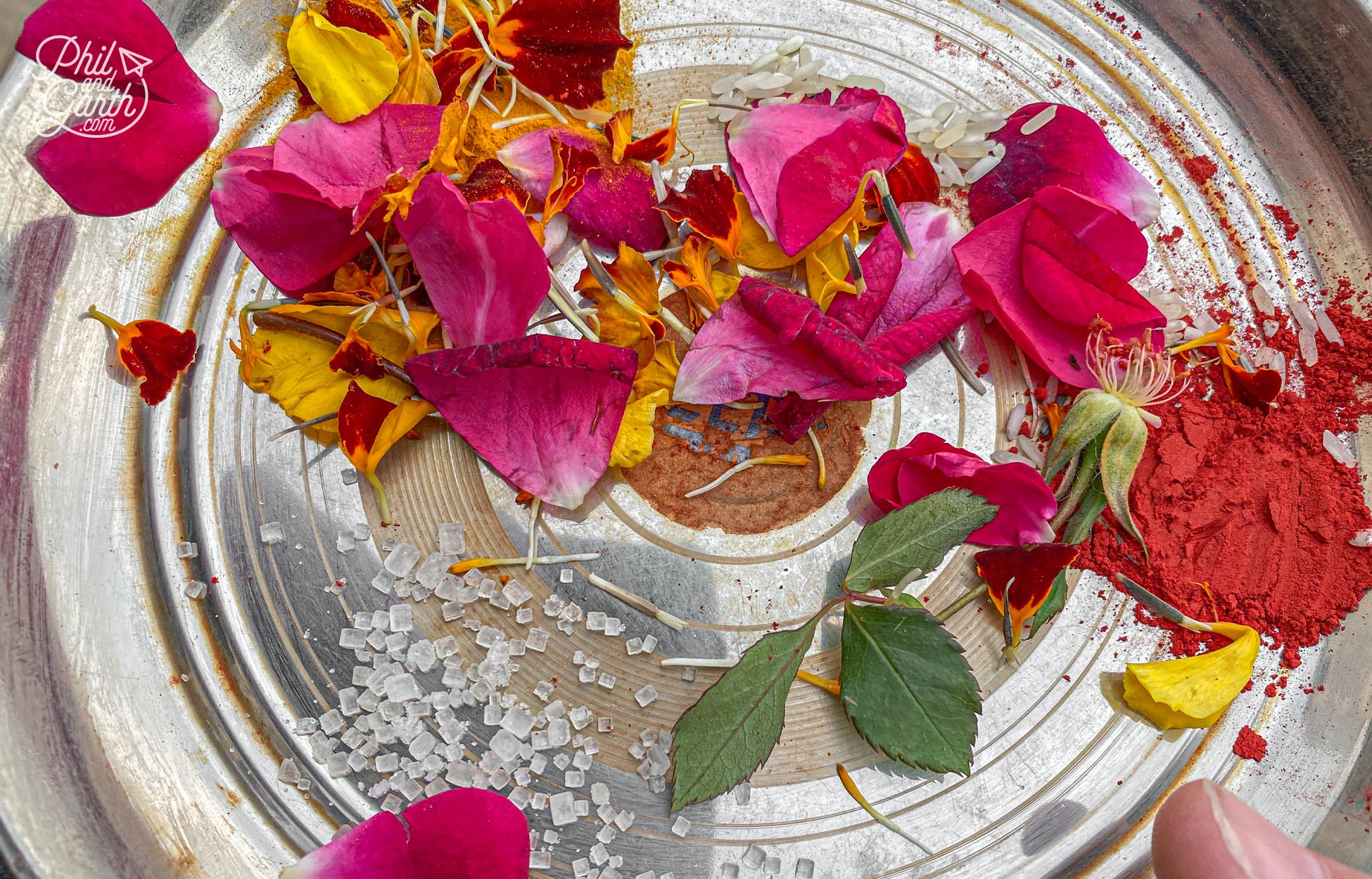
Our tray of offerings included rice grains, spices and rose petals
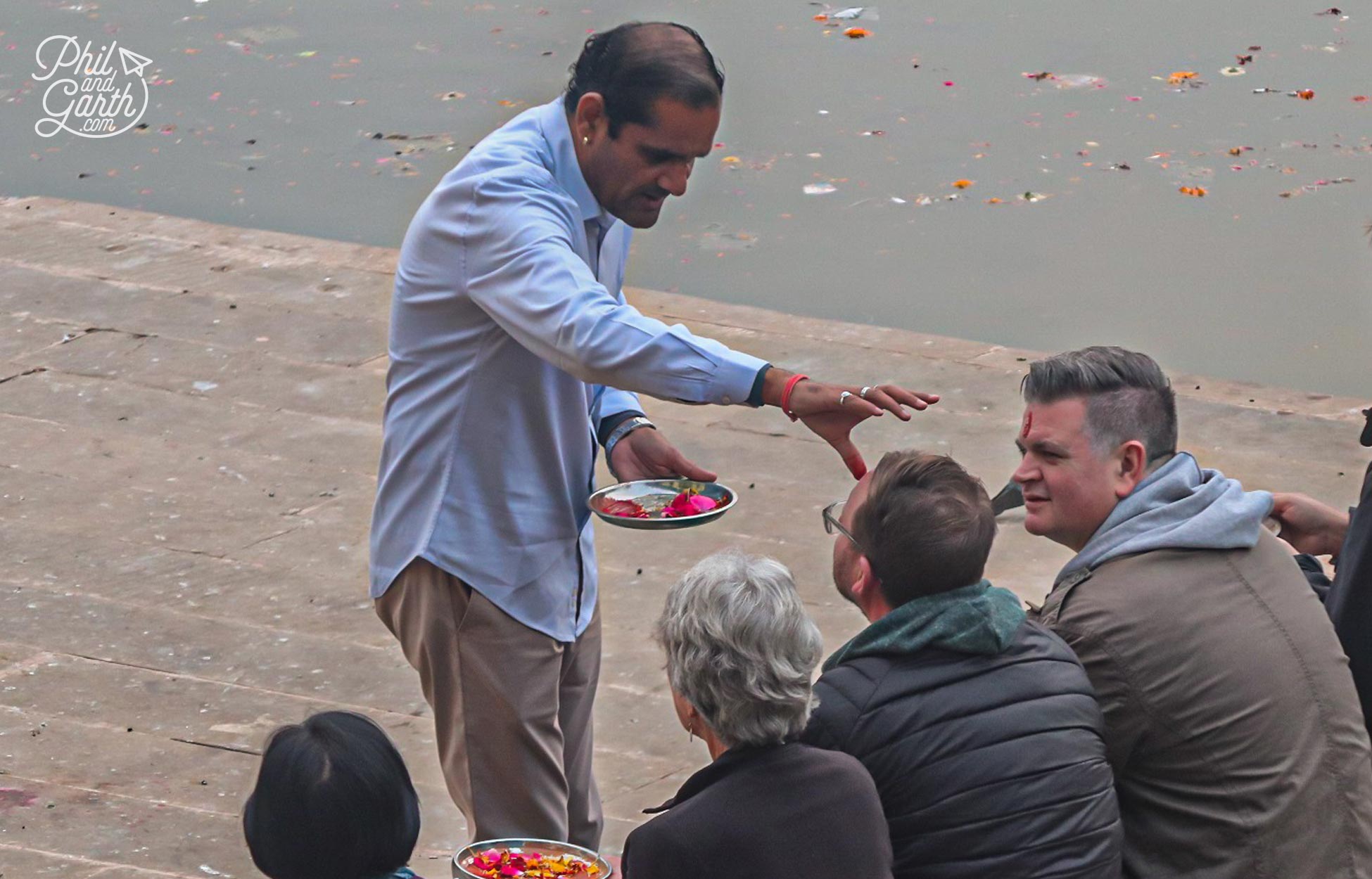
Garth getting blessed by our Brahmin priest
Fake Priest Scams – How to avoid being scammed
Sadly the downside to Pushkar are the many fake priests who prey on tourists. If you would like to take part in a puja blessing ceremony our advice would be to only use someone who has been recommended. Ask at your hotel or your guide (if you are on an escorted tour like we were). Fake priests lure tourists down to the lake for a blessing in return for huge sums of money from £50 to over £100. They do this in three main ways:
- They will approach you with a simple invitation to the lake to be blessed, but after the ‘blessing’ will demand a large donation and a tip.
- Another tactic is they will insist you need to wear a red string or ribbon on your wrist to enter the ghats to get to the lake – it’s not true they are all free to enter.
- Or they will try the flower scam – offering or forcing a flower in your hand as a welcome gift to be blessed by the water. Don’t accept any petals or flowers – it’s a scam!
We got hassled by a few people which wasn’t great. Including one guy who tried to put a flower in our hands, we said no with clenched fists and he aggressively said back to us “it’s not a bomb!” we knew what he was up to.
The main way to stop getting hassled is to wear a wristband made of yellow and red string. It shows people you have already been blessed and the fake priests should leave you alone. If you don’t want to have a blessing, it’s still worth wearing a wristband – ask at your hotel. Some places will offer bands to their guests to avoid the pushy Pushkar so-called priests.
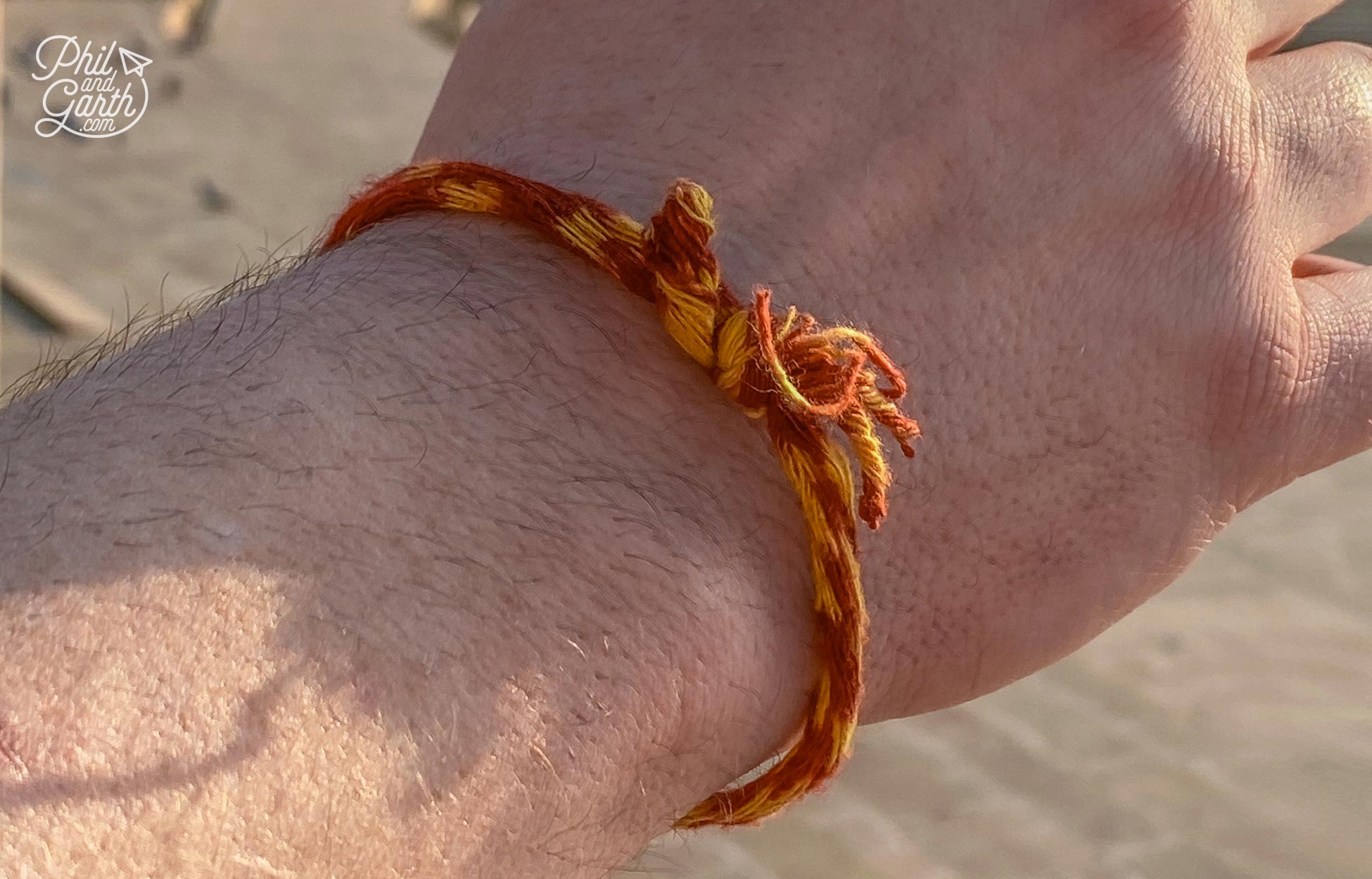
Wear a red and yellow string wristband to avoid the pushy Pushkar priests!
Sunsets
The sunsets are pretty good in Pushkar. One of our favourite experiences was having dinner and watching the sun go down from the best rooftop cafe in Pushkar, the Sun-Set Hotel. Their rooftop has great views across Pushkar lake, although the Indian food served here was a bit average.
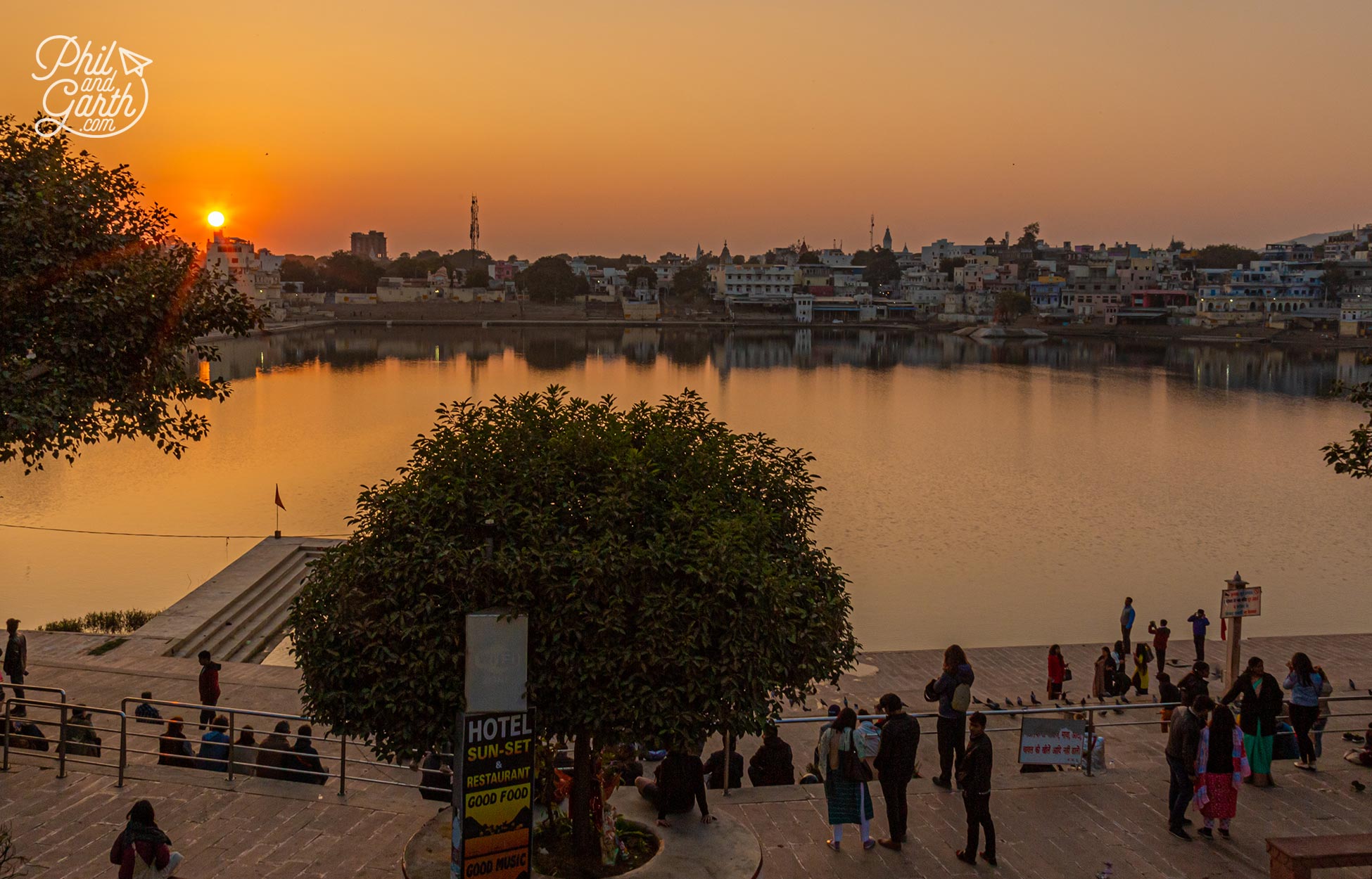
The view of Pushkar Lake from the Sun-Set Hotel rooftop
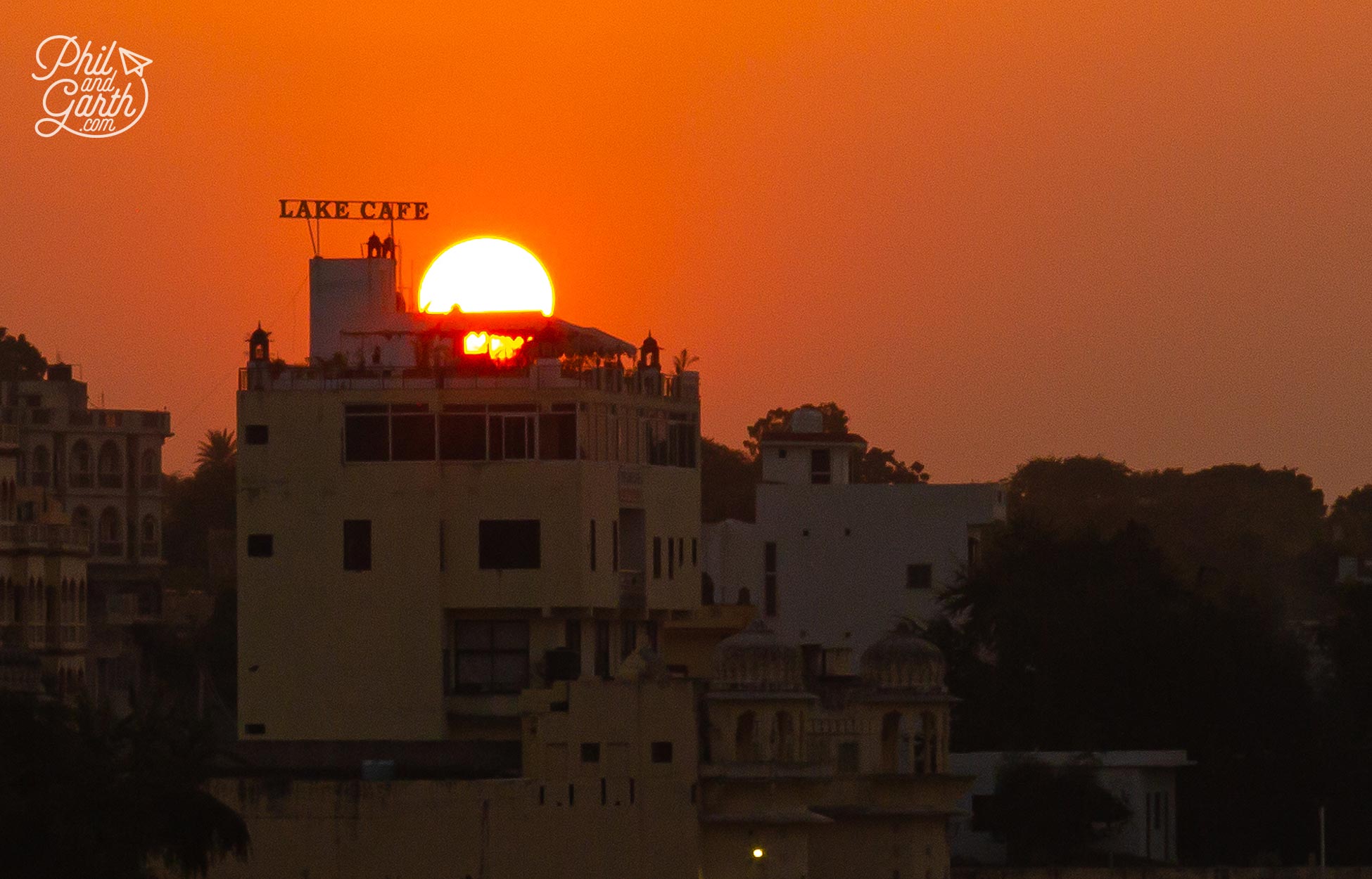
The sun disappearing behind the Lake Cafe in the distance
Temples To Visit
Brahma Temple
The 14th century Brahma Temple is Pushkar’s most important temple as it’s one of only a few left in India dedicated to Lord Brahma – the Hindu god of creation. Brahma is one of the three original gods of Hinduism (Brahma the creator, Vishnu the preserver and Shiva the destroyer). The temple has a distinctive tall red spire and surrounded by bright blue columns. Photography is not allowed and shoes and bags must be stored in a rented locker.
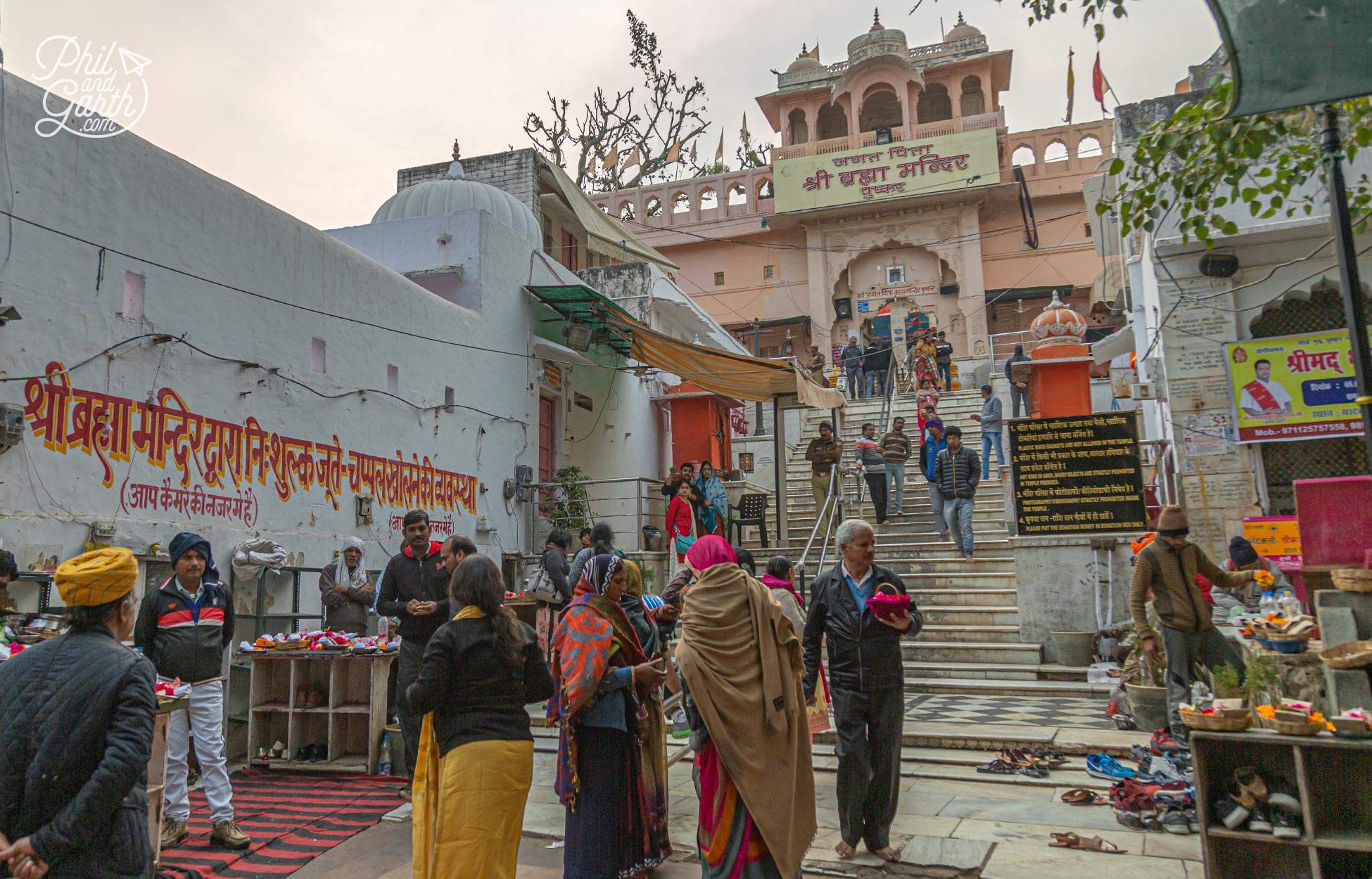
Entrance to the 14th century Brahma Temple
Savitri Temple
The other temple worth visiting is located at the top of the Ratnagiri hill, the highest hill overlooking Pushkar. It’s a small temple dedicated to Goddess Savitri, the first wife of Lord Brahma. We took the cable car to reach the top, if you’re feeling more active you can take the 650 steps! Apparently, lots of people come first thing in the morning to witness the sunrise over Pushkar.
The views of Pushkar and the surrounding Aravali Mountains are fabulous. We especially enjoyed watching the cheeky monkeys that live here. Phil inappropriately giggled as one of them stole a bag of crisps off a little girl and she burst into tears. They reminded us of the naughty Barbary macaques of Gibraltar who also love stealing food and plastic bags!
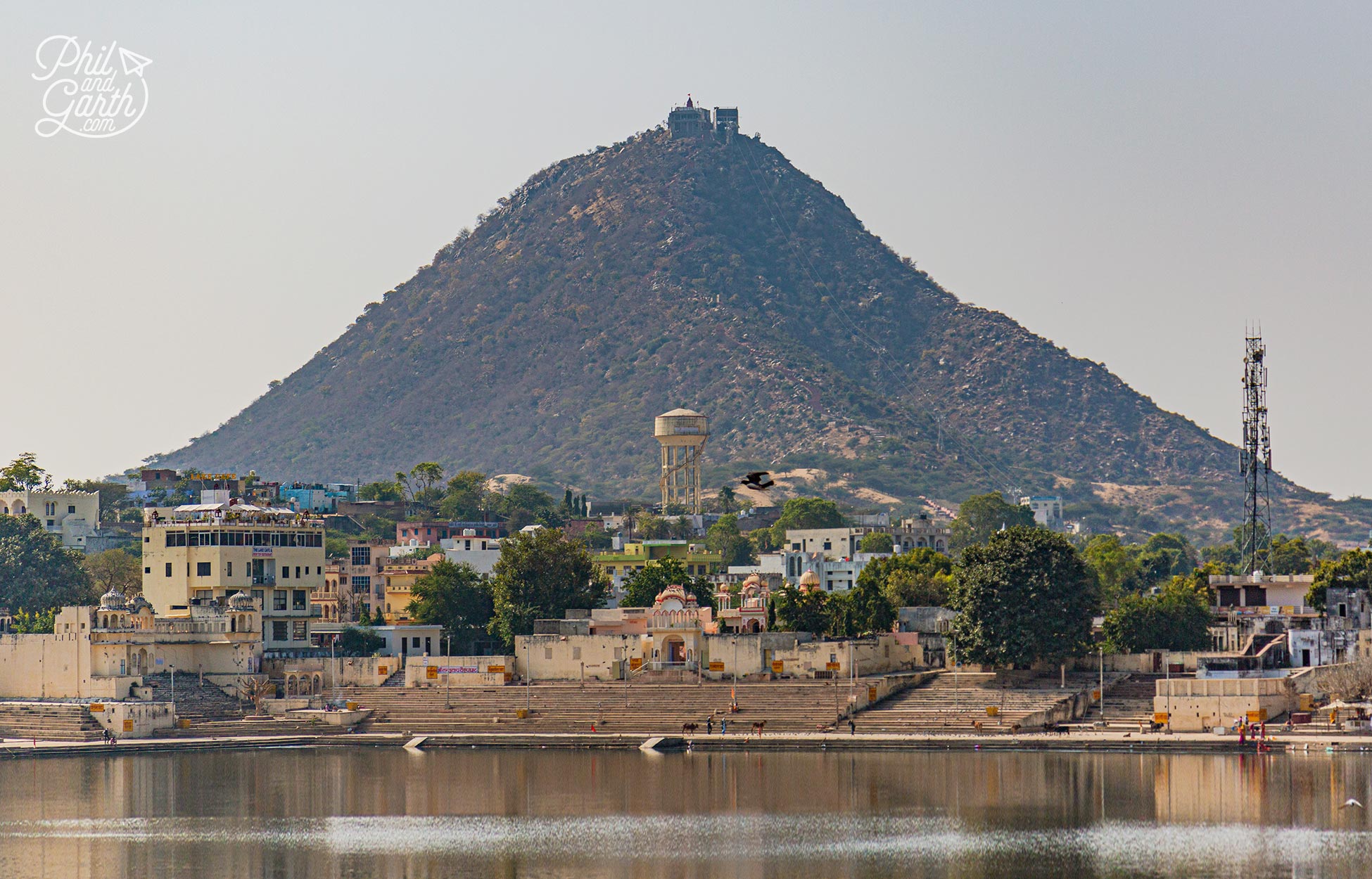
The Savitri Temple was built in 1687 at stands at the top of Ratnagiri Hill
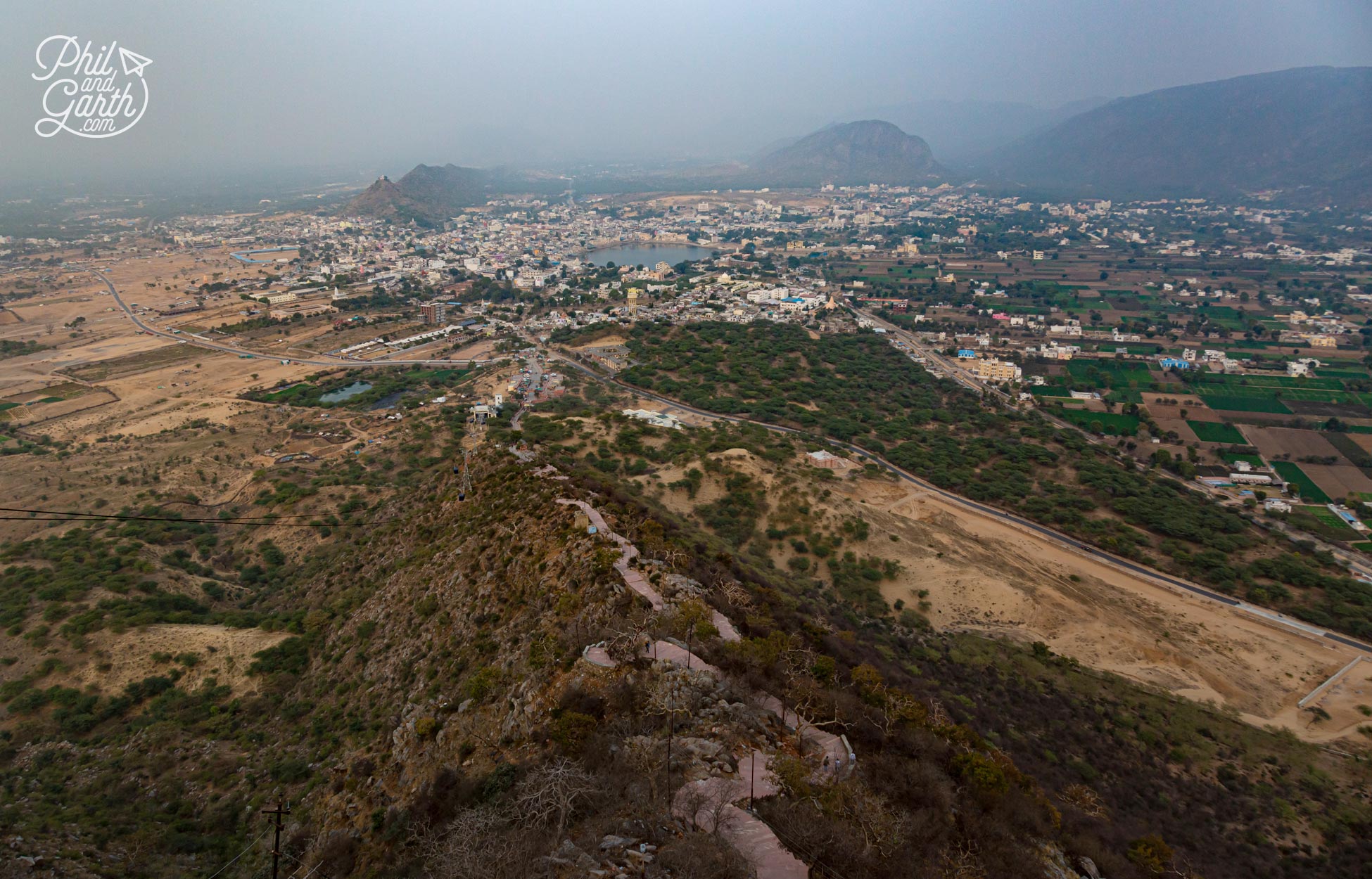
The view of the desert and Pushkar from Savitri Temple
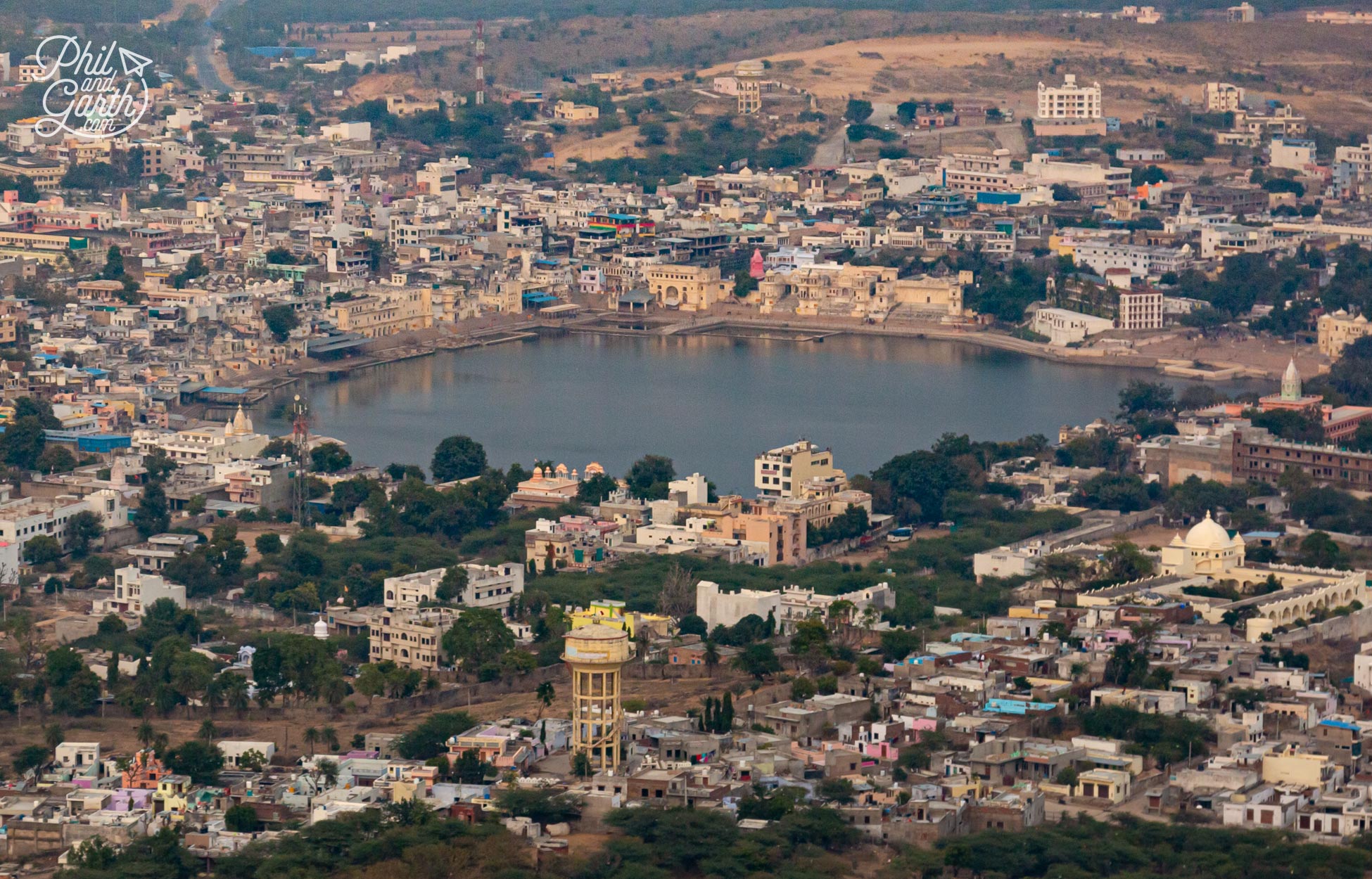
A lofty view of Pushkar Lake
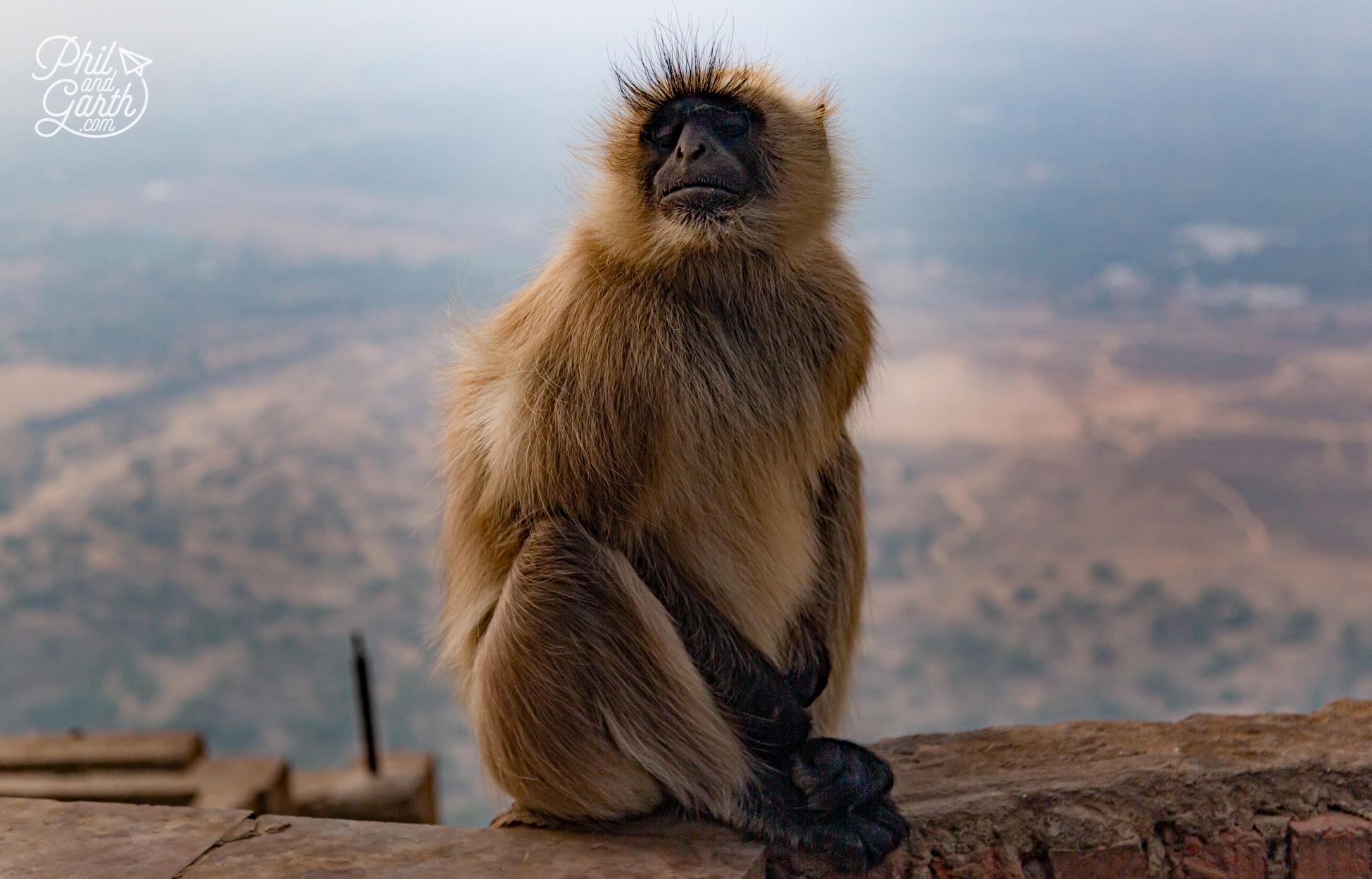
The cheeky monkeys at Savitri Temple
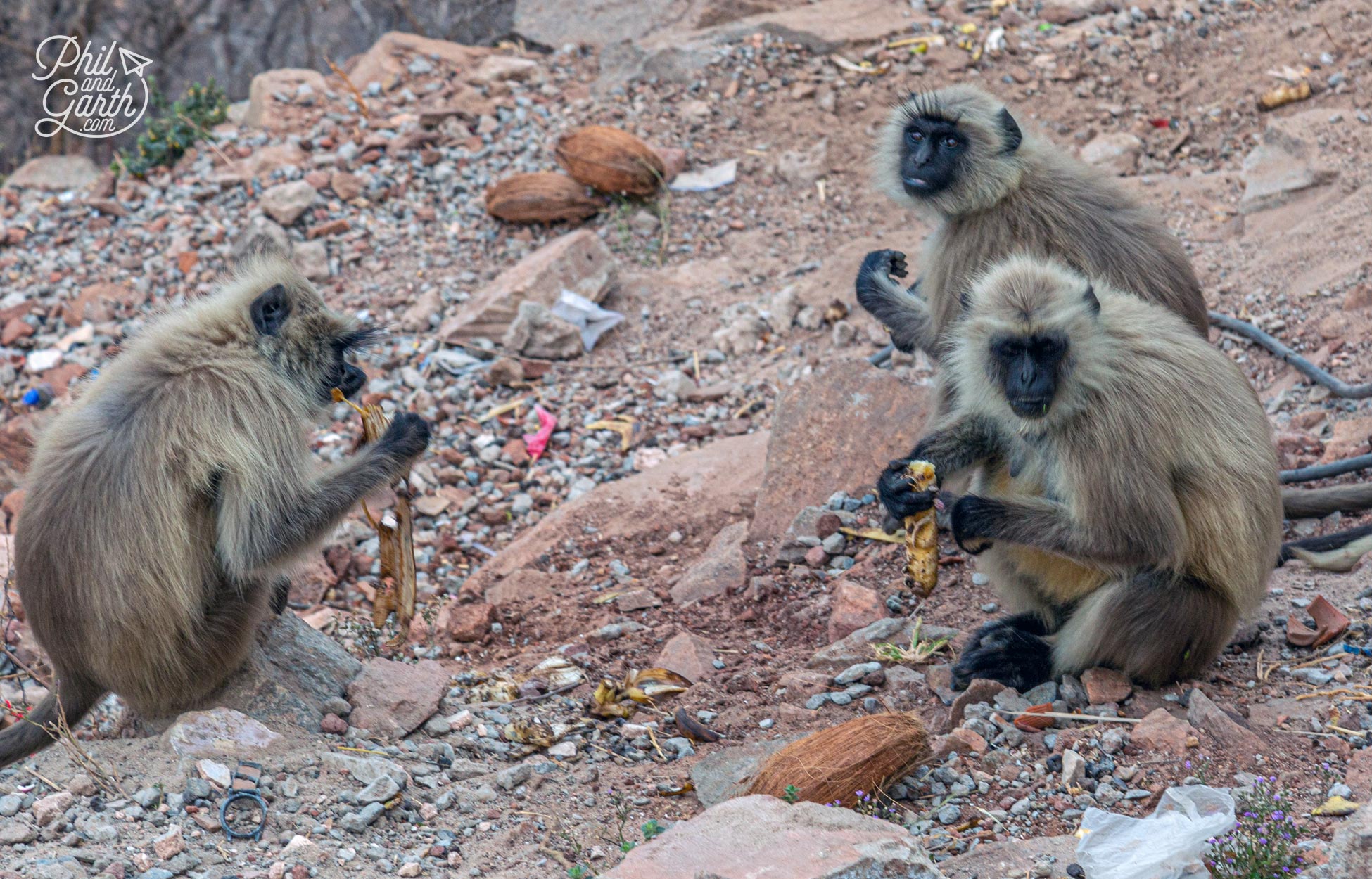
They love bananas and coconuts!
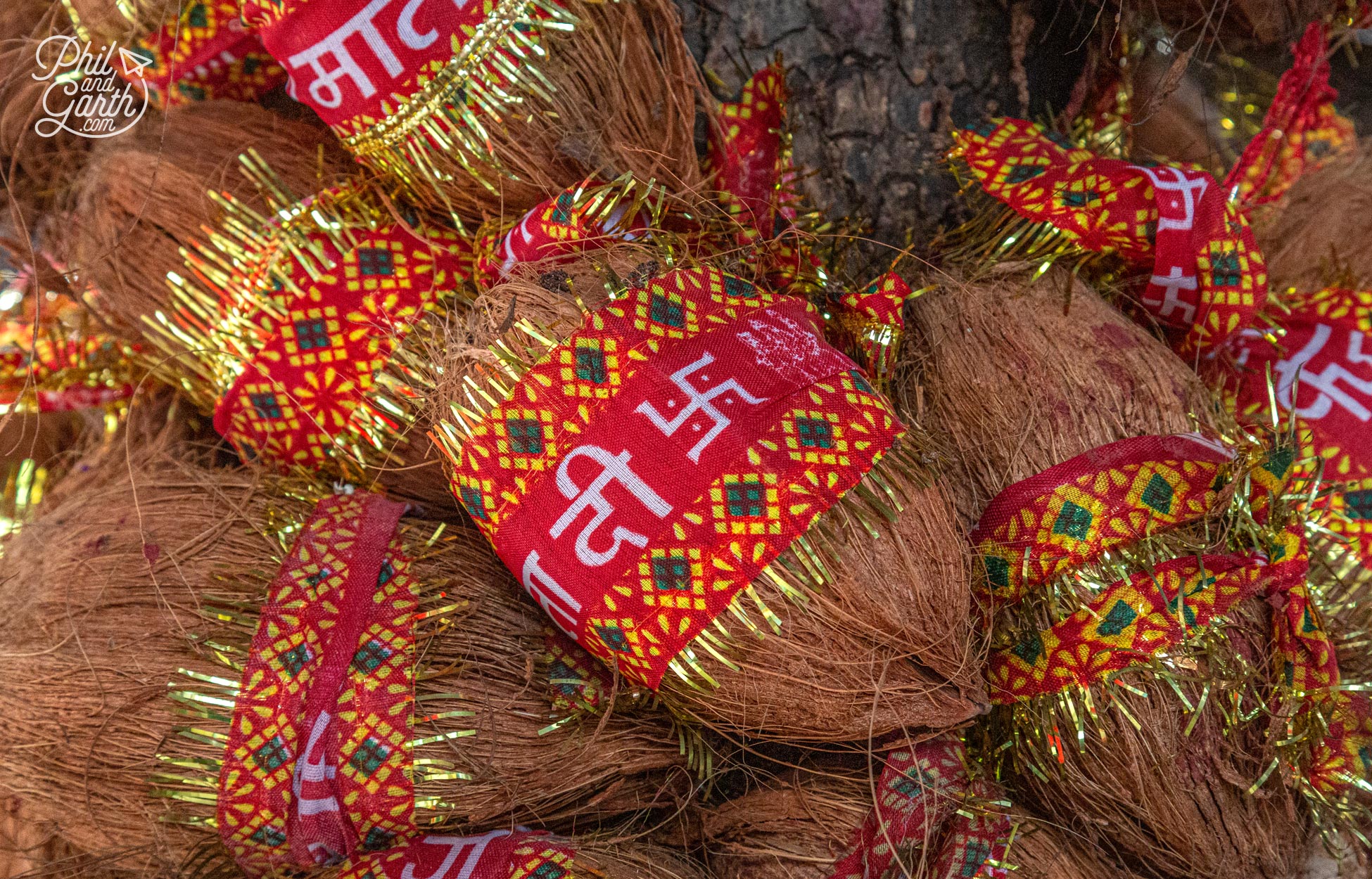
In Hinduism coconuts symbolise God. Whilst the swastika has been a sacred symbol for millions of years
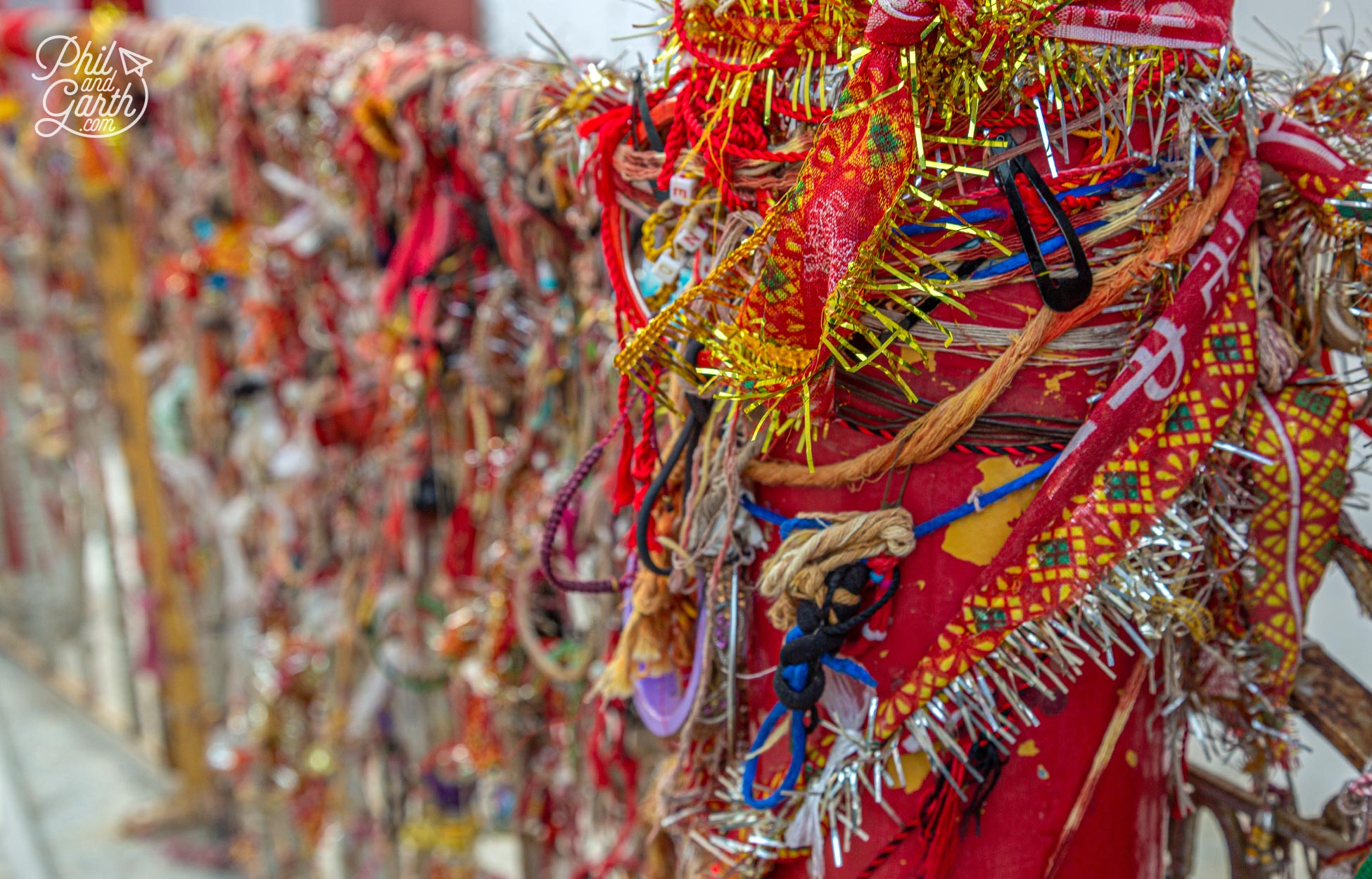
Hundreds of bracelets and strings of tinsel are tied to the temple’s fence
Shopping Pushkar’s Bazaars
Pushkar’s bazaars are full of stalls down one long main street. It’s really popular with tourists and western traders looking to source colourful handicrafts of Rajasthan. The bazaars sell bangles, saris, turbans, jewellery, embroidered clothing, leather goods, cheap textiles plus the usual tourist tat. It’s also one of the cheapest places in India to buy things at low prices, so we didn’t feel the need to haggle too much. We bought some beautiful wooden printing blocks, lots of incense sticks and a smart leather bound paper notebook for just £1, ridiculously cheap.
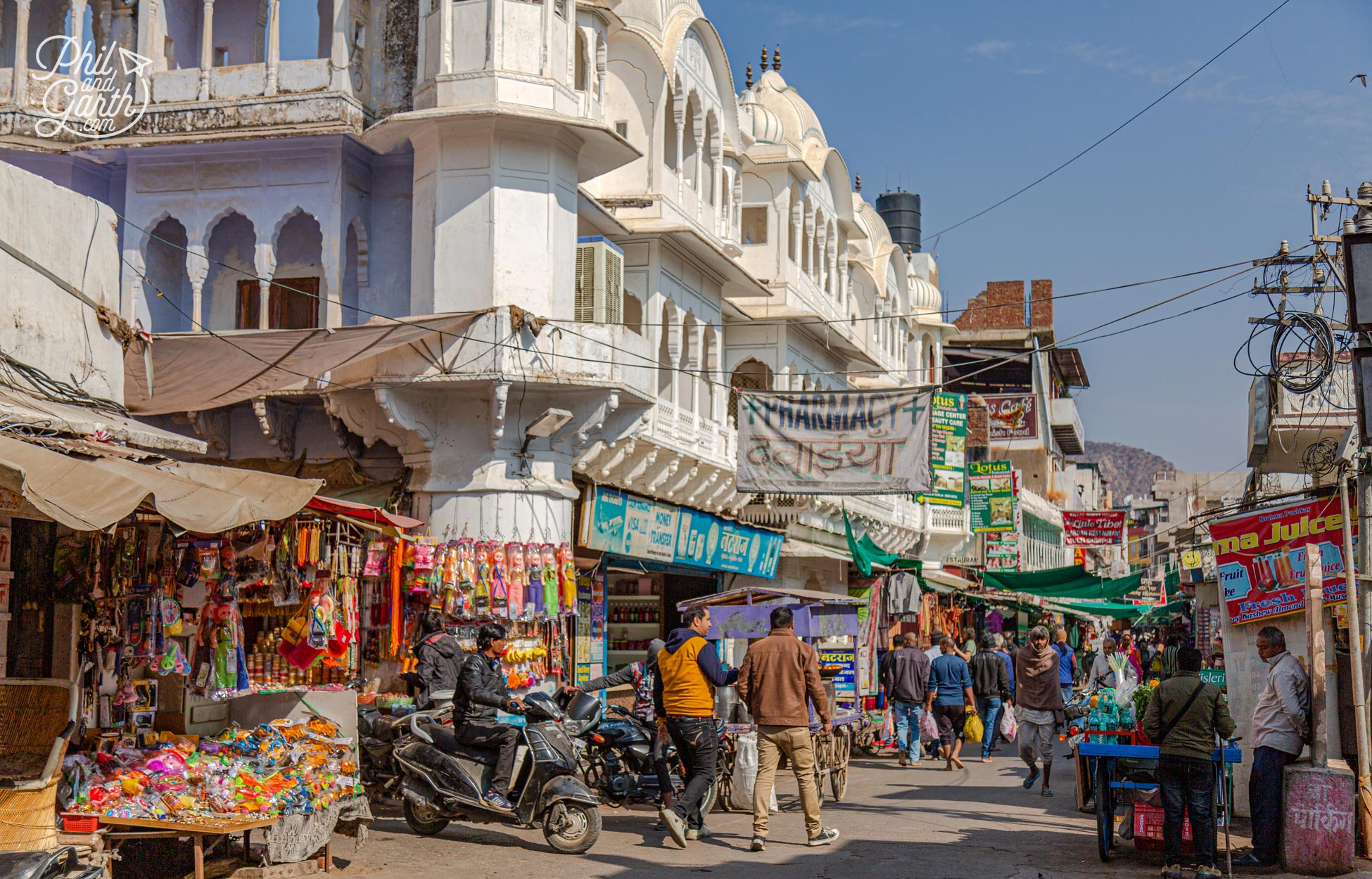
One of Pushkar’s many bazaars
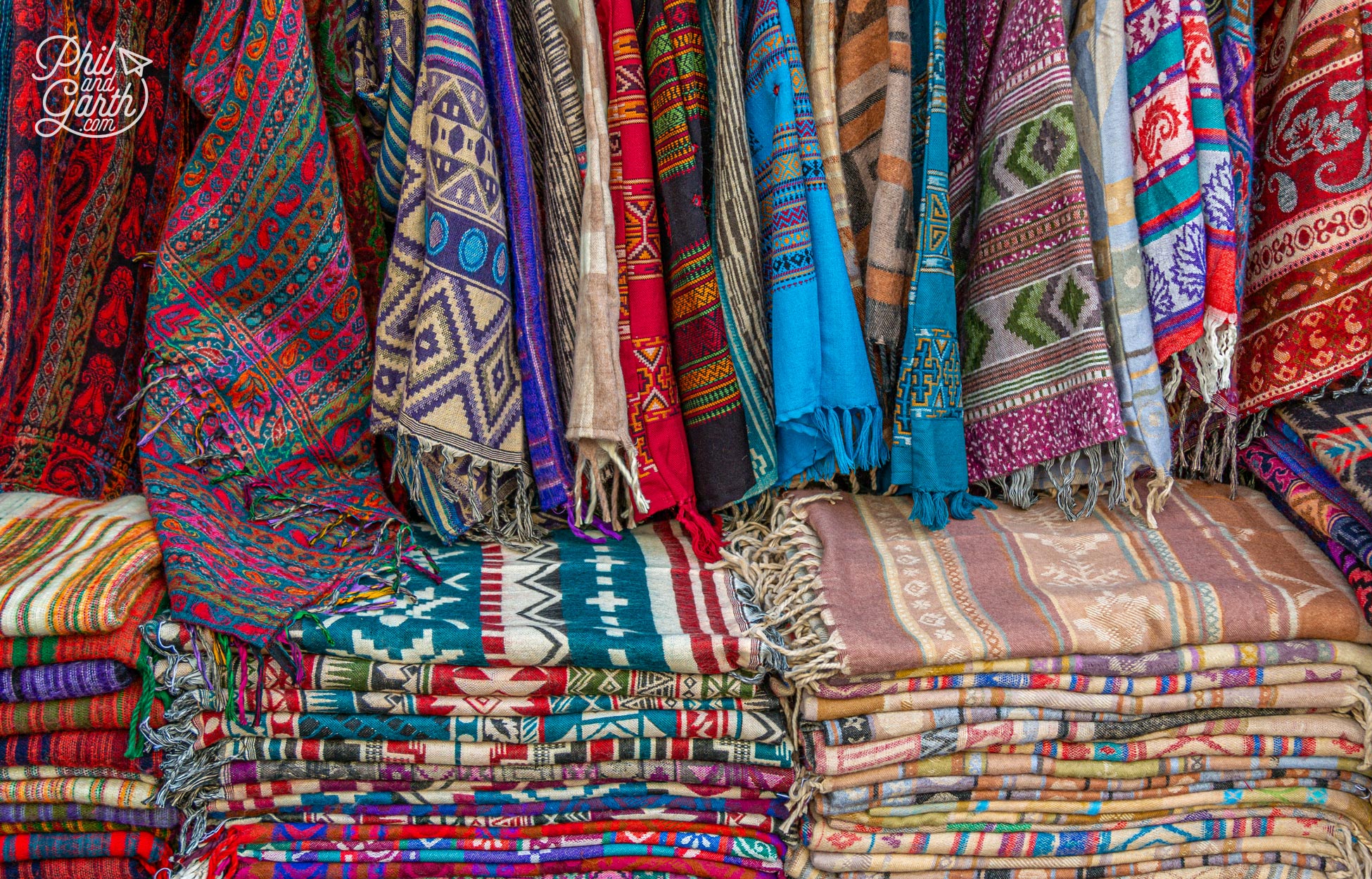
Colourful pashminas for sale in a Pushkar bazaar
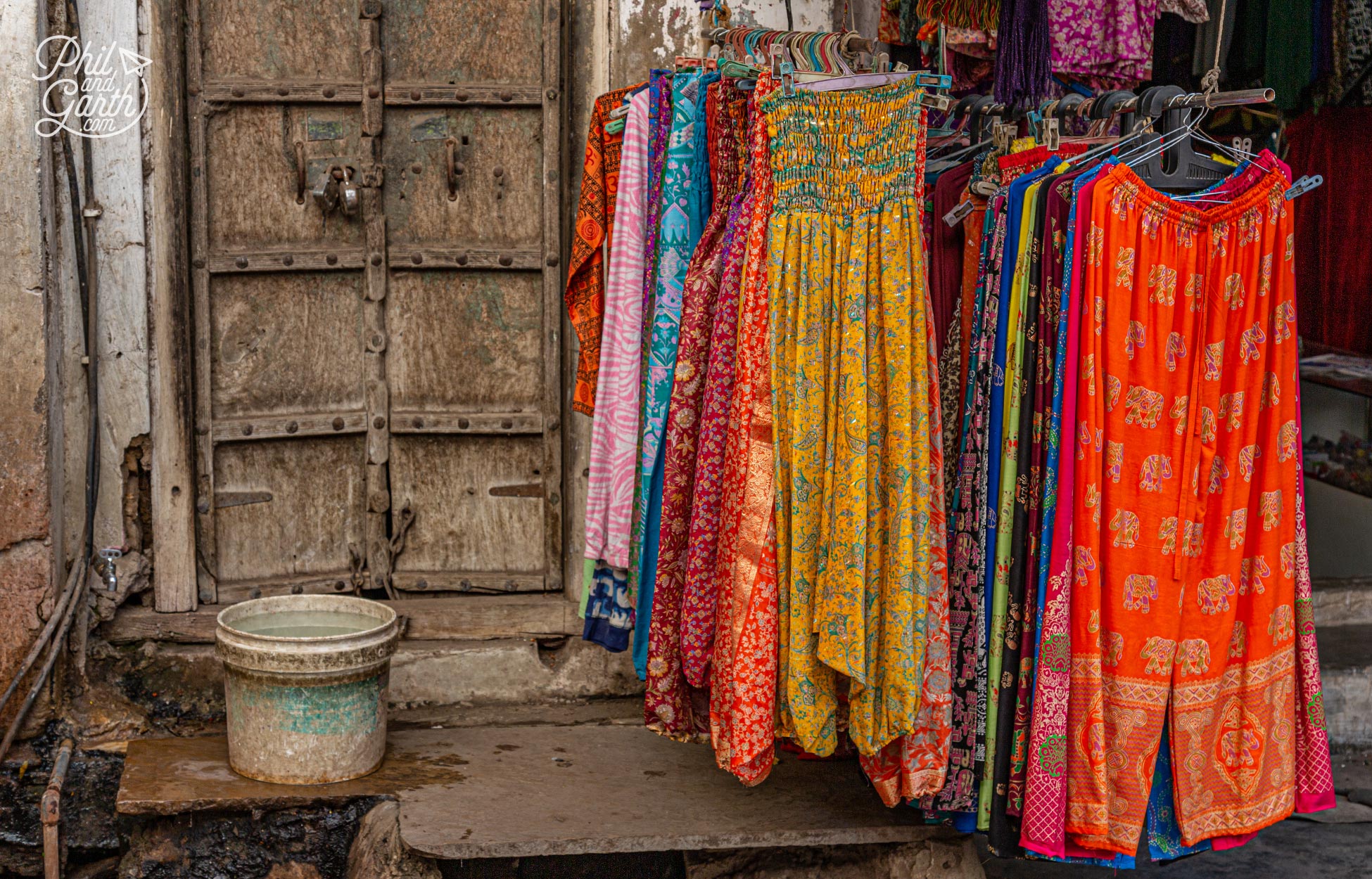
Dresses and elephant pants for sale
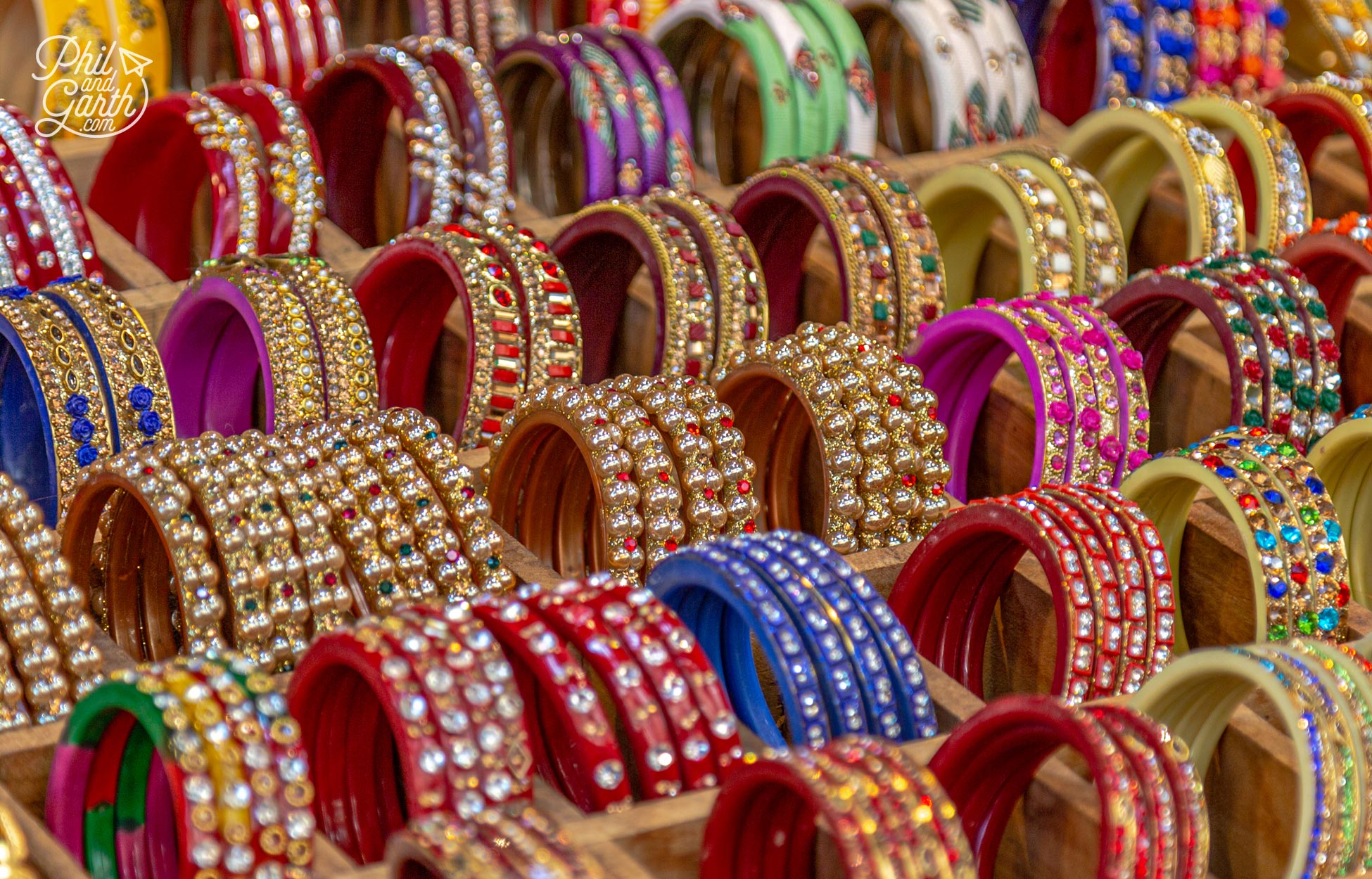
So many colourful bangles for sale in Pushkar’s various bazaars
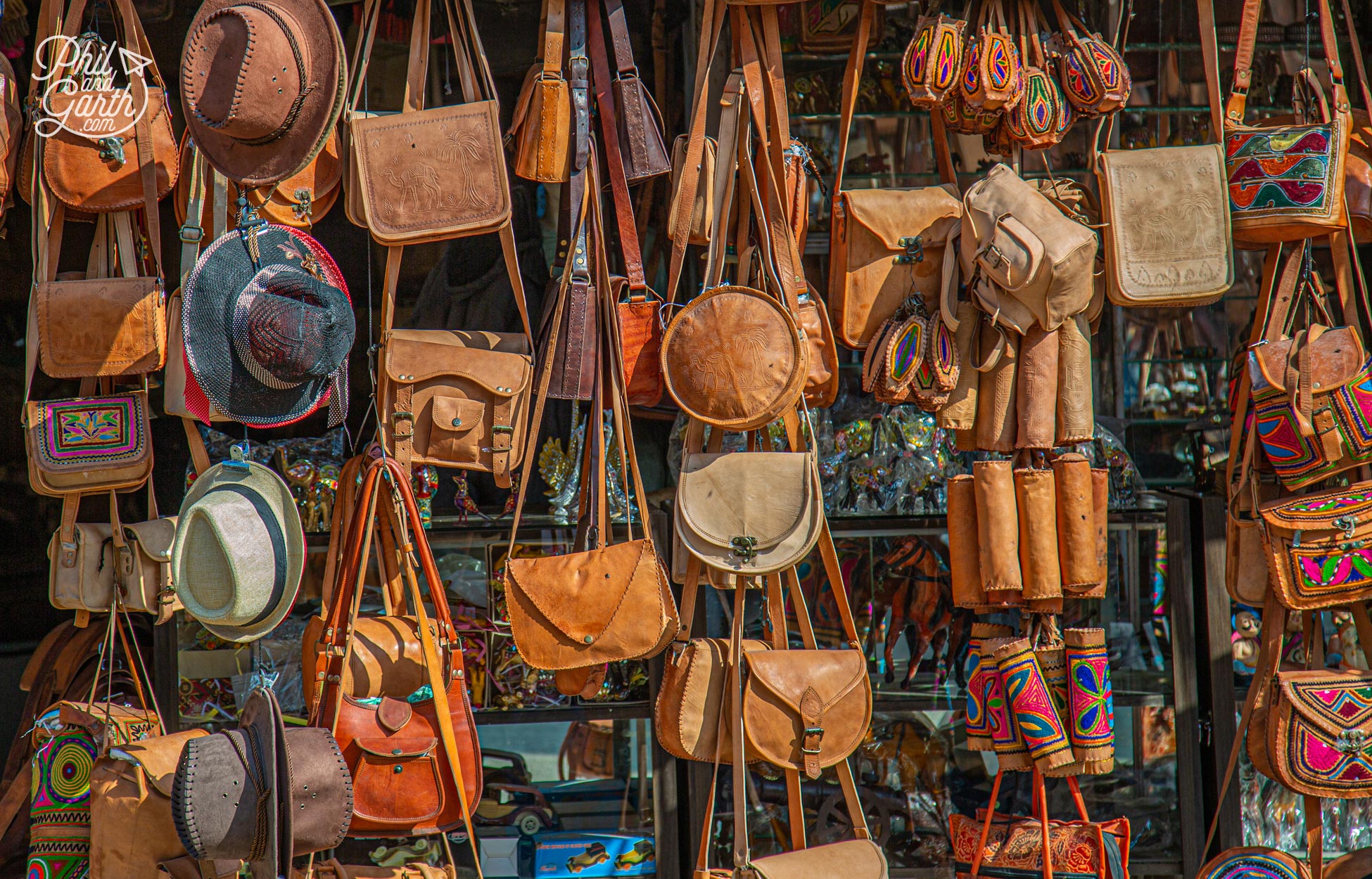
Leather goods for sale, we were tempted to buy a satchel
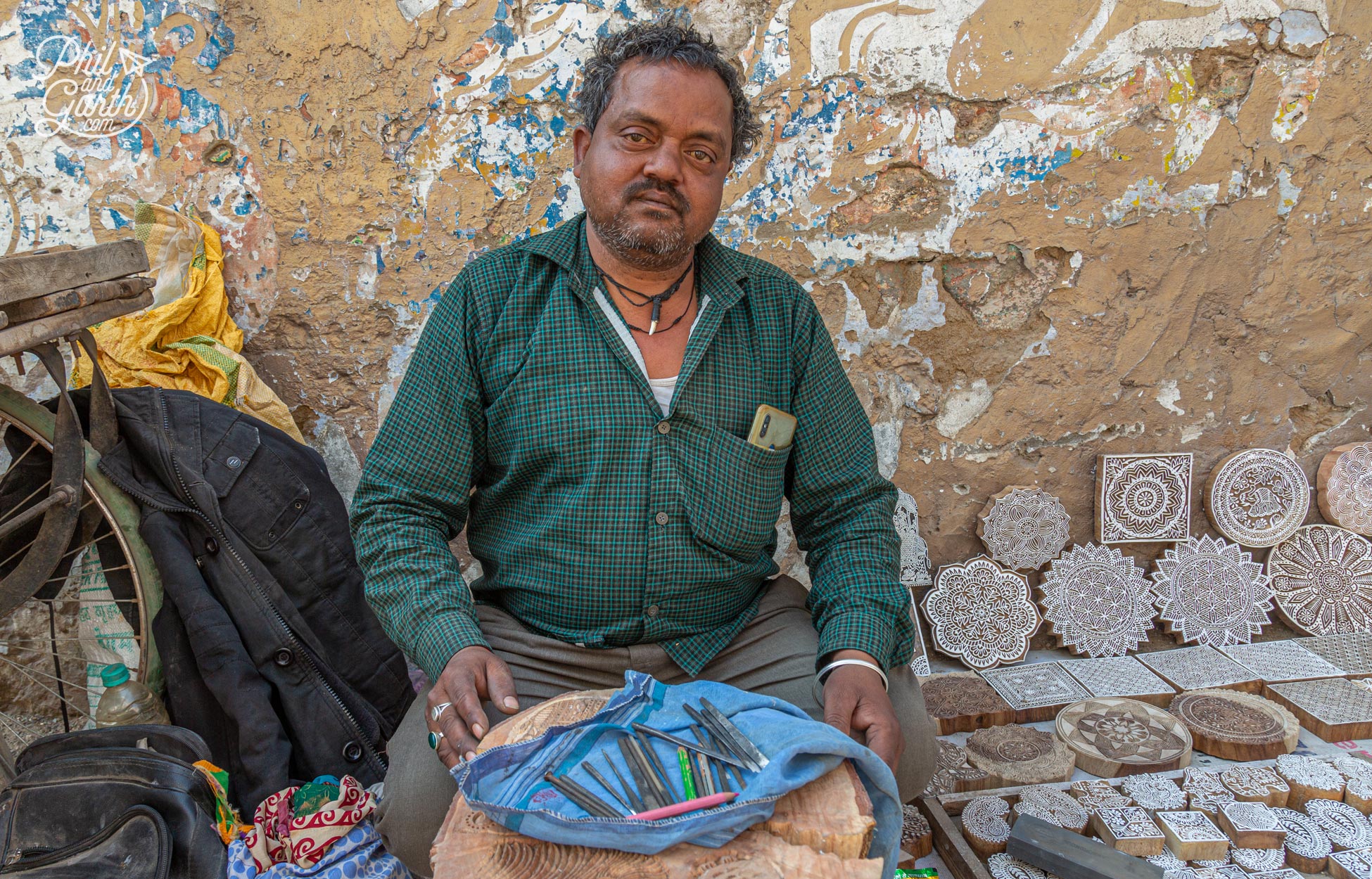
This lovely guy hand carved the wooden printing blocks we bought
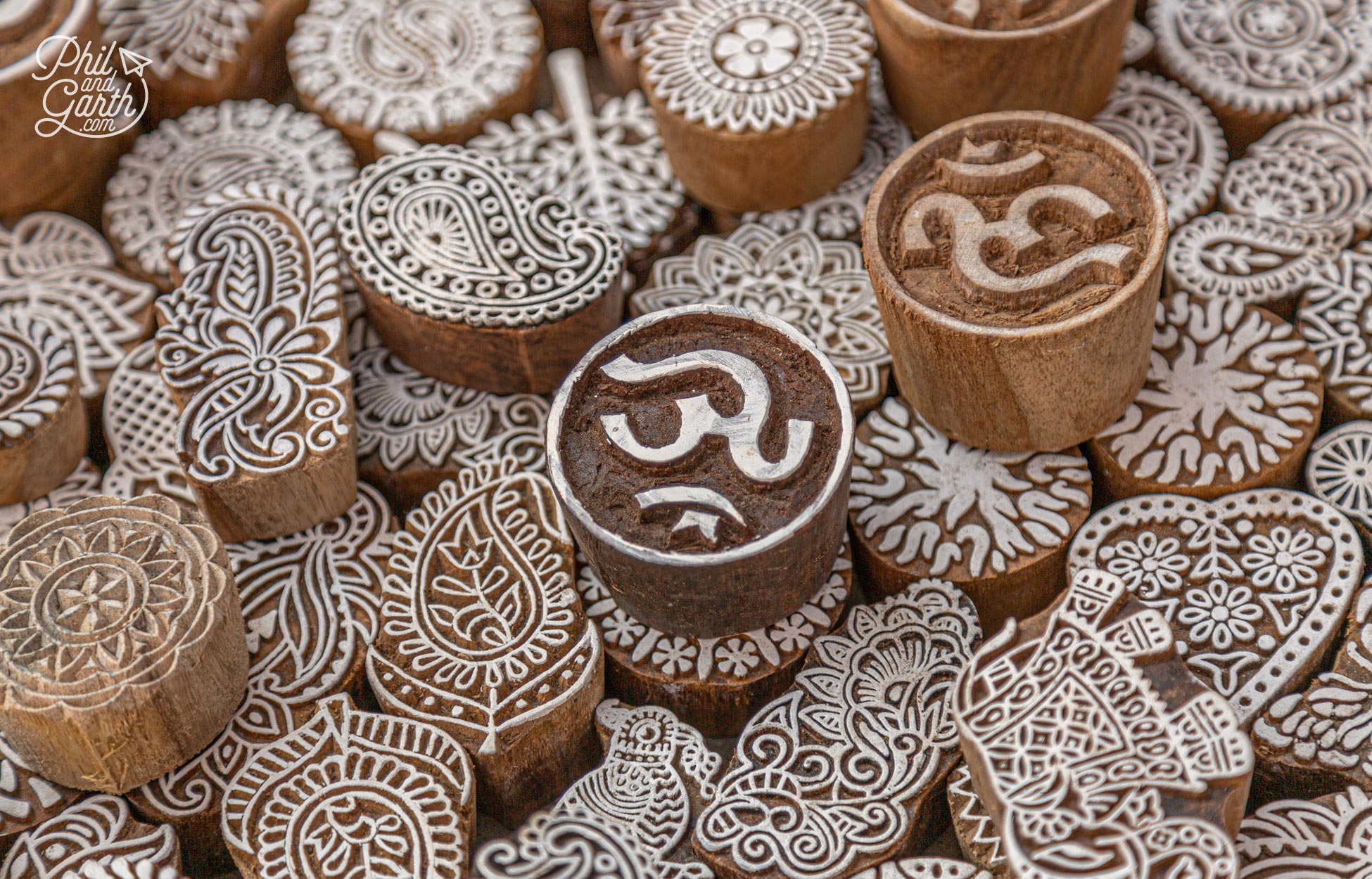
Indian wooden printing blocks make a great gift or unique souvenir
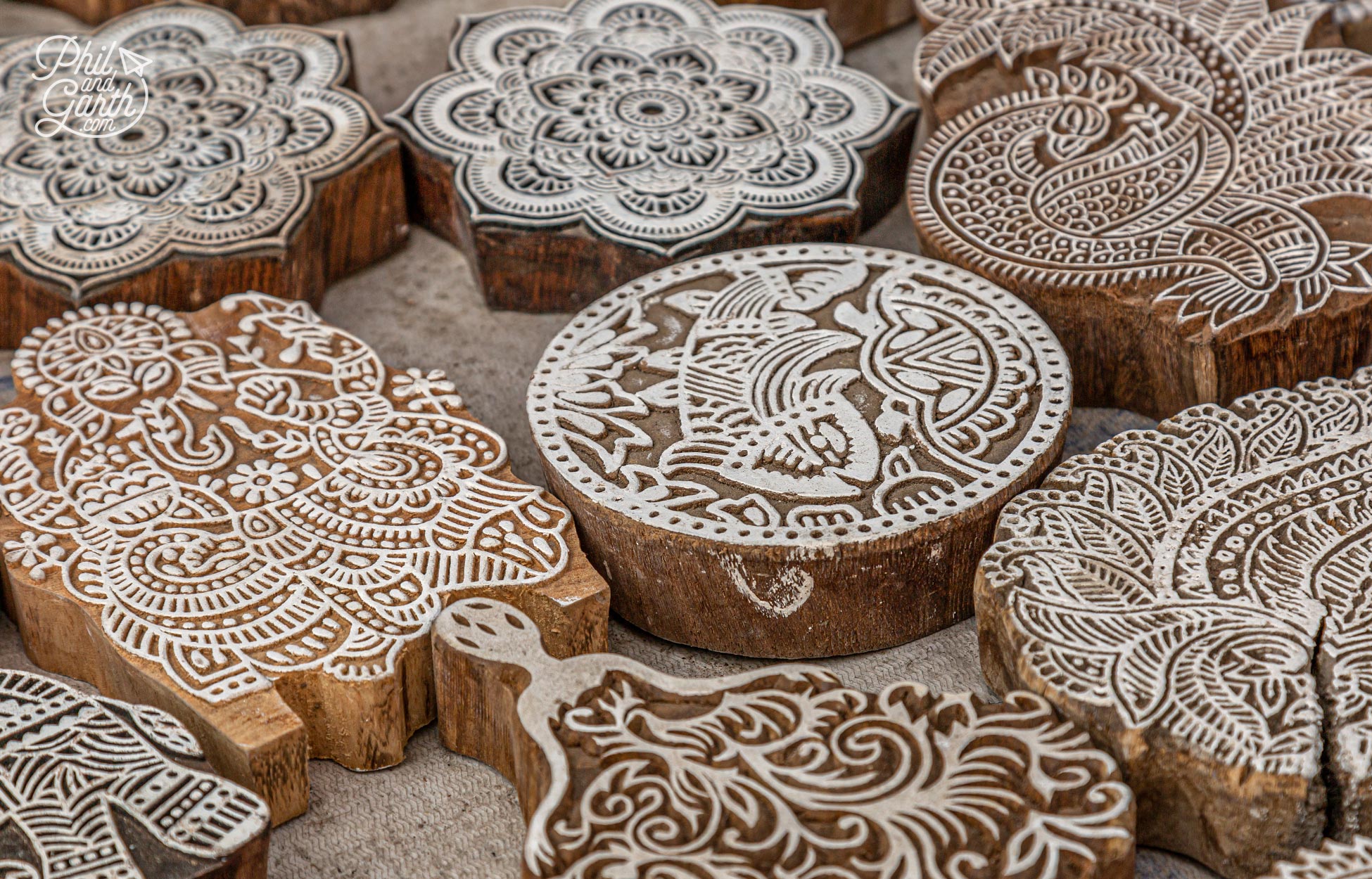
So many gorgeous designs
Cafes & Restaurants In Pushkar
Pushkar is a very religious place so drinking alcohol and eating meat or eggs are strictly forbidden. All restaurants are vegetarian and most offer western dishes like pizza. Pushkar is popular with Israeli backpackers so falafel is everywhere and most menus are translated into Hebrew. Away from the cafes, there’s loads of street food on offer, remember to only eat dishes cooked fresh in front of you to avoid Delhi belly! We had hot fried samosas and tried jalebi – deep fried batter coated in syrup and sugar, they look like a pretzel. There are also lots of sugar cane juice stalls, with machines that you could lose a limb on. We also saw a street cart full of ice lollipops, Laura who was in our small group tour called them “Death on a stick!” 😭
One of the best cafes in Pushkar to visit is the rooftop of ‘Pushkar Cafe Roof Top’. We were so chilled here just enjoying the good food and the cool views. The rooftop cafe at Hotel U-Turn also has a great view, both are on Varah Ghat. We said Pushkar is alcohol free, however in some cafes if you ask discreetly they will sell you some booze.
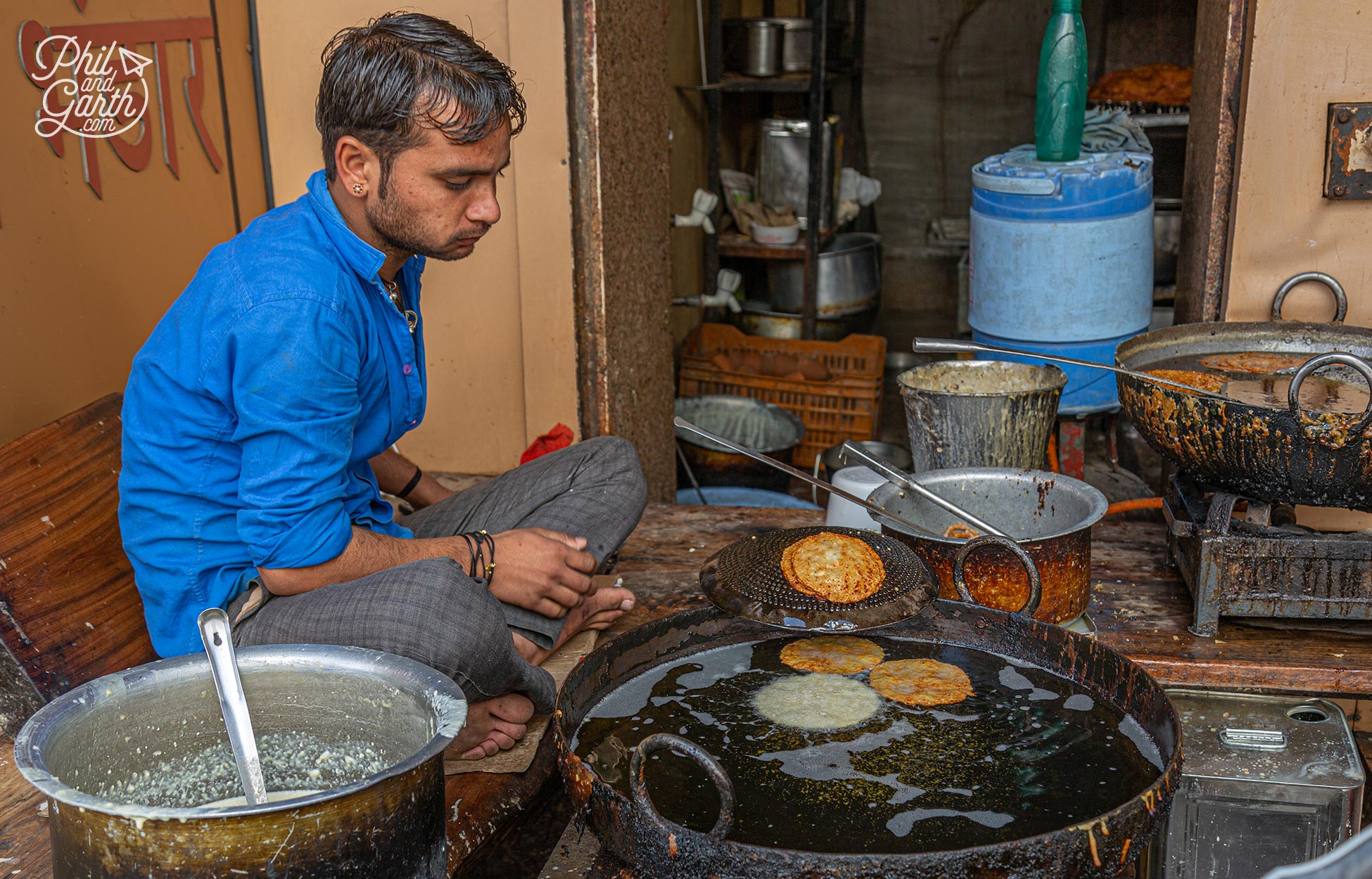
Indians do love their fried food and so do we!
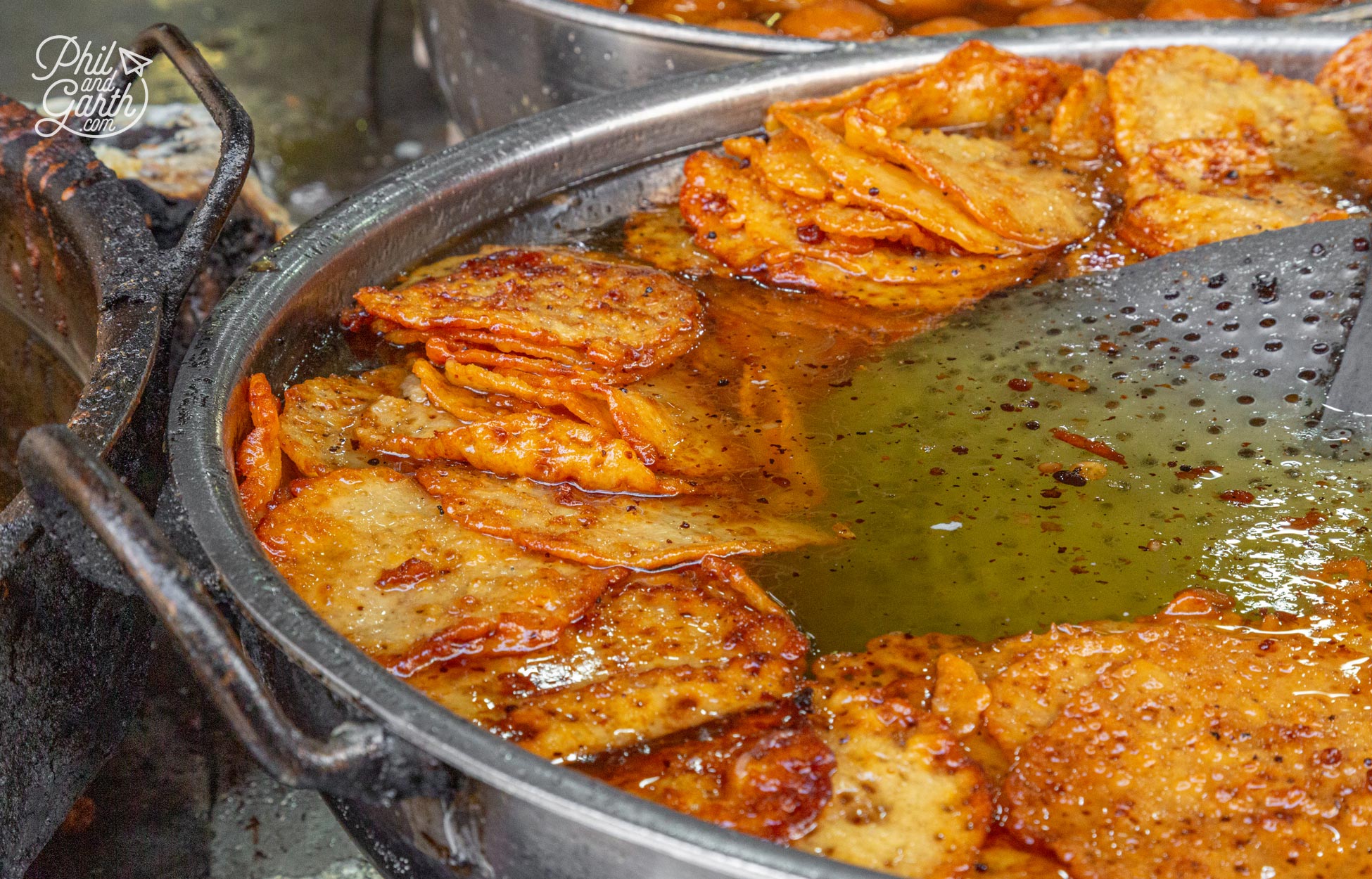
Not sure what these are, as we didn’t try them
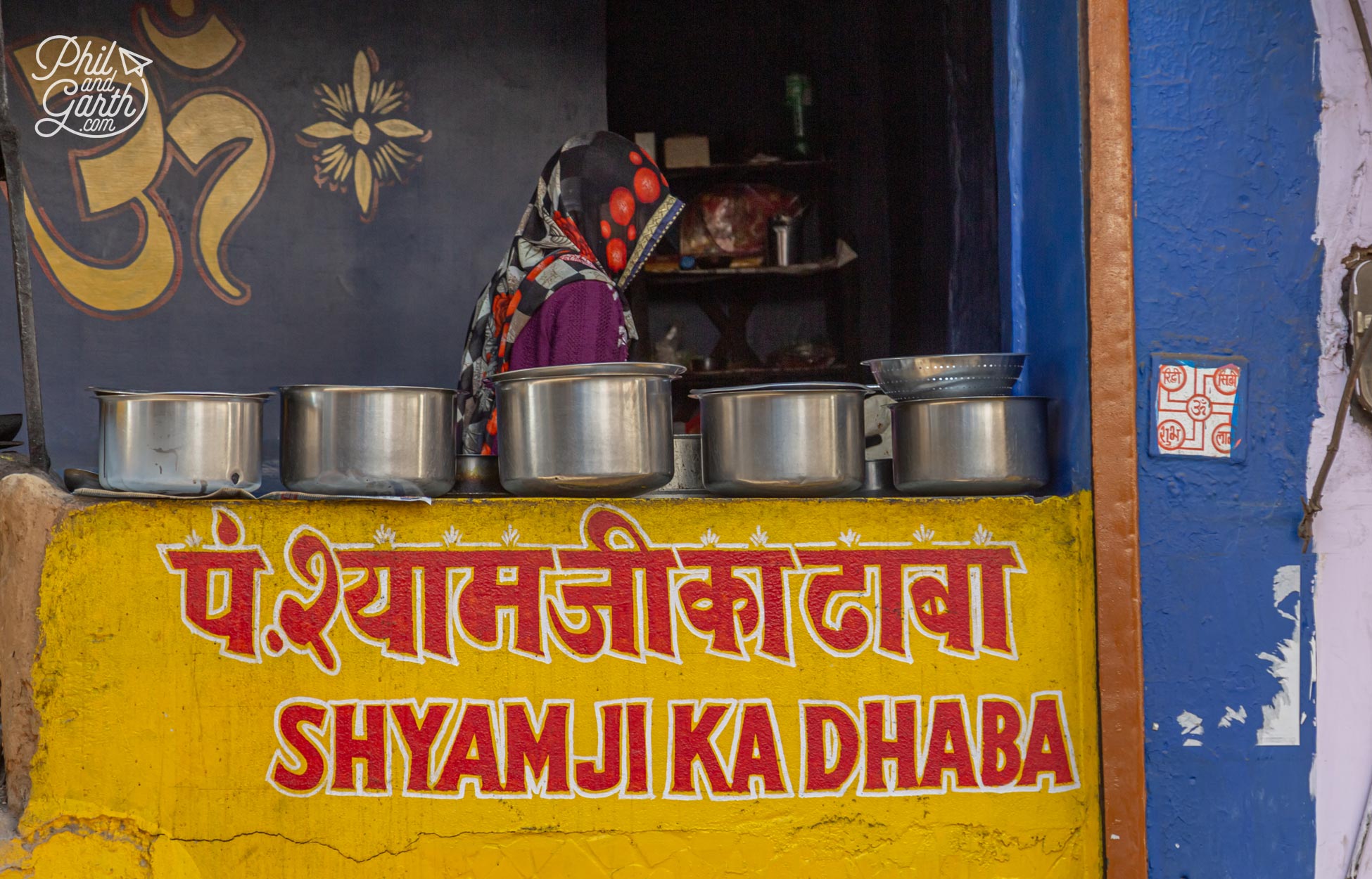
This lady was selling hot food and cold lassi
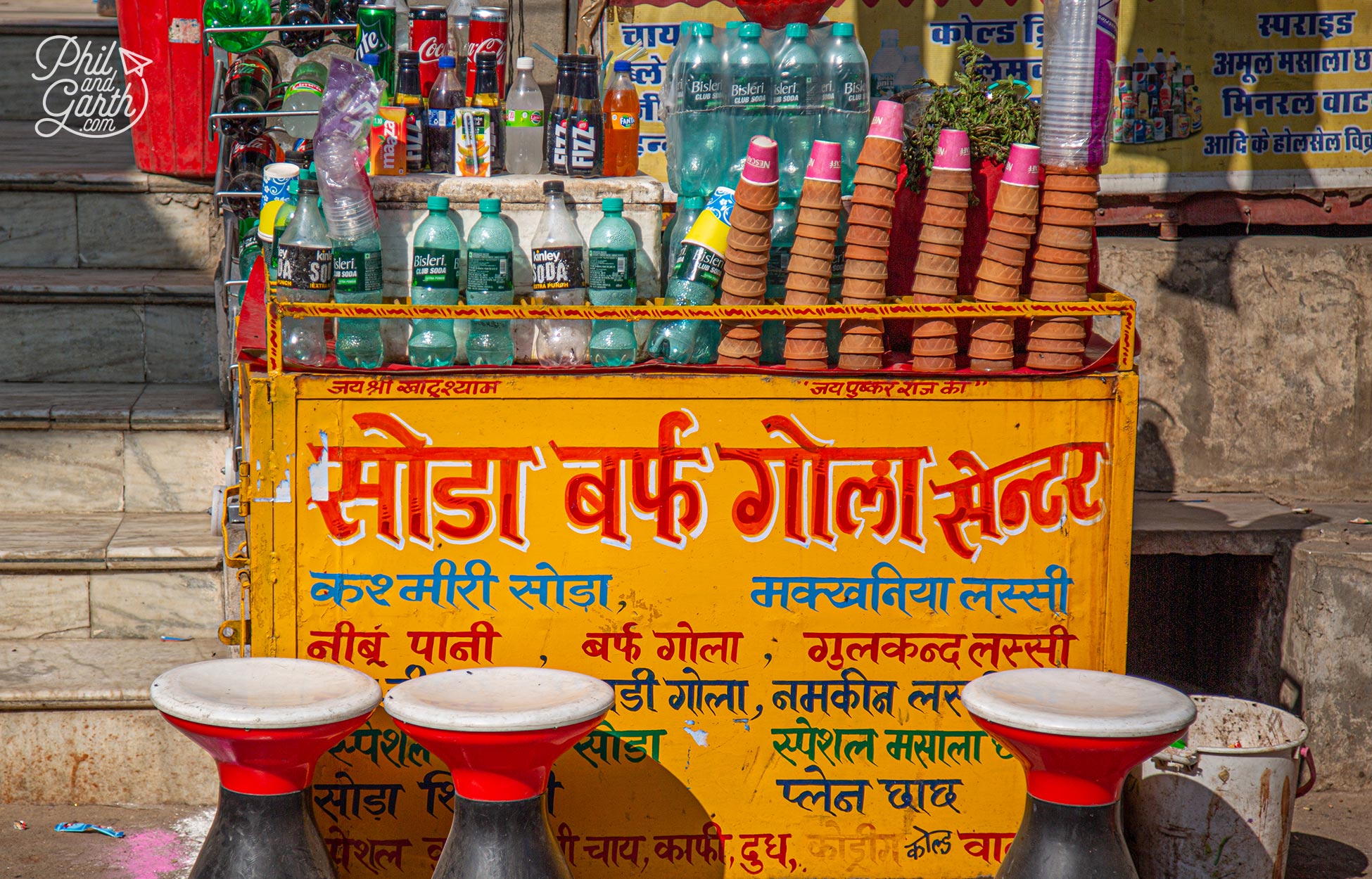
Keep hydrated at one of the many street carts selling chai in disposable clay cups and soft drinks
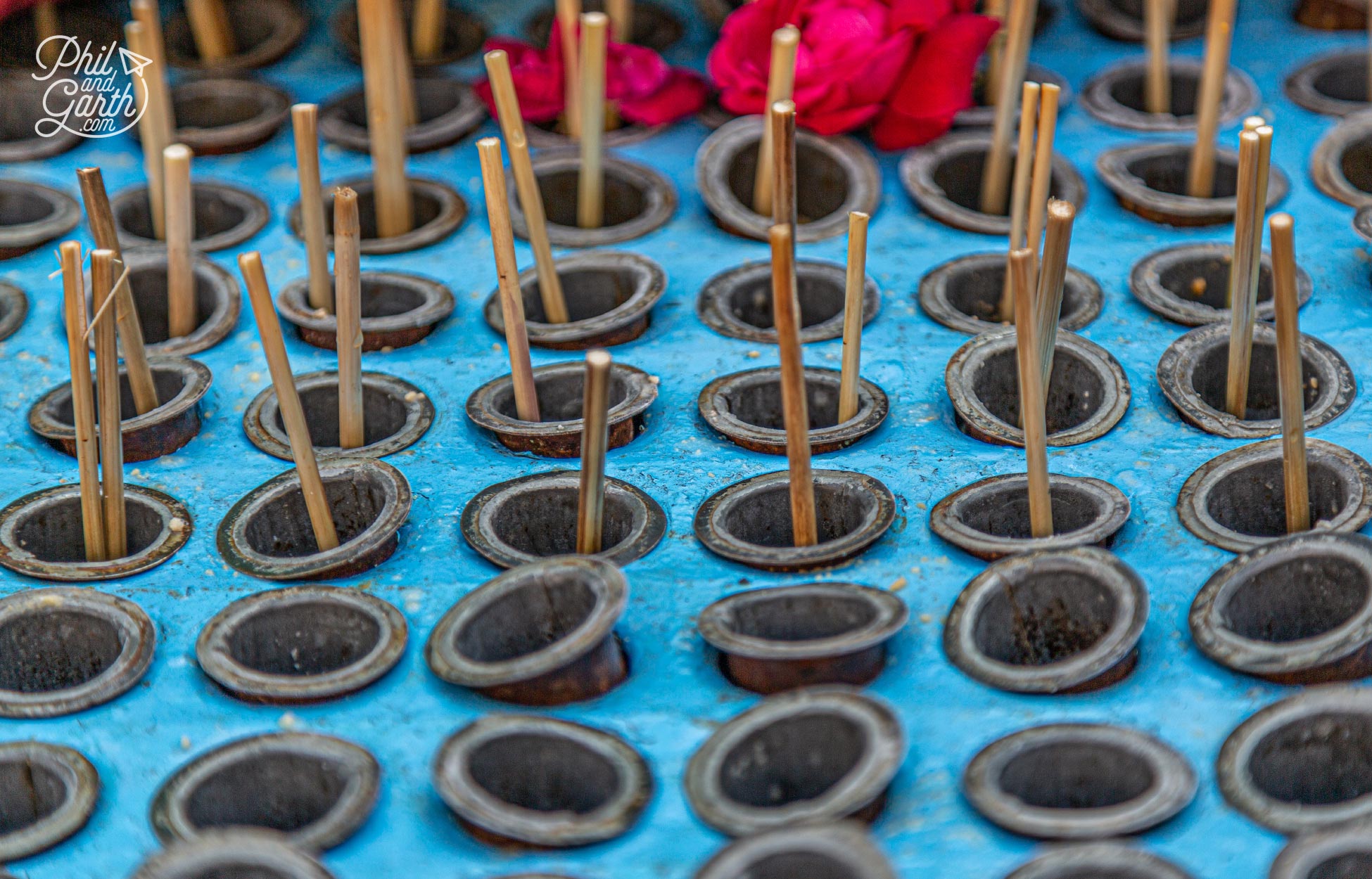
“Death on a stick!” our favourite quote of the holiday – A food cart full of iced lollipops
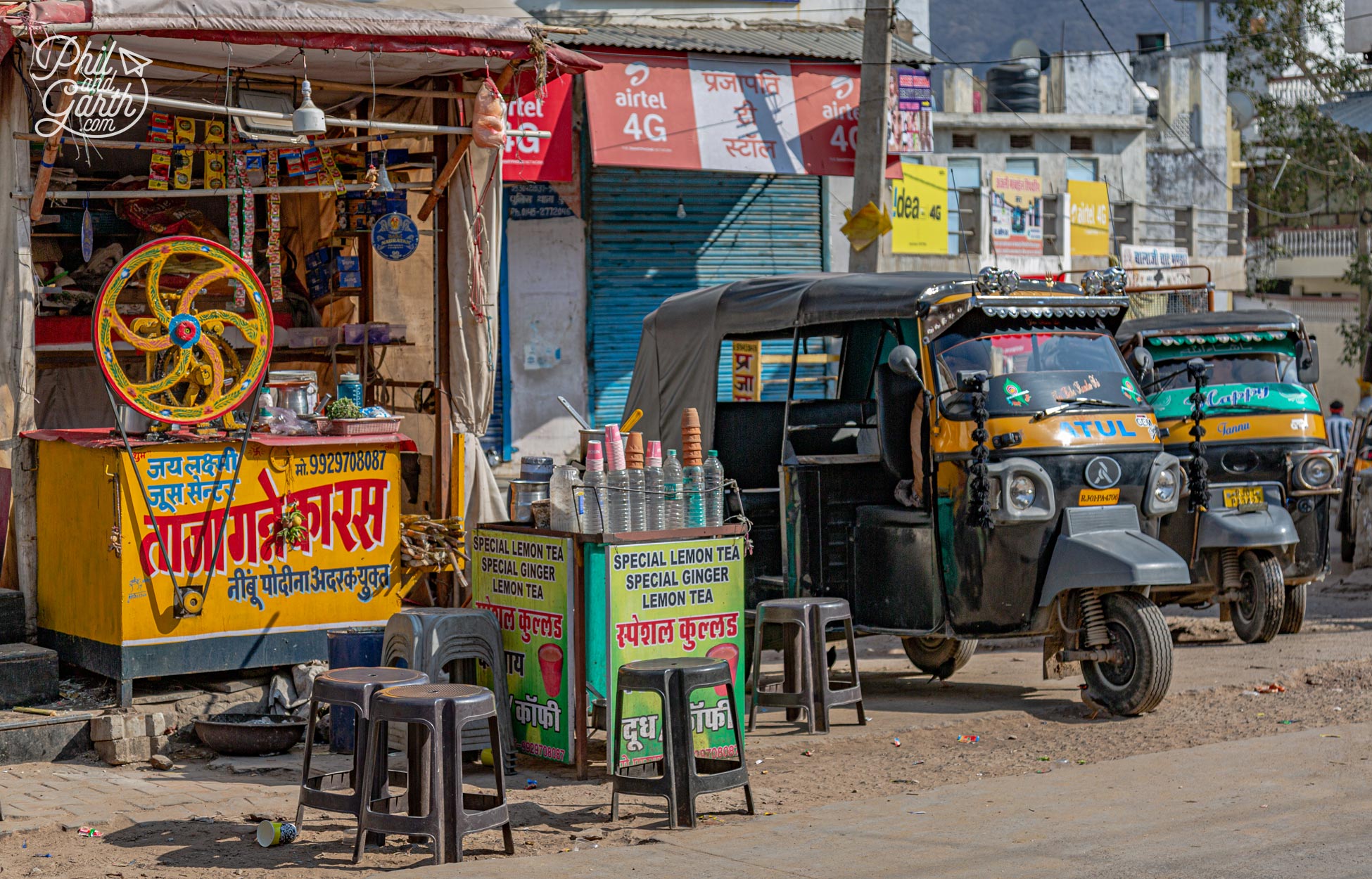
A sugar cane juice stand
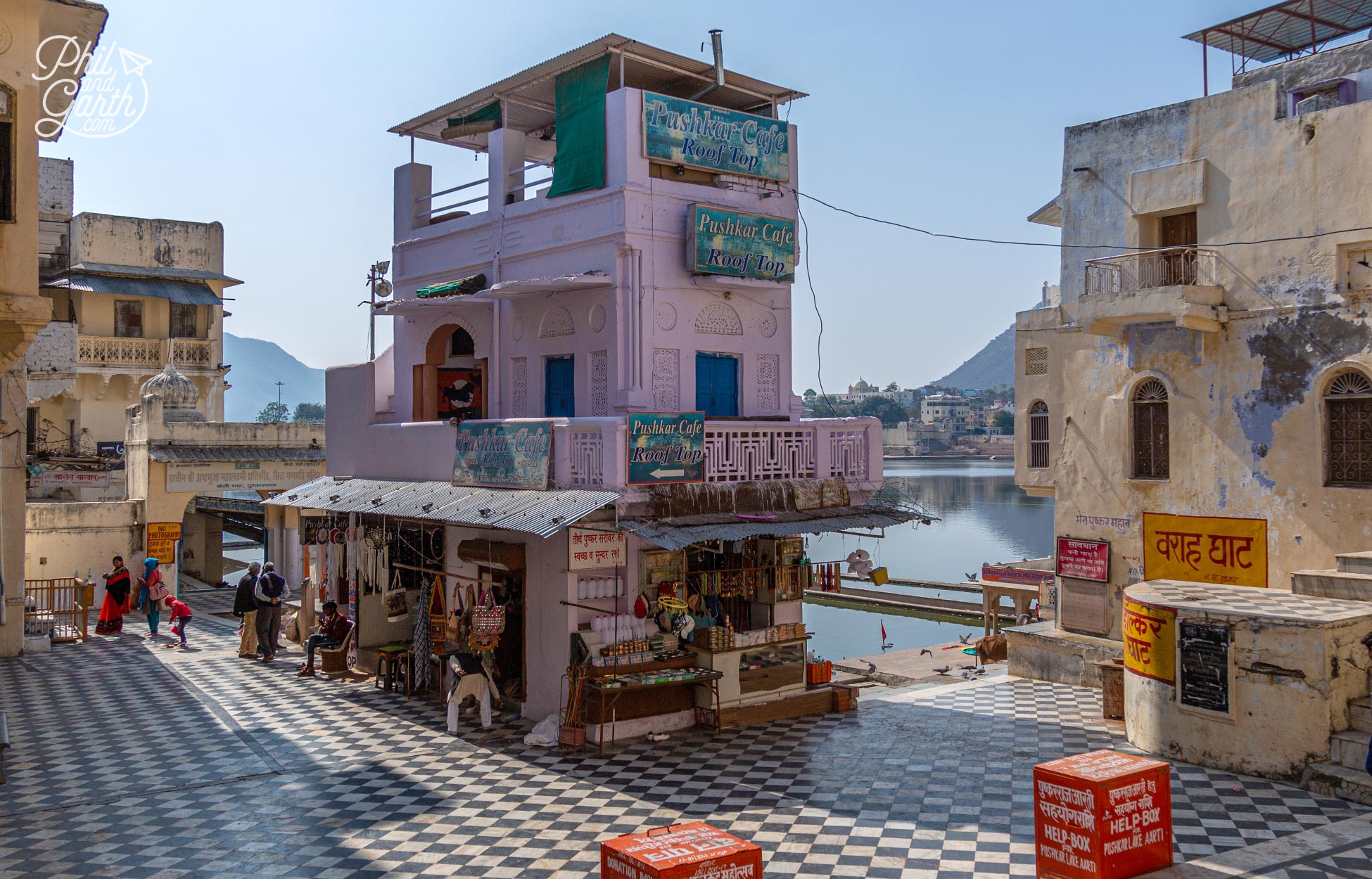
Pushkar Cafe Roof Top – a great spot for lunch and photos
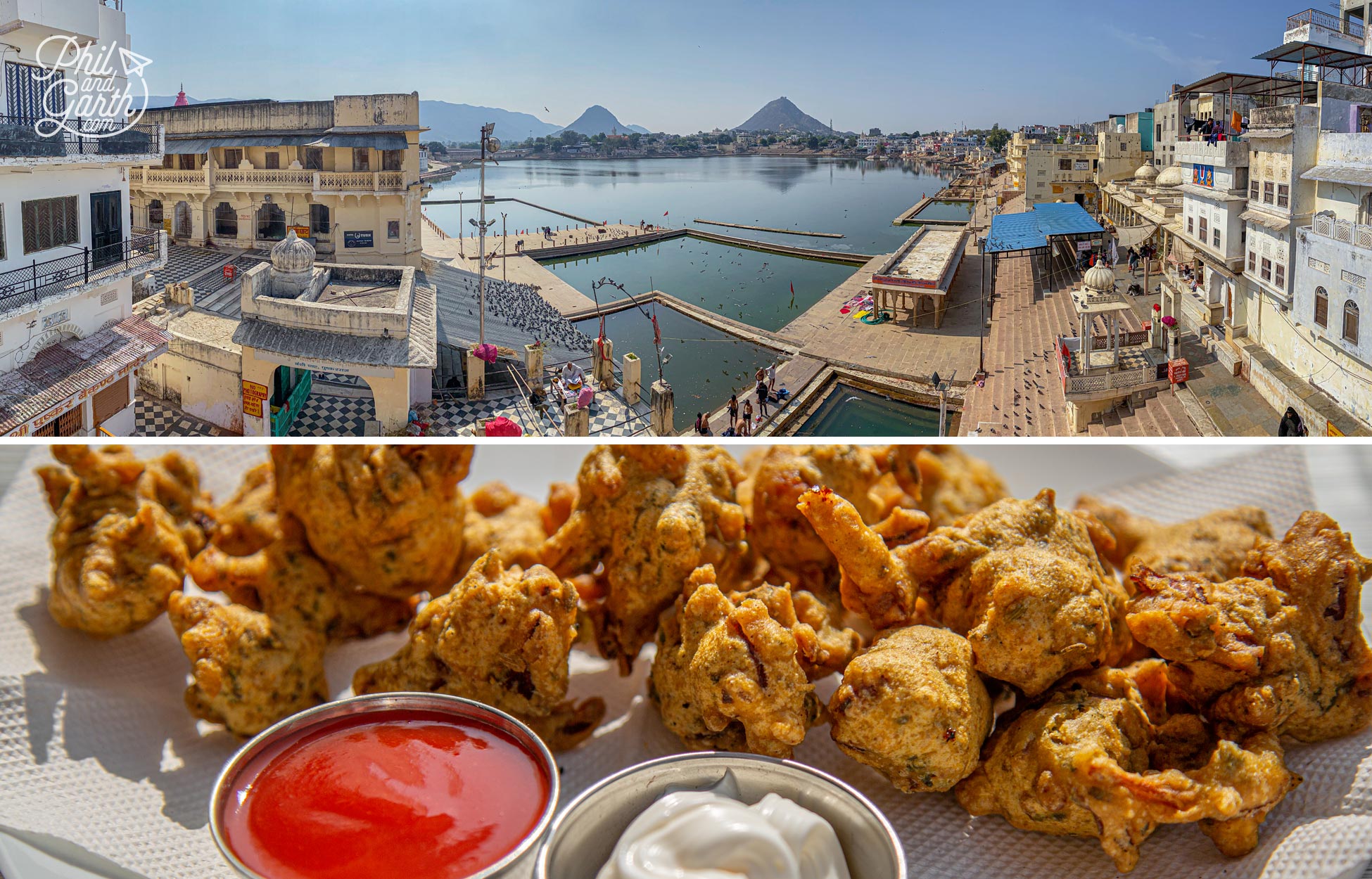
Our delicious vegetable pakoras and the fab views from the Pushkar Cafe Roof Top
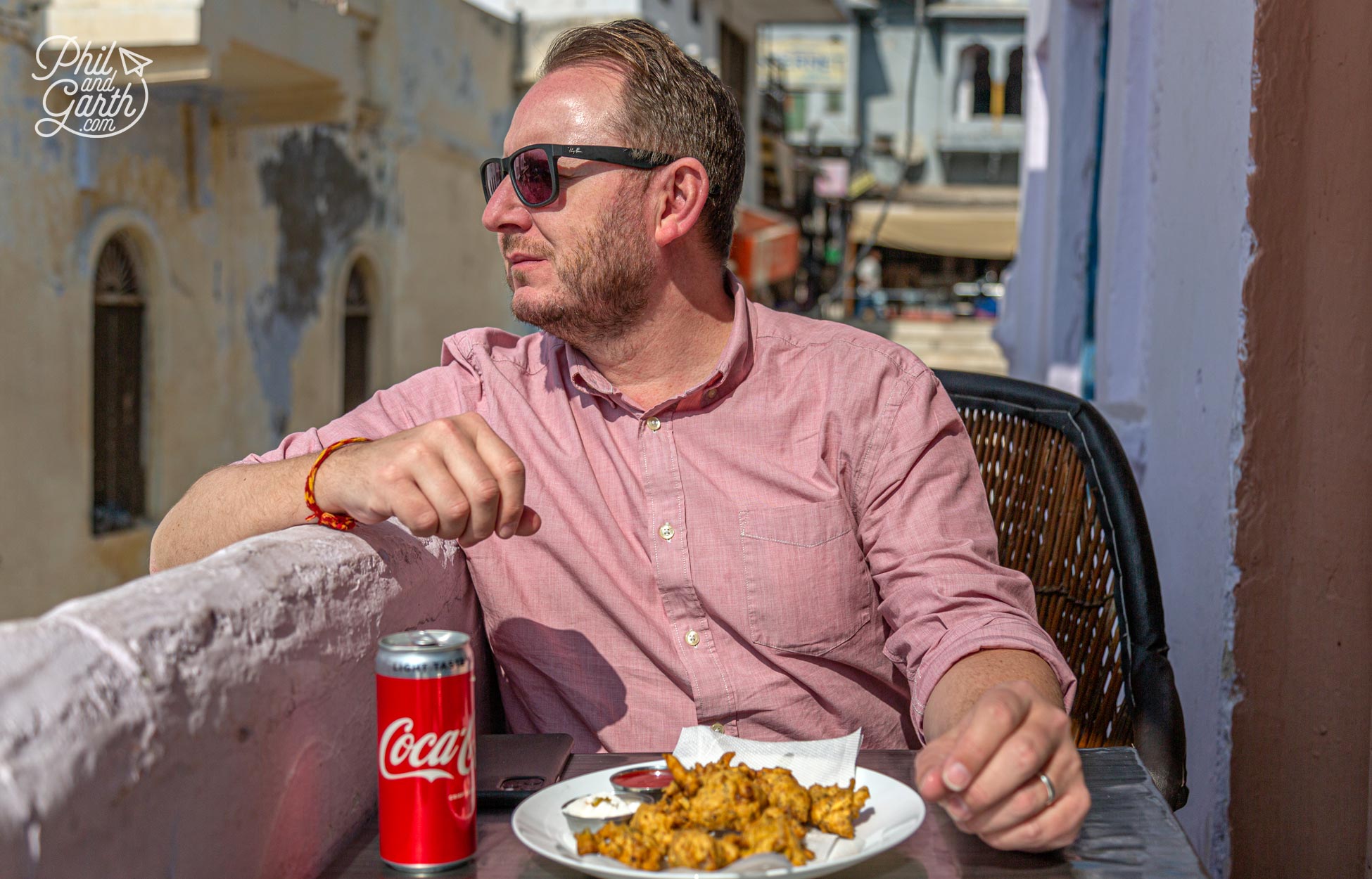
Garth taking in the views from the rooftop
On our last night, our guide asked us if we like to go for dinner at his friend’s family house. Of course, we said yes! It was really interesting to walk to the residential area and see how people lived. Not that different to us back home in England to be honest, just more modest homes. The ladies of the house were making Garth’s favourite Indian dish – a thali. Little portions of lots of dishes, it’s like India’s version of tapas. The family even had some cold Kingfisher beer ready for us! naughty but nice.
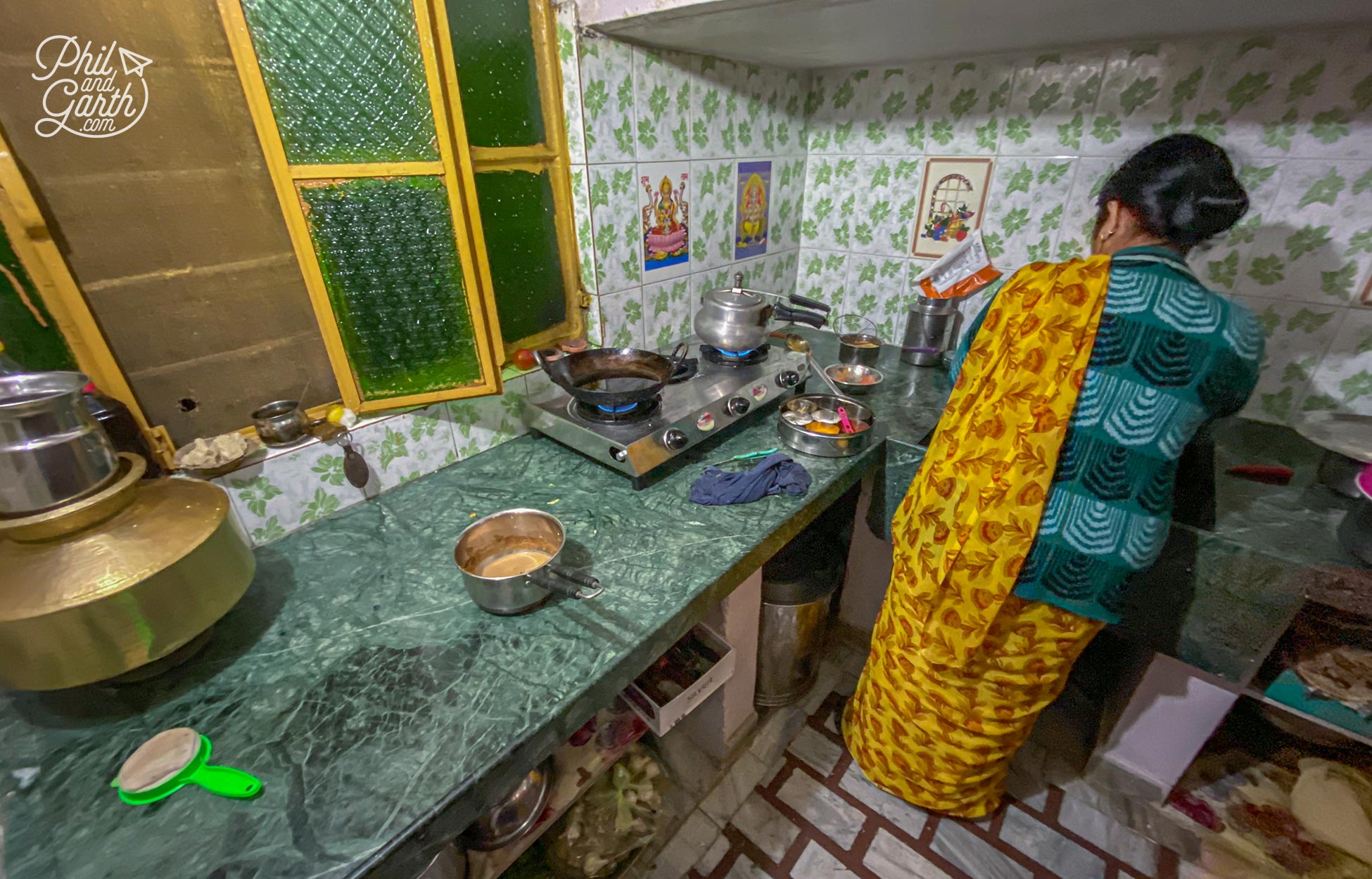
The kitchen of the family who cooked their homemade thali for our small group
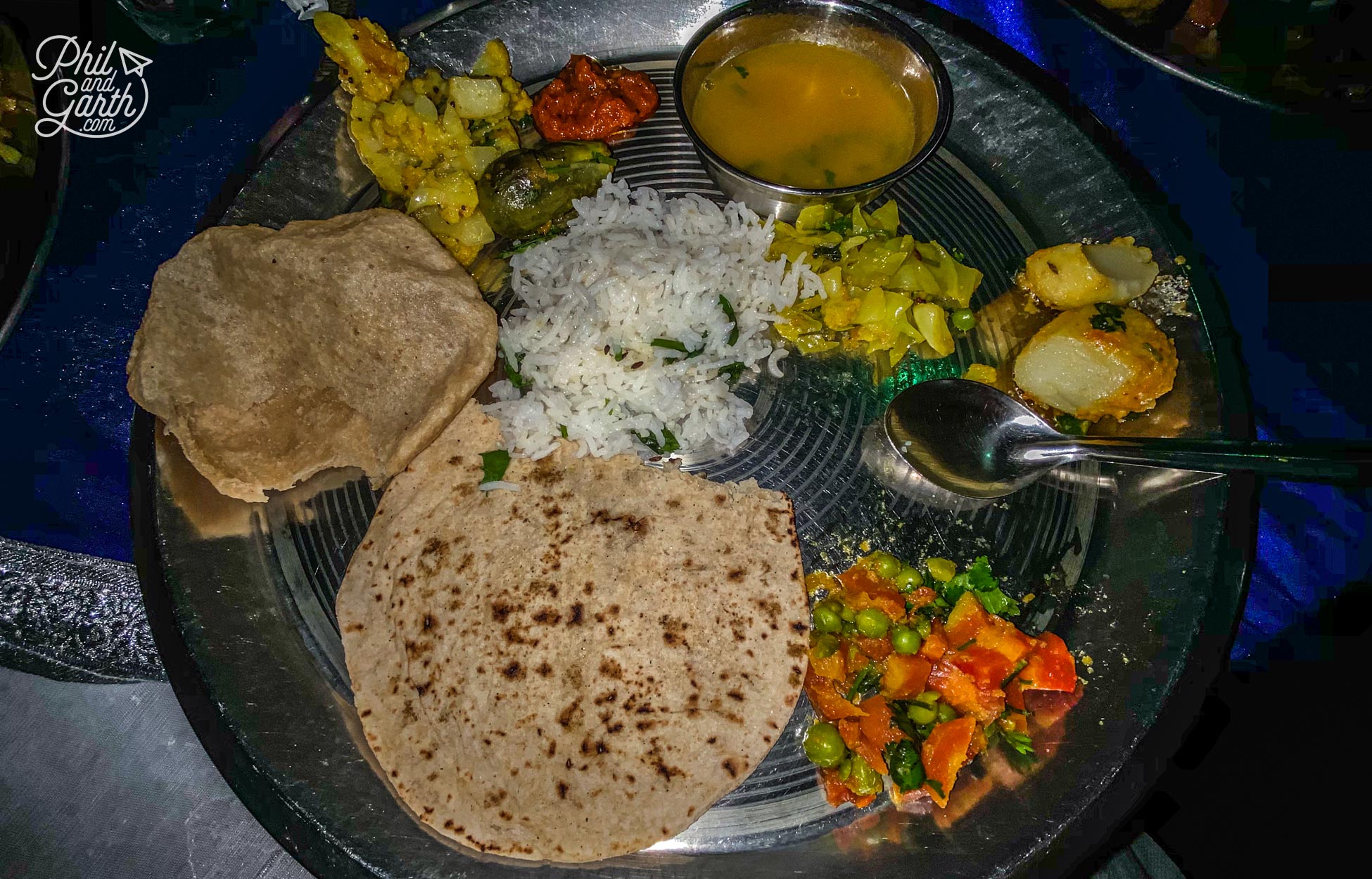
Our delicious thali dinner
Camels In Pushkar
Desert Safari Trips & Rides
We saw lots of camels in Pushkar, being in the desert it’s no wonder camels play such a big part of city life. Visitors are offered camel ‘safaris’ to the nearby desert sands. The camels we saw are gorgeous animals but they created mixed emotions for us. We’re not fans of seeing animals used for tourism, so decided against it. Most of the camels we saw didn’t look in great condition (but perhaps they were moulting) and many have the reins attached to rings in their noses. Apparently, just like horses, camels are much better suited to long journeys rather than multiple short journeys. We appreciate the camel safaris earn money for local families, but perhaps for tourists like us, they could re-invent their trips with more ethical animal interaction like we did feeding elephants in Thailand.
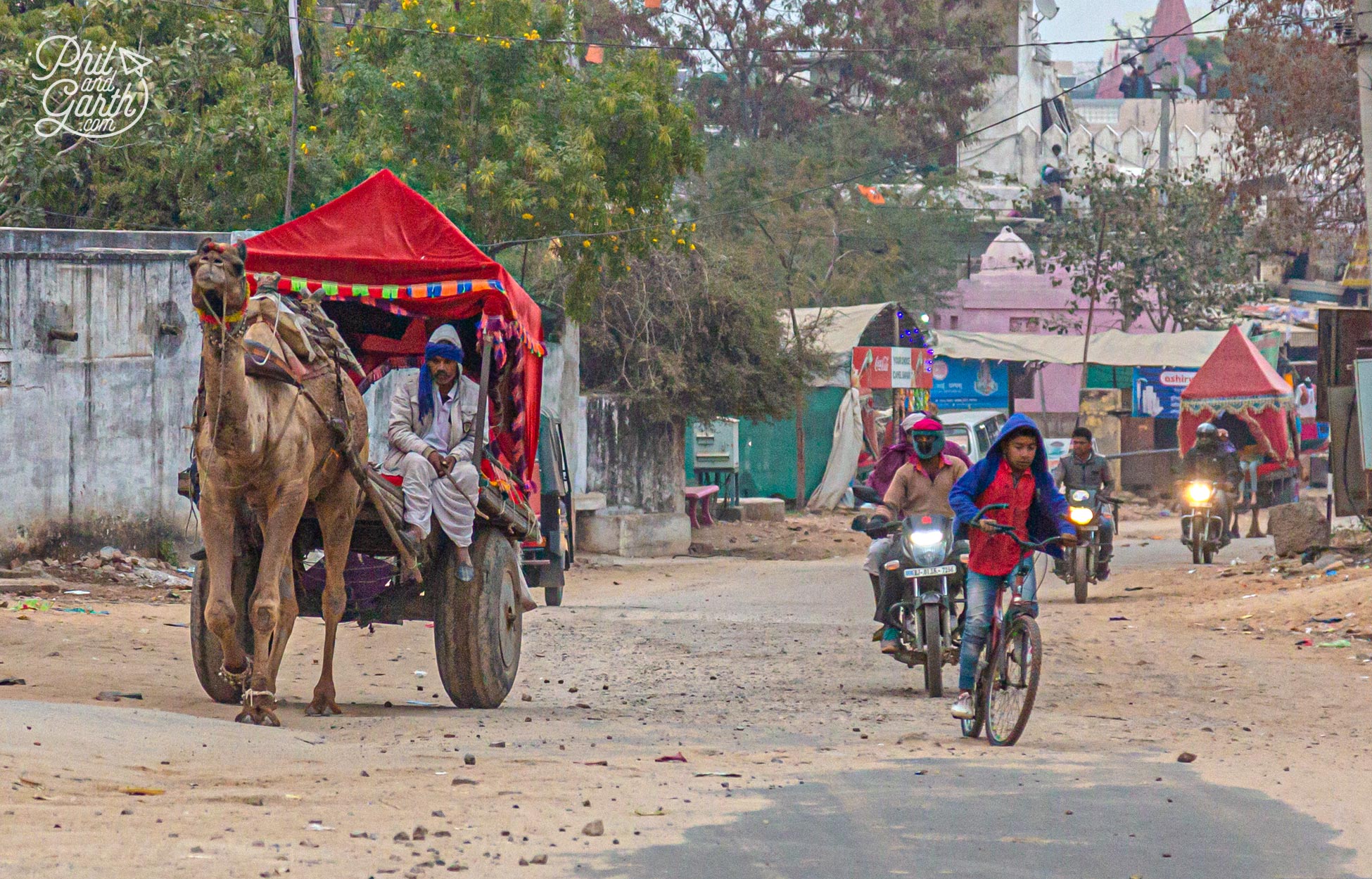
Expect to see lots of camels on the roads in Pushkar
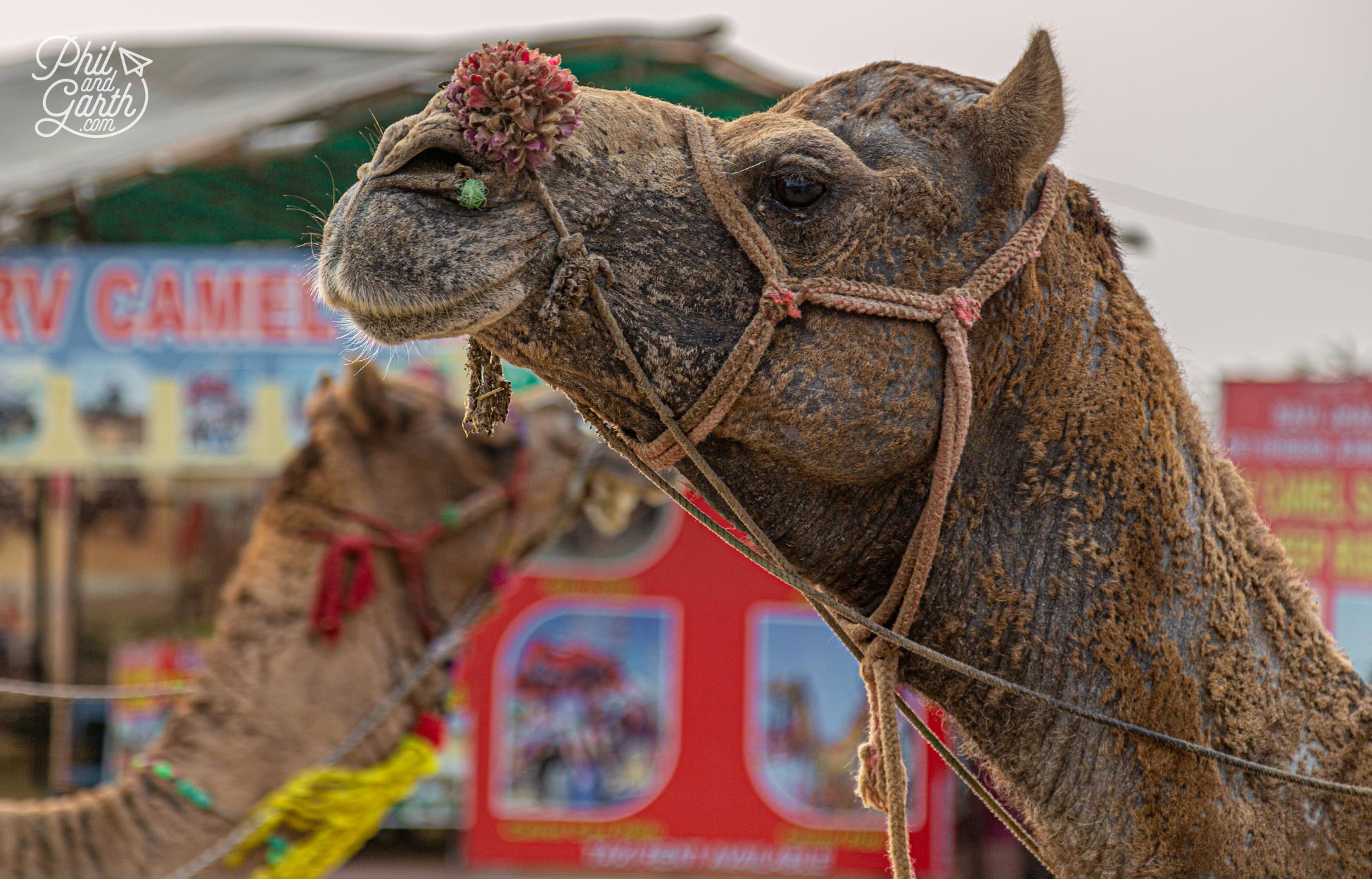
Camels waiting to go on safari
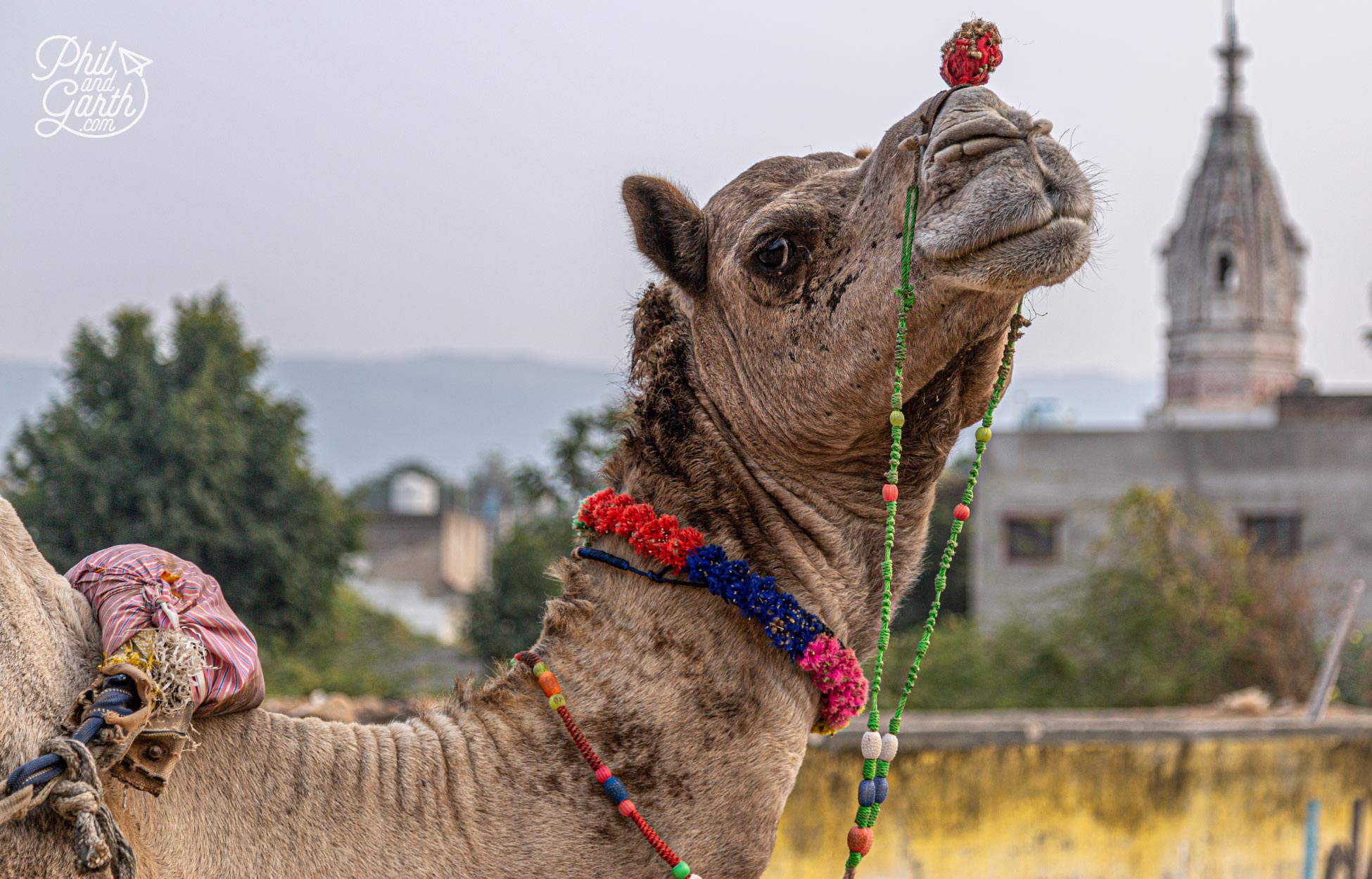
Camel safaris are a popular excursion for tourists, but not for us
Annual Camel Fair
Every year in November 200,000 people from across India descend on Pushkar for the annual Camel Fair. It’s one of the world’s biggest livestock fairs where traders come to buy and sell camels, horses and cows across 7 days. Camels are dressed in bright colours and also take part in races. It sounds like quite a spectacle and popular with Indian tourists and photographers. The Mela also holds competitions for the best moustache, photography, best bride, cricket games, acrobatics and puppet shows.
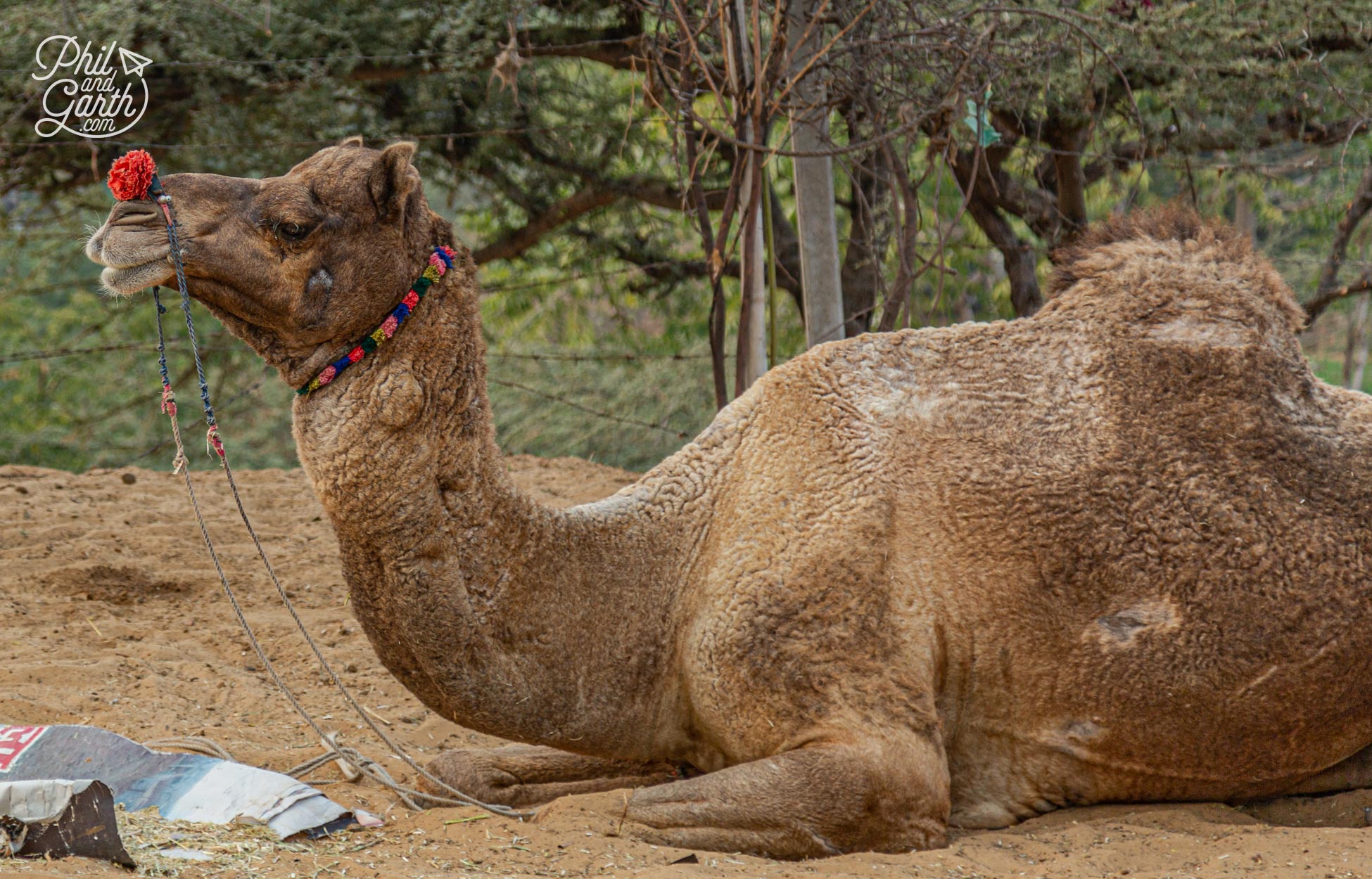
Every year in November 200,000 people come for the Pushkar Camel Fair
Street Photography
One of the best things to do in Pushkar is to simply wander the streets. We spent a fair bit of our time just walking the ghats, bazaars and back streets – soaking up the daily life go by. We love doing this when abroad and especially when we find ourselves somewhere exotic like India. We saw more animals on Pushkar’s streets than anywhere else we visited in India, including dogs, cows, pigs, camels and monkeys.
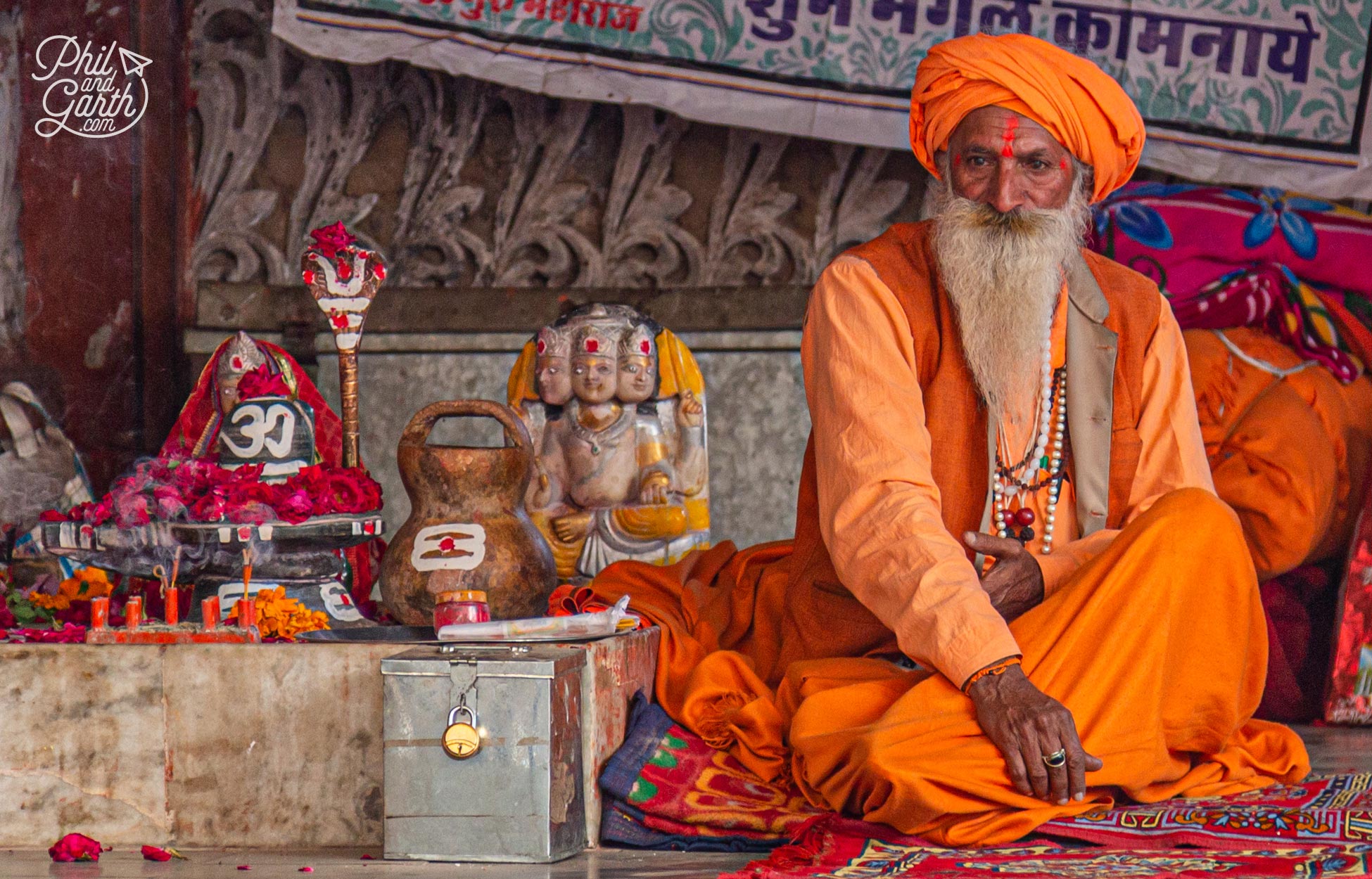
There are many sadhus in Puskar they are holy people who dedicate their lives to Hinduism
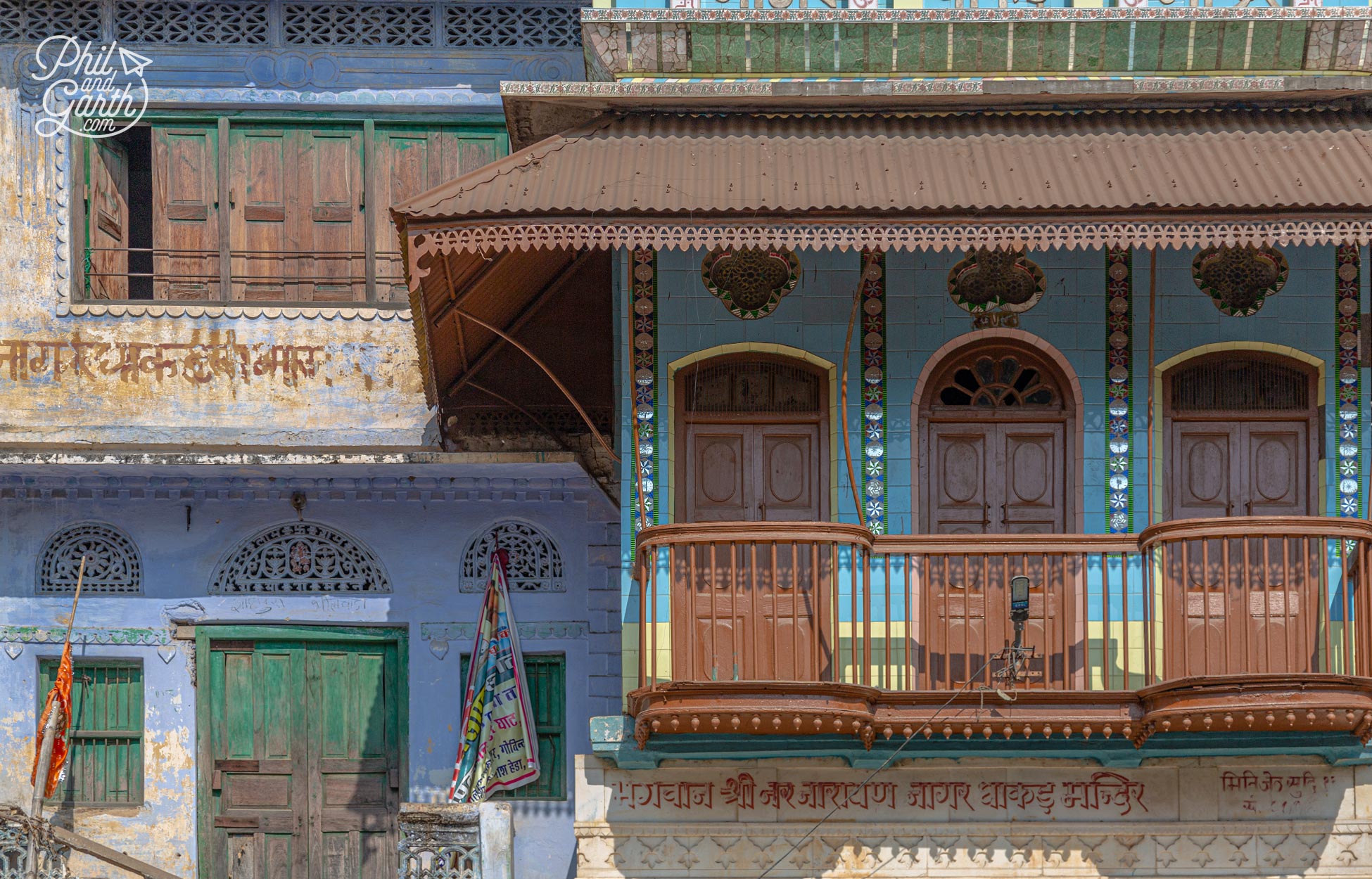
Some gorgeous textures and decoration on this building
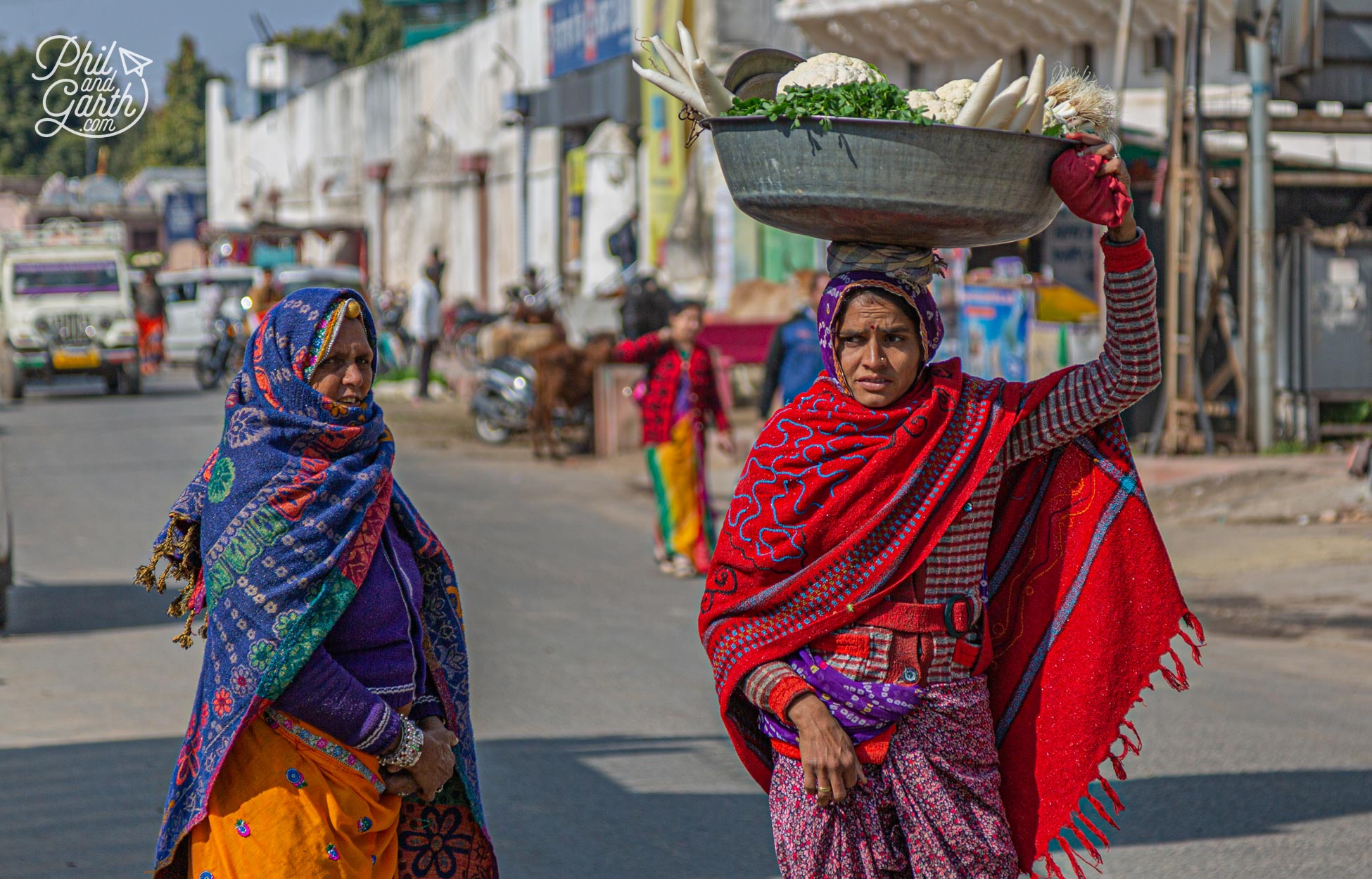
A couple of ladies wrapped up warm
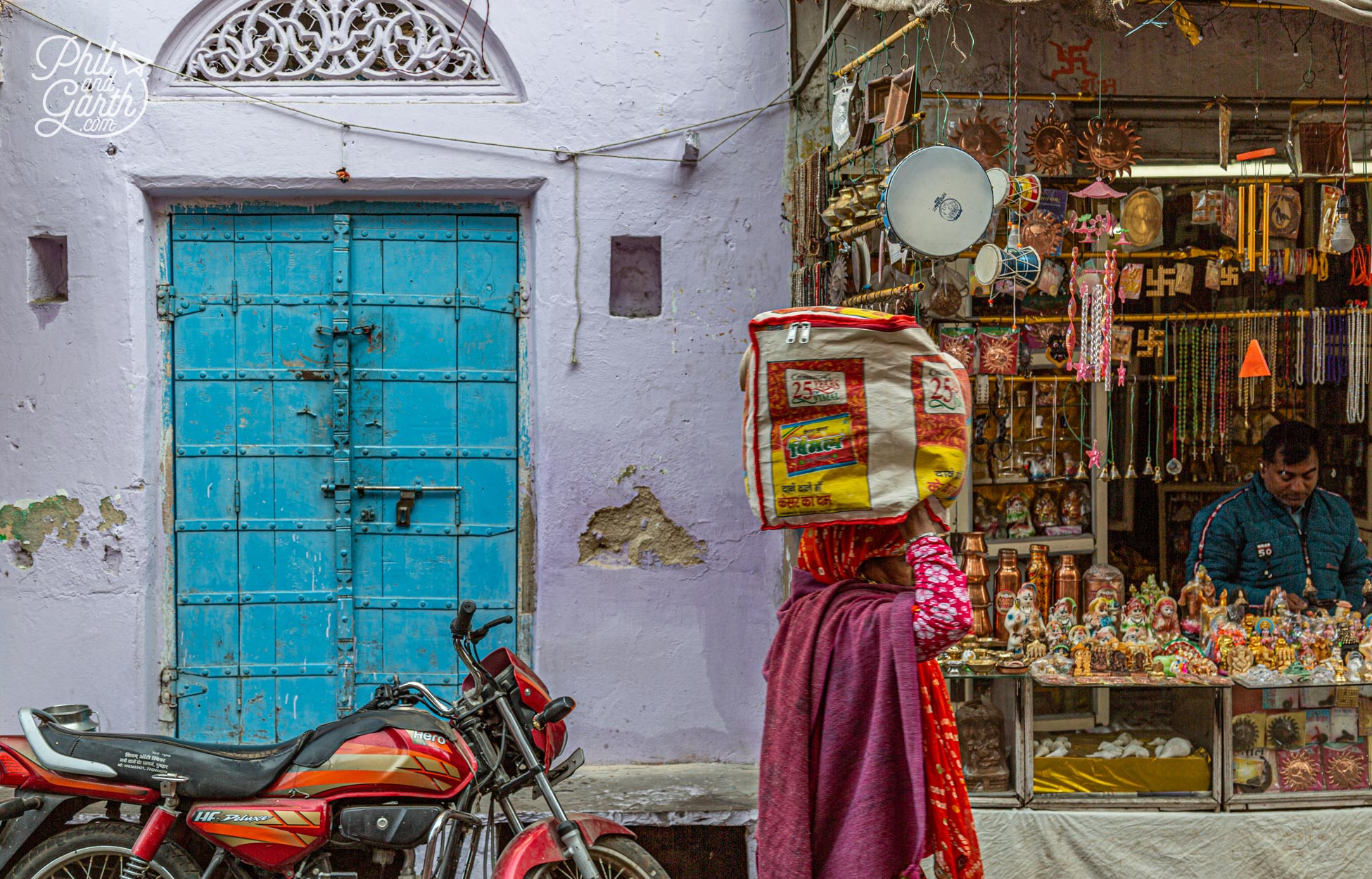
Look out for all the colourful doors in Pushkar
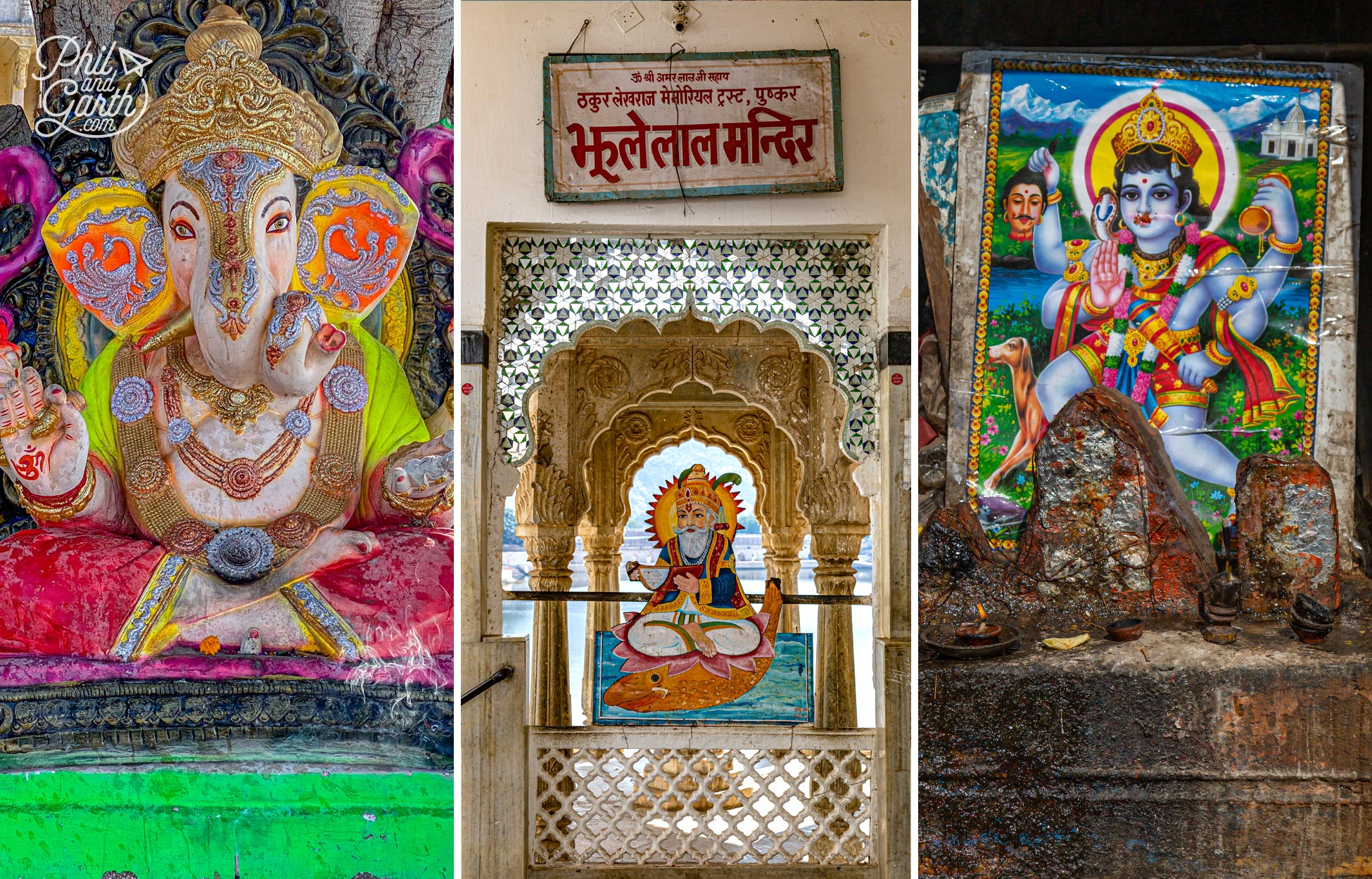
So many shrines to various gods all over Pushkar
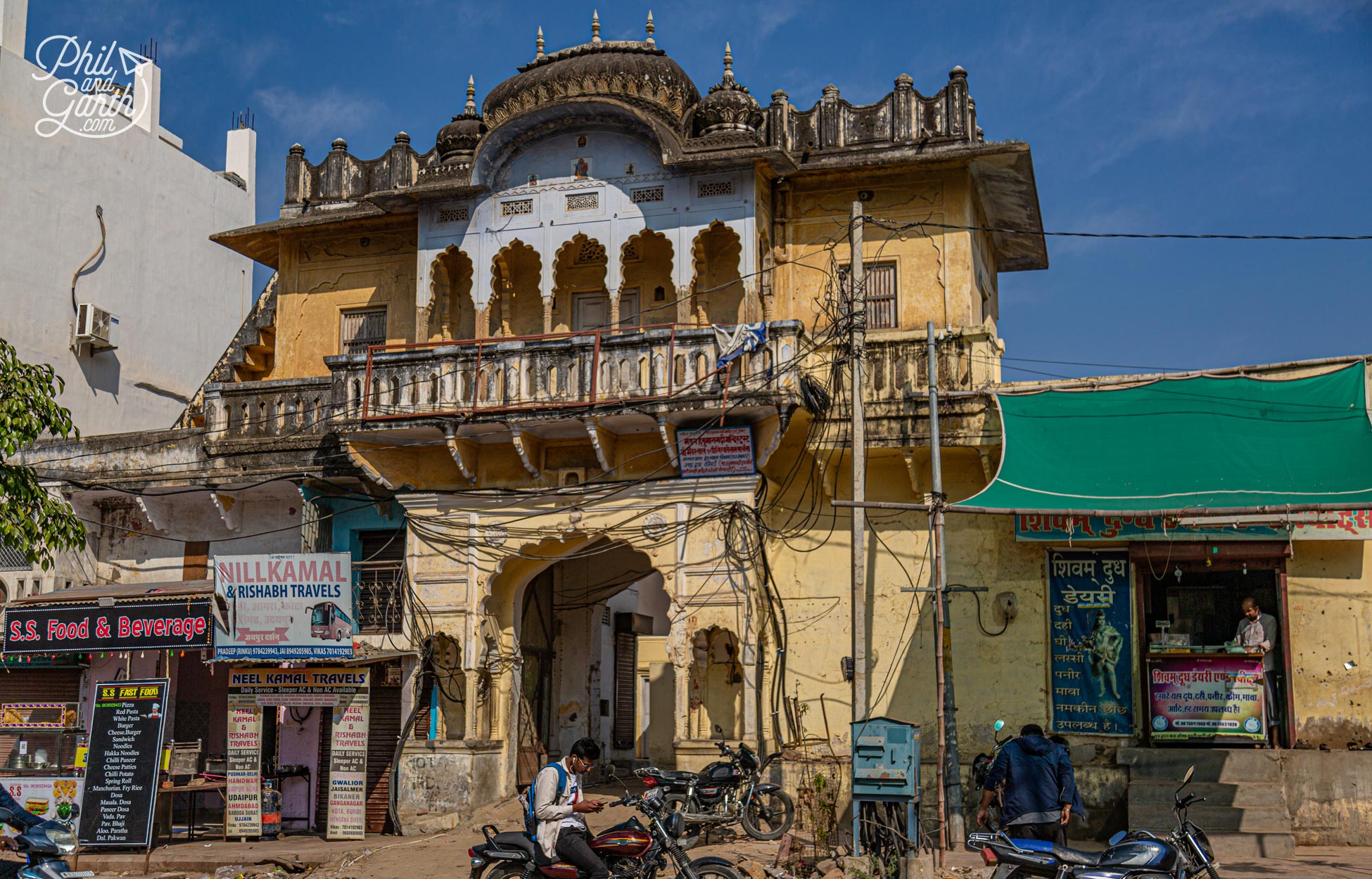
Looks like this could be another temple
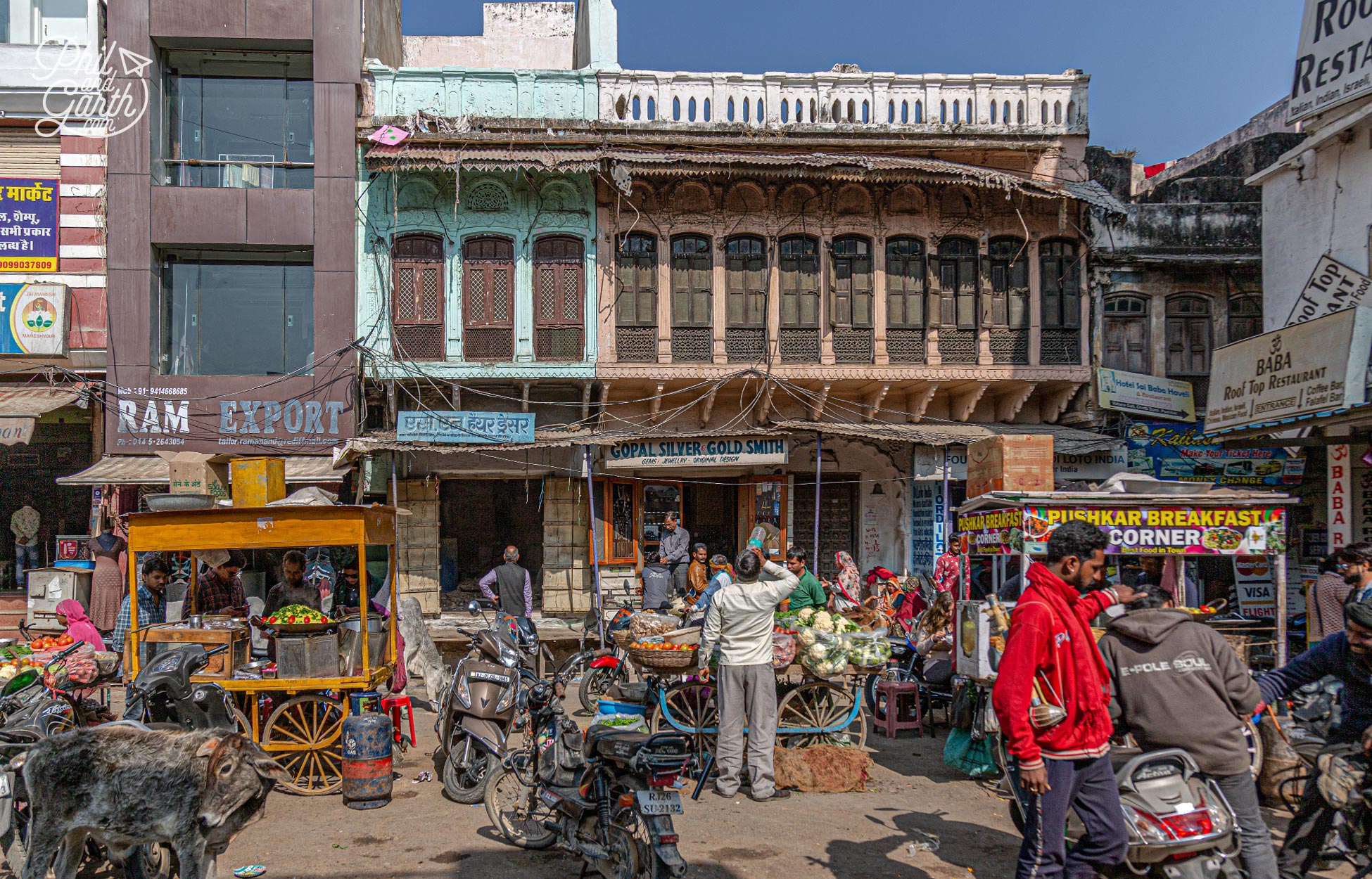
A typical street corner
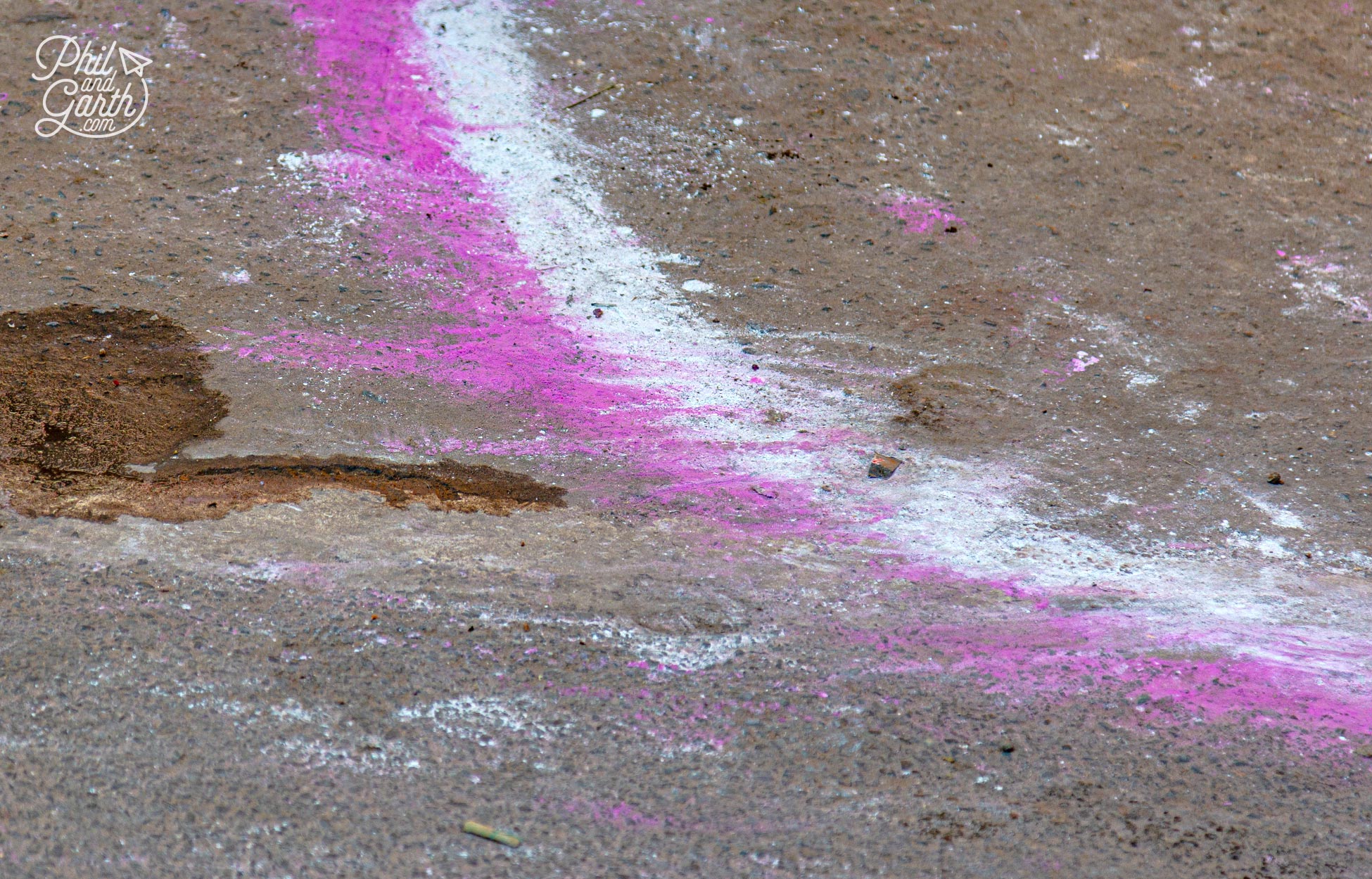
If you see a chalky powder trail on the streets like this, it’s to lead guests to the venue of a wedding
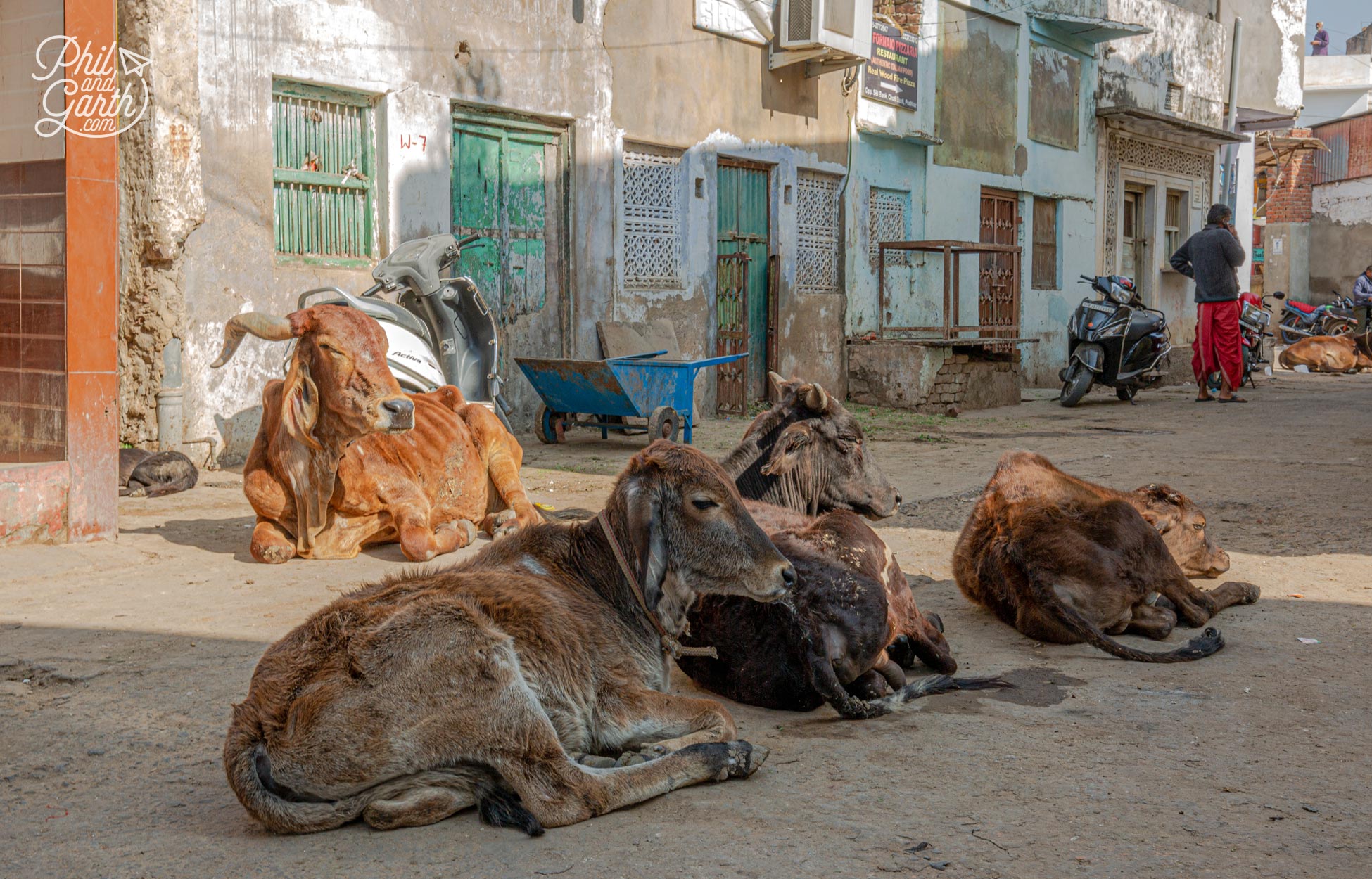
We found this group of holy cows resting in a back street
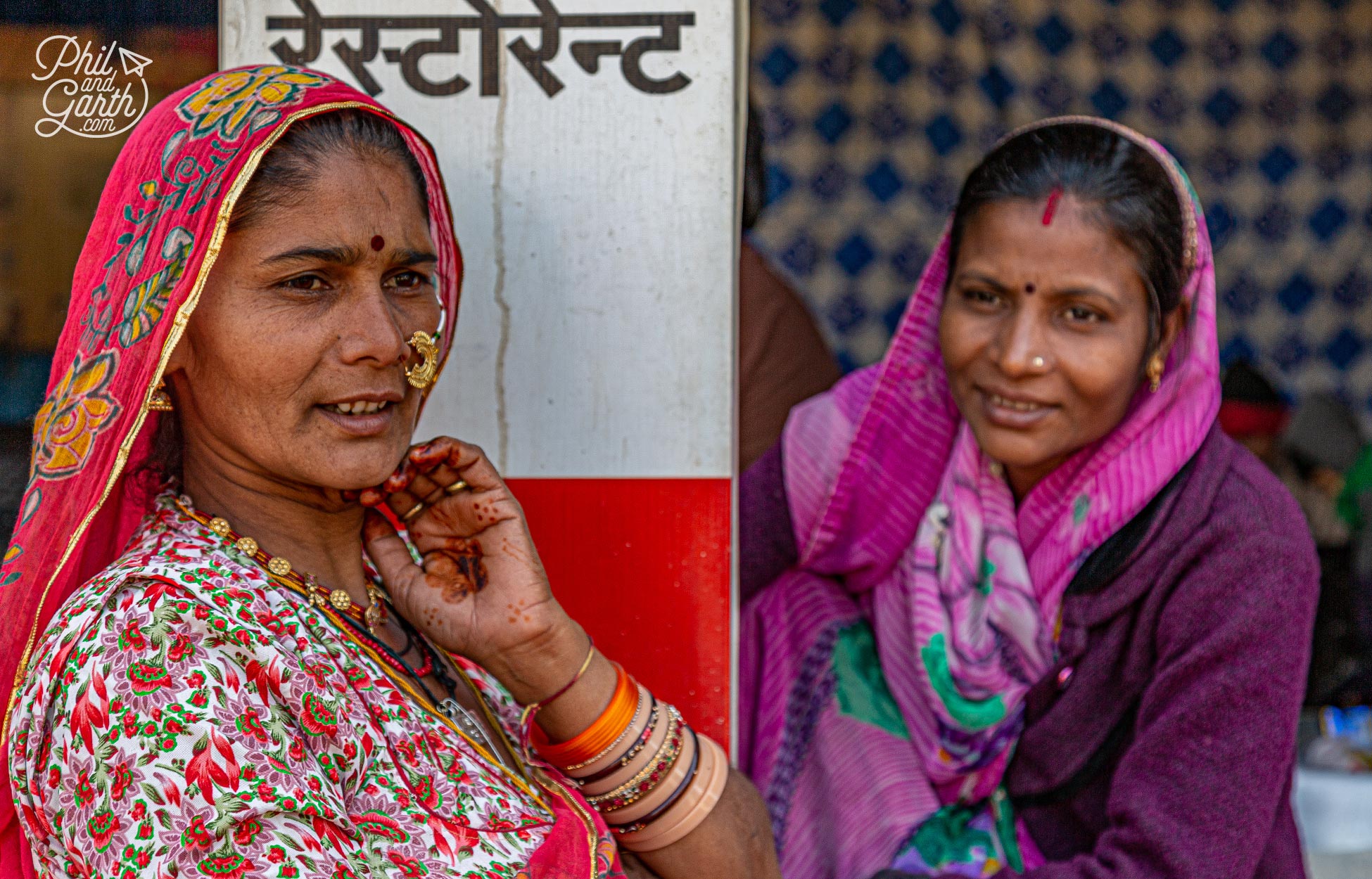
These two ladies kindly agreed to let Garth take their portraits
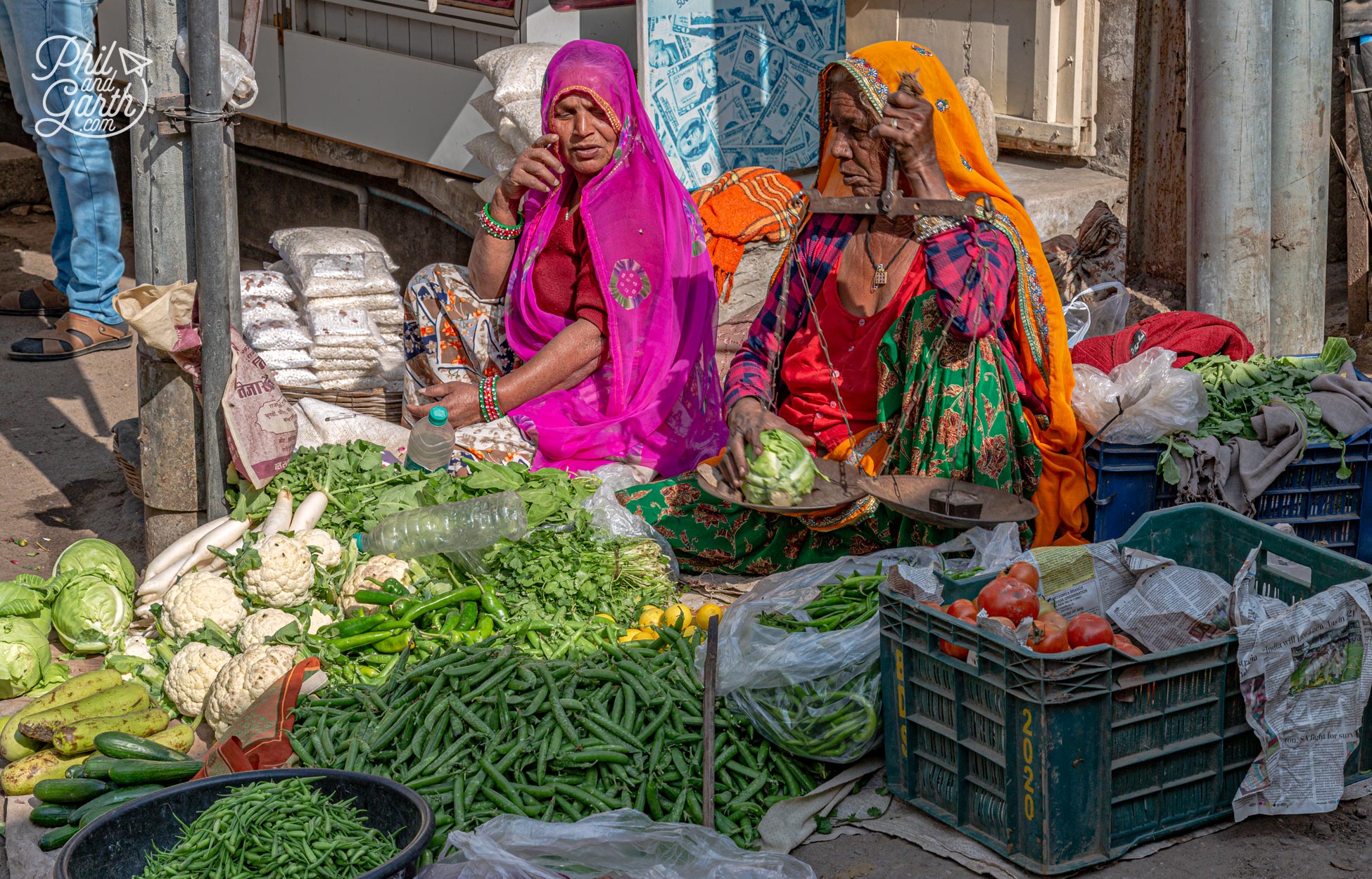
A couple more ladies selling vegetables on a street corner
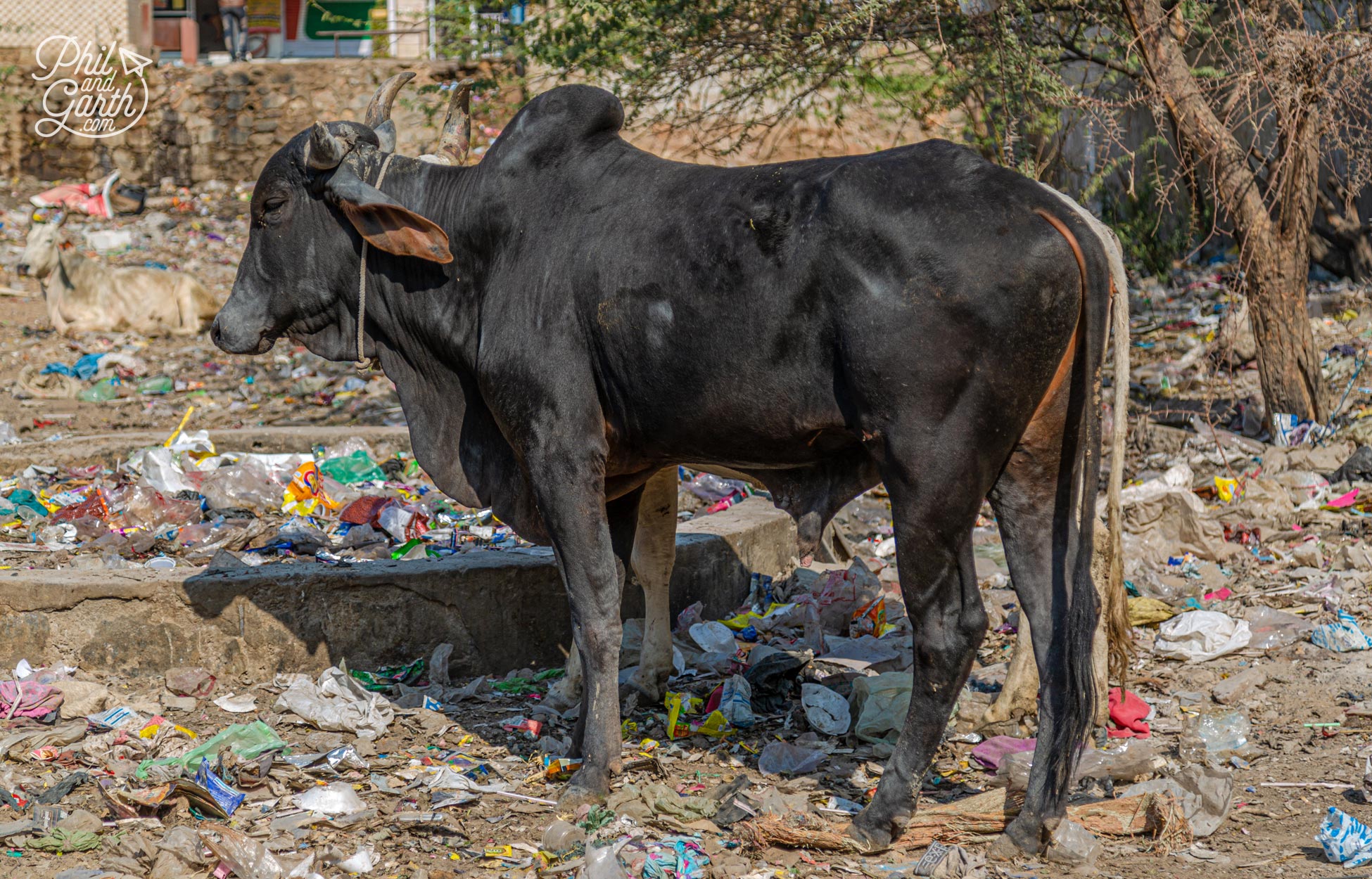
Cows eating what food they can find in the rubble and rubbish
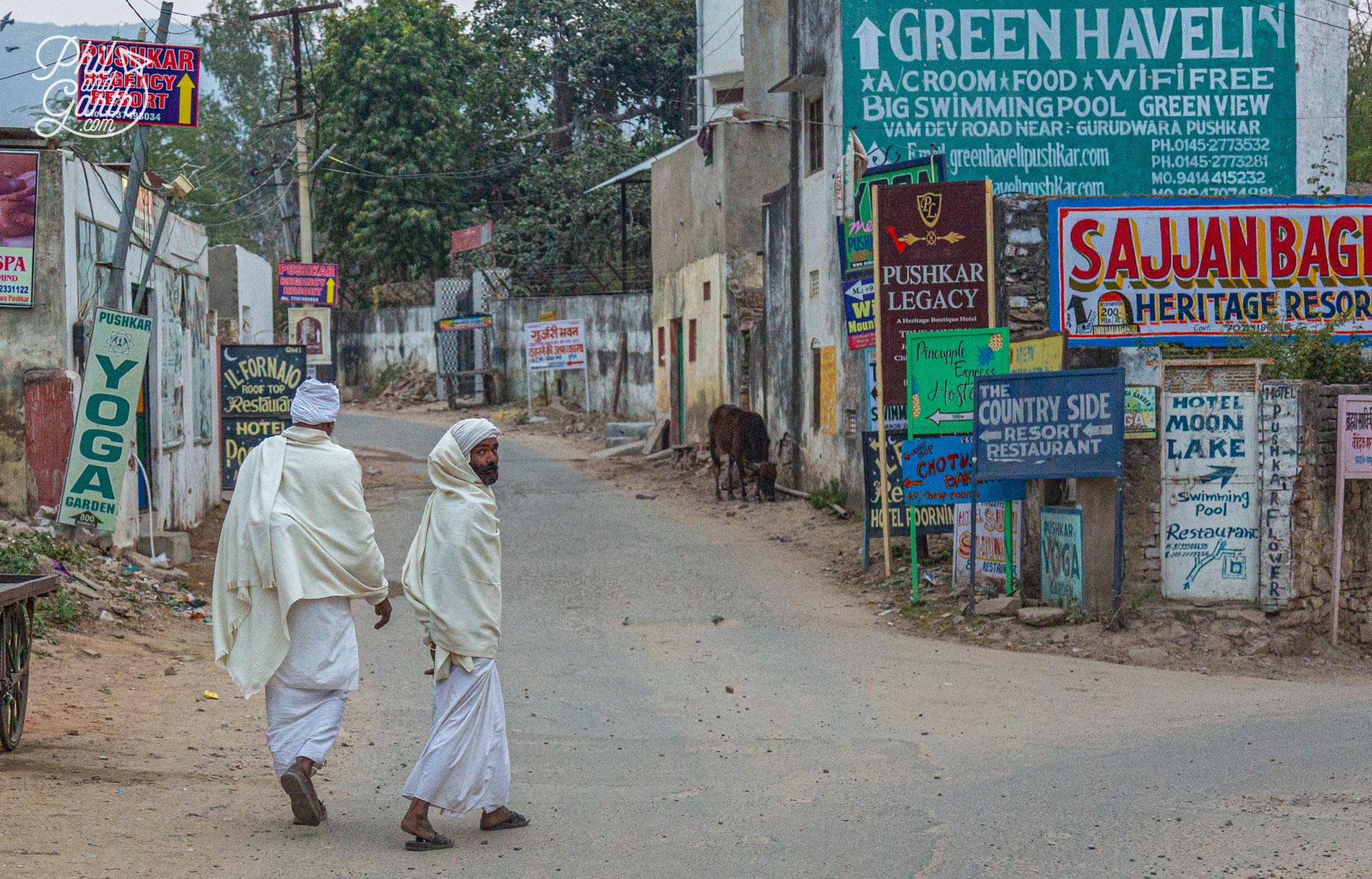
Walking back to our hotel
Other Pushkar Attractions
- Gurudwara Singh Sabha – Sikh temple dedicated to two Sikh Gurus who visited Pushkar.
- Old Rangji Temple – A beautifully carved temple made out of marble, close to Varha Ghat.
- Man Mahal – A grand palace built as a royal guest house. It’s now a luxury heritage hotel.
- Hot Air Balloon rides – For aerial views of Pushkar during Pushkar’s 3-day annual hot air balloon festival.
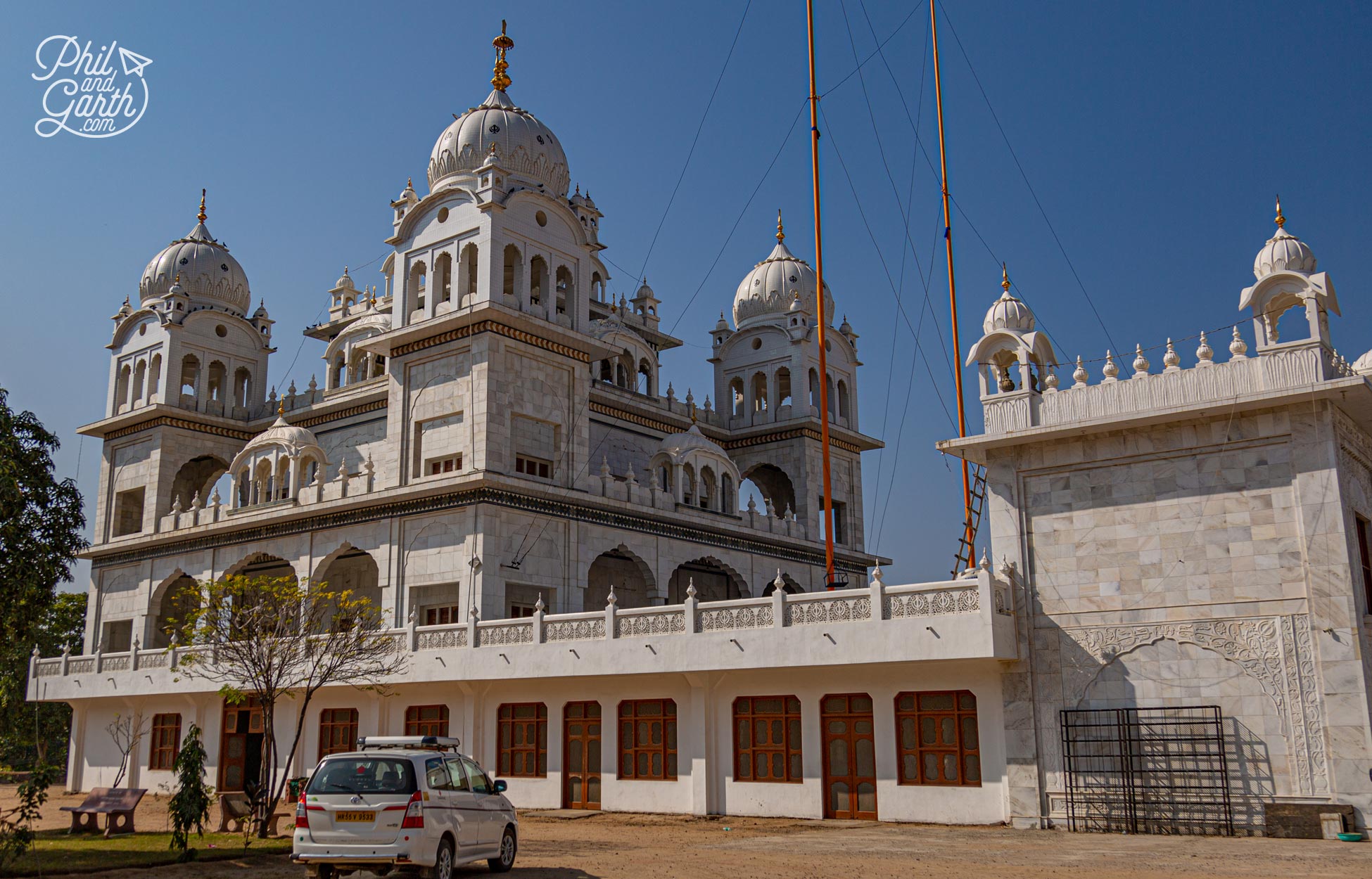
The Gurudwara Singh Sabha, a grand Sikh temple
Pushkar Practical Information & Useful Advice
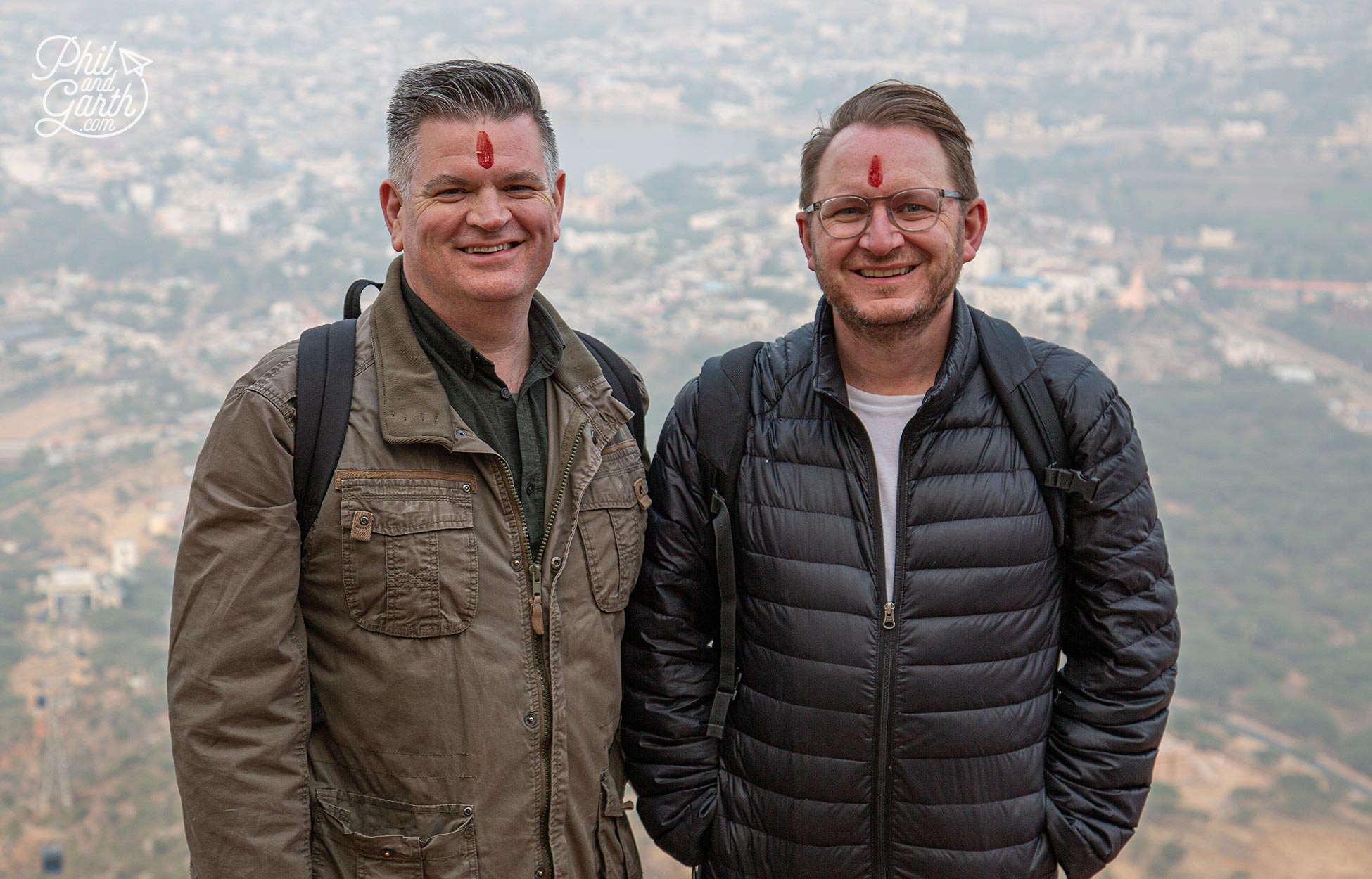
Phil and Garth’s Top 5 Pushkar Tips
Phil and Garth’s Top 5 Pushkar Tips
- Tip #1: October and November will be packed – hotel prices soar with the annual camel fair.
- Tip #2: Dress respectfully. Men should wear full length trousers & women cover shoulders, legs and ideally your hair.
- Tip #3: Take extra pairs of socks for walking around the ghats so you are not barefoot.
- Tip #4: Take extra layers for sleeping in as most hotels don’t have heating.
- Tip #5: Look down when walking around the ghats for pigeon, cow and dog poo – some steps are really dirty.
Pushkar FAQ
- What airport is closest to Pushkar? JAI – Jaipur Airport (Sanganer) is the nearest international airport to Pushkar.
- What time zone is Pushkar? GMT+5:30 – India Standard Time.
- What currency is used in Pushkar? Indian Rupee (Symbol: ₹)
- What language is spoken in Pushkar? Hindi, Urdu and Punjabi.
- What is the population of Pushkar? 21,626
- What number should I call in an emergency? Call 100 for Police & Fire. Call 102 or 112 for Ambulance.
- What electric plug type is used in Pushkar? Plug Types C, D & M. The 3 round pin type is the most common. Voltage is 230V / 50Hz.
- When is the best time to visit Pushkar? Late October to early March.
- When is the worst time to visit Pushkar? March to July temperatures are unbearably hot about 45ºC!. Whilst August to September is the monsoon season.
- What is Pushkar famous for? Pushkar is famous for its camel fair, holy Pushkar Lake, temples & backpackers.
- What’s the history of Pushkar? Pushkar is one of India’s oldest towns. It’s a holy and important place of pilgrimage for Hindus.
- What are the 5 must see sights in Pushkar? Ghats, Brahma Temple, Savitri Temple, Bazaars and Aarti evening ceremony.
- What local food should I eat? Try Malpua – the local dessert. A pancake soaked in sugar syrup with nuts sprinkled on top.
- What is the best way to get around Pushkar? Pushkar is small enough to walk around.
- What’s an interesting fact about Pushkar? There are over 510 Hindu temples in Pushkar, a mosque and the Chabad House – a Jewish place of worship.
- What movies have been filmed in Pushkar? Holy Smoke! (1999) starring Kate Winslet was filmed here.
- Where is the best photo spot in Pushkar? Under the arches of the building right next to the water on Varah Ghat.
- What is the best hidden gem in Pushkar? Man Mahal.
- What is the best souvenir to buy in Pushkar? Fragrant rose oil.
- What alternative things can I do in Pushkar? Try rooftop yoga in the mornings or take a cooking class.
- What is the best hotel in Pushkar? The Westin Pushkar Resort and Spa is considered the most luxurious hotel to stay in Pushkar.
How We Did It
- Our tour included simple accommodation for 2 nights at the Hotel Master Paradise.
- We booked and paid for a small group tour of India with Explore Worldwide.
- Our trip to Pushkar was in January. It was nice and warm during the day (averaging 20ºC) but cold in the evenings.






